Waverley Forklifts
INDUSTRY
Carrier: ColdRex Logistics
Spotlight: Local Mix
Showcase: Heavy Vehicle Insurance


Personality Profile: Lauren Pulitano
INNOVATION
Fleet: Shaw’s Darwin Transport
Linehaul: AJM Transport
Test Drive: Fuso Shogun 510 tipper
Delivery: FedEx
Pole Position MAGAZINE Delivery Magazine inside: Pages 78-89. ® September 2023 ISSN 1838-2320 9 771838232000 08 SEPTEMBER 2023 $11.00 THE PEOPLE & PRODUCTS THAT MAKE TRANSPORT MOVE
Care. It’s what we do.



































At Isuzu, we’ve always taken great care of our customers. We’re Australia’s number one truck… an honour we’ve held for over three decades.
That means more businesses put their trust in us than any other truck brand. We understand that reputations are riding on us and that’s why Isuzu Care is more than just an aftersales service package.
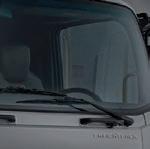





It’s part of our DNA.








From day one, we support customers and demonstrate that reliability is everything. We pride ourselves on being proactive and always going the extra mile.

And as we look to new frontiers, we’re finding new ways to help our customers exceed their goals.











Isuzu Care is what sets us apart. Always has, always will.




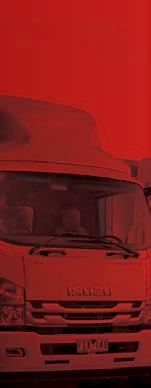
























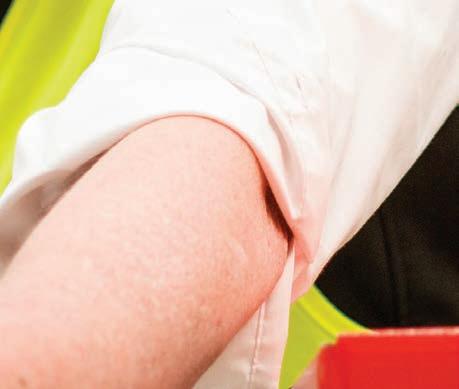






























































































FSA/ISZS1660
MEET THE TEAM
Christine Clancy | COO

With more than two decades of experience as a media professional, Christine has worked in newsrooms across Canada, Vietnam and Australia. She joined the Prime Creative Media team 12 years ago, and today oversees more than 43 titles, including a dozen print and digital transportation titles. She continues to lead a team that focuses on continuous improvement to deliver quality insights that helps the commercial road transport industry grow.
William Craske | Editor
Over the past two decades William has published widely on transport, logistics, politics, agriculture, cinema, music and sports
He has held senior positions in marketing and publicity for multinational businesses in the entertainment industry and is the author of two plays and a book on Australian film history. Like many based in Melbourne he is in a prolonged transition of either returning or leaving.
Peter Shields | Senior Feature Writer
A seasoned transport industry professional, Peter has spent more than a decade in the media industry. Starting out as a heavy vehicle mechanic, he managed a fuel tanker fleet and held a range of senior marketing and management positions in the oil and chemicals industry before becoming a nationally acclaimed transport journalist.
Louise Surette | Journalist

Louise joins Prime Mover after nearly 25 years as a writer. Starting her career as a reporter at the Toronto Star, she has spent much of the last 15 years as a design writer and editor. In 2020, she was shortlisted on the Richell Emerging Writers Prize list. Originally from Nova Scotia, she lives in Melbourne with her two children.
Peter White | Journalist
Peter has completed a Bachelor of Media and Communication (Media Industries) degree at La Trobe University, and he brings a fresh perspective to Prime Mover. He gained valuable experience at Upstart, La Trobe’s newsroom, work that has been supplemented by direct industry experience in a Council placement.
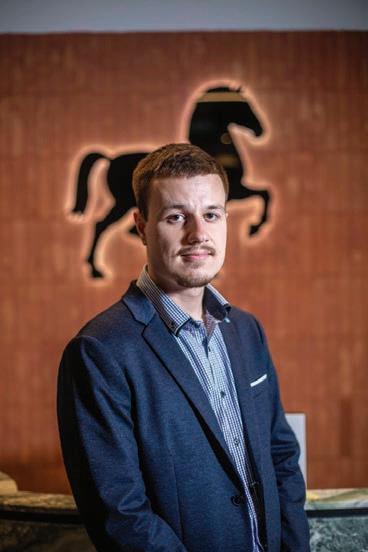



Peter has a strong interest in commercial road transport, and in contributing to Prime Mover’s efforts in growing the industry.

Ashley Blachford | Business Development Manager
Australia’s leading truck magazine, Prime Mover, continues to invest more in its products and showcases a deep pool of editorial talent with a unique mix of experience and knowledge. www.primemovermag.com.au

Handling placements for Prime Mover magazine, Ashley has a unique perspective on the world of truck building both domestically and internationally. Focused on delivering the best results for advertisers, Ashley works closely with the editorial team to ensure the best integration of brand messaging across both print and digital platforms.
ceo John Murphy john.murphy@primecreative.com.au editor William Craske william.craske@primecreative.com.au managing editor, Luke Applebee transport group luke.applebee@primecreative.com.au senior feature Peter Shields writer peter.shields@primecreative.com.au
business Ashley Blachford development ashley.blachford@primecreative.com.au manager 0425 699 819
art director
Blake Storey blake.storey@primecreative.com.au
design Kerry Pert , Louis Romero, Tom Anderson
journalists
Peter White peter.white@primecreative.com.au
Louise Surette louise.surette@primecreative.com.au
design production
Michelle Weston manager michelle.weston@primecreative.com.au
client success Salma Kennedy manager salma.kennedy@primecreative.com.au
head office 379 Docklands Drive, Docklands VIC 3008 enquiries@primecreative.com.au
subscriptions 03 9690 8766 subscriptions@primecreative.com.au
Prime Mover magazine is available by subscription from the publisher. The right of refusal is reserved by the publisher. Annual rates: AUS $110.00 (inc GST). For overseas subscriptions, airmail postage should be added to the subscription rate.
articles
All articles submitted for publication become the property of the publisher. The Editor reserves the right to adjust any article to conform with the magazine format.
copyright
PRIME MOVER magazine is owned and published by Prime Creative Media. All material in PRIME MOVER magazine is copyright and no part may be reproduced or copied in any form or by any means (graphic, electronic or mechanical including information and retrieval systems) without written permission of the publisher. The Editor welcomes contributions but reserves the right to accept or reject any material.
While every effort has been made to ensure the accuracy of information
Prime Creative Media will not accept responsibility for errors or omissions or for any consequences arising from reliance on information published. The opinions expressed in PRIME MOVER magazine are not necessarily the opinions of, or endorsed by the publisher unless otherwise stated.
Waverley Forklifts Pole Position Delivery Magazine inside: Pages 78-89. SEPTEMBER 2023 primemovermag.com.au ® September 2023 THE PEOPLE & PRODUCTS THAT MAKE TRANSPORT MOVE Carrier: ColdRex Logistics Spotlight: Local Mix Showcase: Heavy Vehicle Insurance Personality Profile: Lauren Pulitano Fleet: Shaw’s Darwin Transport Linehaul: AJM Transport Test Drive: Fuso Shogun 510 tipper Delivery: FedEx
THE POWER OF PROVEN TECHNOLOGY.
THAT’S ANOTHER HINO
HINO QUALITY MEETS TOYOTA TECHNOLOGY.

The Hino 300 Series Hybrid Electric utilises a parallel diesel electric hybrid driveline design, powered by Toyota Group technology proven in over 15 million hybrid vehicles worldwide. With maximum torque generated at low rpm, real-world tests prove up to 20%* fuel savings and emissions reductions. Leading the way with low-emissions, there are no recharge requirements or range limitations. Fully backed by Hino Advantage, giving you more support and solutions for the long run. That’s the power of change, that’s the Hino Hybrid Electric. Visit hino.com.au

XAVIER_HINO38956.17
Actual results will vary depending on the application of the vehicle and how it is driven.
COVER STORY

“We’re a pretty tight family-style operation where we take great pride in looking after our staff and I think that gives us a better shot of recruiting and retaining the right people.”


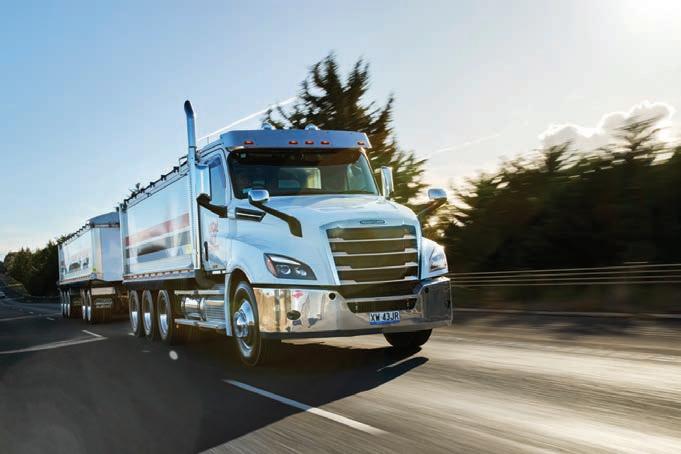


CONTENTS Prime Mover September 2023 38 32 50
54 70
FLEET FOCUS
32 Pole Position
Transporting forklifts is a specialty task that Victorian company Waverley Forklifts, now in its 50th year, performs exceedingly well for its customers.
38 Top of the World
Fleets like Shaw’s Darwin Transport, which relies on Cummins and Meritor, are getting the best of both worlds, following the merger of the two companies.
42 Prime Time
As AJM Transport approaches its 20-year milestone, Managing Director, Anthony Mansell, is continuing a tradition he started two decades ago with the purchase of his first truck, a Kenworth T401.
TRUCK & TECH
50 Dare to be Different
Once disparagingly referred to as “silly wheels”, an air suspended lift-up axle is playing an important part in Local Mix’s latest PBS truck and dog combination.
A return to the waste industry in the midst of the COVID pandemic was a major success for Ben Harris and Suzanne Magro, who together built Adelaide Liquid Waste Solutions from the ground up.
TEST DRIVE
70 The Power of One
The Fuso Shogun 510 has been a success in a number of guises and now a tipper showcases the capabilities of Australia’s most powerful Japanese truck.



Regular Run 08 From the Editor 10 Prime Mover News 30 Mindset 66 Heavy Vehicle Insurance Showcase 74 Personality Profile 76 Prime Movers & Shakers 78 Delivery 90 ARTSA-I Life Members 92 Truck Industry Council 93 Victorian Transport Association 94 Peter Shields’ Number Crunch
Prime Feature STORIES HIRE LEARNING 58
William Craske Editor

Those familiar with these pages will have read the occasional glowing reference for the 1977 movie Sorcerer, in which a group of mercenaries agree to drive trucks loaded with nitro-glycerine over a mountain in the South American jungle. That movie’s director, William Friedkin, sadly left this mortal coil in August, and with it a memorable body of work that, aside for its sheer entertainment value, resonates with the tensions unleashed by the forced march of modernity and the old souls ensnared by its advancement. There is an exhilaration concomitant to seeing vehicles pitted, in desperation, against the least cooperative of environments. Ask any diesel mechanic. Friedkin also understood it, much to the pleasure of his audience.
Sometimes this would take form as a heart-stopping race against time, and, when at his best, manifest itself in wild chase sequences, the likes of which had never been attempted before. Even the most casual moviegoer has a shortlist of their favourite movie car chases. Friedkin’s 1974 The French Connection, with good reason, is usually among them. The sequence, in
Cut to the Chase

question, begins outrageously enough with Gene Hackman’s New York cop, commandeering a civilian car to pursue a subway train, upon which a criminal has escaped, on an elevated track. The chase through Brooklyn goes for 26 blocks. That it was shot without proper city permits only adds to the tension. Just over a decade later, Friedkin would perhaps top this feat in To Live and Die in LA (1985). In the film two secret service agents, played by William Peterson and John Pankow, nearly blow their cover during a botched deal involving the death of a federal agent, who, to their immediate despair, is under surveillance. What ensues is an audacious chase on the highways, railways and flood channels of Los Angeles with one particularly heightened section, in which, the vehicle being pursued drives against oncoming freeway traffic at breakneck speed.
The idea came to Friedkin in 1963 when he was driving home from a wedding in Chicago. According to the story, he fell asleep at the wheel and woke up in the wrong lane with oncoming traffic heading straight for him as he recalled it. He swerved back to his side of the road and for the next 20 years wondered how he was going to use it in a film. Stunt coordinator Buddy Joe Hooker was made aware that if they could come up with a chase better than the one in The French Connection then it would make it into the film. It’s safe to say they did but it’s about the only safe thing about it. Another decade would pass before Friedkin would attempt a car chase on this scale. Upon reflection, even a potboiler like Jade (1995) works best when viewed as a car chase from which a dodgy erotic thriller somehow mutated.
This time working with the scarped surroundings of San Francisco, home of many a fabled movie car chase, Friedkin, like the conductor of a symphony orchestra using a Ford Thunderbird and a Taurus as if they were musical instruments, seemingly attempts to outdo Bullitt, the previous benchmark for sequences of this nature in the same city, only this time, to complicate matters further, by running the hot pursuit through an obstacle of congested traffic. Indeed, the phrase cutting to the chase, which is to say getting down to the essentials, in the case of Jade is at once figurative and literal.
The signature ability to choreograph impossibly tense scenarios and shoot a sequence, often precariously, around it, is part of the Friedkin adrenalin rush. What makes the effect so visceral? The question boils down to a sense the filmmaker, like many of the heroes featured in his movies, is trying to master events beyond his control medias res and given the ordeal at hand perhaps has no right to do so. That’s bound to be of interest to anyone who makes a living working against centrifugal forces whether it be pit crews or fleet managers.
“No man can be blamed for being ill-favoured by nature; but every man can be blamed for making the worst of himself,” notes the physician and essayist Theodore Dalrymple. Friedkin, it might be said, was hellbent on dramatising that conflict and carried it closer to fulfillment better than almost anyone.
8 September 2023
FOR DRIVERS... THERE’S ONLY ONE CHOICE


We’re not all made the same and neither is a Kenworth. With a huge range of options, a Kenworth can be customised for the driver and the task at hand. Drive something to be proud of; “a truck that’s uniquely yours”.


kenworth.com.au
UNIQUELY
> Ausway Transport introduces first of 14 B-triples
encompass 12 full combinations with provision for 14 B-triples in total once the remaining units are certified. “Smedley’s completed the Performance-Based Standards set up for us,” said Sooch. “Jackson Heil has been our Account Manager and he was really good to deal with. He has a lot of knowledge.”
Sooch added, “It’s exciting and we’re really happy to see this transition in the business, once these all roll out, we’ll go into the next phase.”
The project, according to Sooch, had been underway for 12 months in total including conception, procurement and engagement with Smedley’s through to completion. The K200 big cab is hard to miss especially at night with its lights, side markers and glow-in-the dark antennae.
Victorian linehaul specialist, Ausway Transport, has unveiled its first PBSapproved B-triple combination. The high productivity freight vehicle is running Melbourne to Adelaide, return, pulled by a 600hp Cummins-powered Kenworth K200.
The B-triple allows Ausway, who often carries parcels for the likes of StarTrack and Australia Post, to increase their volume given mass isn’t the primary factor. The combination comes in under 68.5 tonnes when loaded and crucially contains more pallet space than an A-double.


Most of the fleet’s latest dedicated lead trailers, which are manufactured by Vawdrey, are roadtrain-rated and engineered to be interchangeable as a middle trailer with the inclusion of a wiring harness connection. This move ensures Ausway Transport is now EBS compliant across its entire fleet. By the end of winter, Ausway expects to have eight new lead trailers from Vawdrey in their possession. With things tracking as planned, another four B-triples will go online for the fleet
by September.
The extra articulation point of the B-triple has proven beneficial in areas of handling according to Bobby Sooch, Ausway Transport Managing Director.
“It doesn’t rumble as much down the road as a roadtrain because of the dolly,” he said. “Even road-users are more friendly around triples compared to roadtrains. The drawbar on the dolly scares a lot of people on a roadtrain.” Manoeuvrability is superior to a roadtrain, not to mention safer, according to Sooch, who expects to preference more B-triples than roadtrain combinations going forward. Sooch had initially considered running a Tautliner pan combination before it became evident the B-triple would better suit Ausway’s needs.
“Initially we wanted to have a lead pan and drop deck B-double behind it but the measurements on the turntable proved challenging with the actual turntable being welded to the rollback trailers,” he explained.
Smedley’s Engineers is handling the PBS approval process which will
“The extra lights on the triples assist when entering some narrow single carriage roads and helps to signal oncoming traffic when approaching a much larger vehicle especially on dark nights,” said Sooch.
“With the lights on top we’ve found you can judge it from further away given the greater visibility they have. I think the lights should be compulsory on the top and bottom of prime movers,” he said.
The antennas are red facing backwards and amber facing forwards, making them ADR compliant, giving these distinctive glowstick-like accessories a two-in-one validation.
The second B-triple also launched by Ausway will be pulled by a Volvo FH16 XL 700hp.
“The initial plan is to do two daily into Brisbane which will bring the fleet up to eight B-triples,” said Sooch. “Then two into Adelaide, followed up by another two into Sydney. As the numbers grow, we will split the fleet into more triples.” This week Ausway Transport has also taken delivery of four new Kenworth K200s featuring the same powertrain for these interstate high productivity freight movements.
PRIME NEWS 10 September 2023 PRIME NEWS
Kenworth K200 B-triple in action.
Highly flexible All-electric
The flexible and agile Volvo FM Electric. Lower sound and emissions. Excellent ergonomics and visibility. Designed for high-capacity grocery deliveries, container transports, refuse pickups and more within metropolitan areas. To simplify the transition to electromobility, the truck is offered together with solutions for charging, route and range planning and energy status.

Driving Progress
Volvo Trucks.
> Australia Post welcomes significant A-double-rated Volvo order

A sizeable order of new Volvo prime movers have just arrived at Australia Post. The order consists of numerous Volvo FM500 and Euro 6-rated Volvo FH13 540 units, which this week were being prepared ahead of service deployment over the coming weeks. The new prime movers are to go into operations for the national parcel and postage carrier at destinations all over the country. While the Volvo FMs have been earmarked for Australia Post’s intrastate legs, the FHs, with their bigger cabin, will perform linehaul duties Prime Mover has learned.
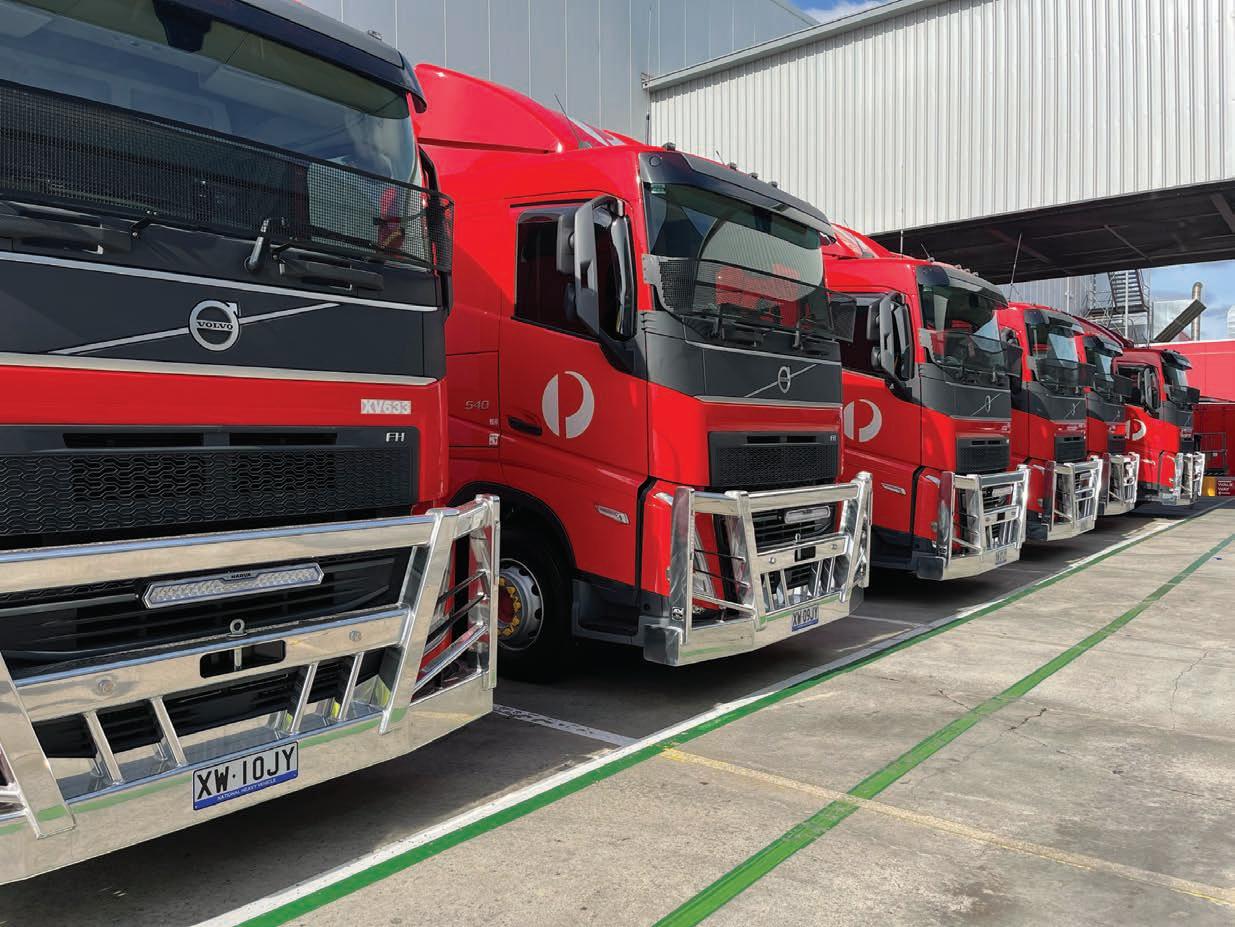
Many of the trailers being towed have been built by Vawdrey, a longterm partner of Australia Post. The
trailers are fitted with BPW disc brakes axles, WABCO ABS braking and roll stability, HELLA lighting, Razor electric landing legs and Attards loadrestraint curtains. Disk brakes have also been fitted on the 17-inch wheels. The new trucks are all A-double capable with more builds currently underway with Vawdrey. Australia Post recently moved to a locally built ACM bullbar. According to a spokesperson, the factory bars were good but after an animal strike, they can get damaged. Locally made in Victoria, the ACM bar, which is now fitted across the fleet of new prime movers, is considered more robust.
The new Volvos also feature the latest generation 24-inch Narva Ultima light bar for greater nighttime visibility. It’s the result of close collaboration between the two companies. Australia Post helped with much of the development work, installing some preproduction samples to gauge how they would compare to the previous model. The light bars are reportedly around 30 per cent brighter than the previous version and weigh less. All future prime movers will have these fitted from the factory. The safety of the drivers, according to the Australian Post spokesperson, is the key driver behind the purchase of the vehicles and the accessories which have been fitted.
PRIME NEWS PRIME NEWS 12 September 2023
JOB
A selection of the newly arrived Volvo FM500s in Melbourne.
JOB DONE
MASTER OF ALL TRADES
Trust is earned, not given. Fuso has spent 50 years in Australia forging a reputation as a leading brand you can count on. We’ve helped businesses build successful futures with durable trucks built by the world’s largest truck manufacturer, Daimler Truck. What’s more, our entire reliable range comes with a 5 year warranty,* plus the option of fast track finance with guaranteed future values. No matter the job, there’s a Fuso truck to get it done.

FOR MORE ON THE FUSO TRUCK RANGE VISIT FUSO.COM.AU
*T&Cs apply. See fuso.com.au/warranty

FUSO TRUCK RANGE
THE
> KS Easter welcomes new roadtrain-rated Volvos
Brisbane-based freight carrier, KS Easter, has taken delivery of 16 Volvo FH16 prime movers. These roadtrainrated 600 horsepower Globetrotters are part of an order comprising around 20
KS Easter, which operates 40 Volvos in its fleet, recently launched four A-doubles running interstate between Melbourne and Sydney, return daily, that these new prime movers have been
A-trailers, have low maintenance nongreasable fifth wheels.
KS Easter Managing Director Ken Easter described the Volvo product as consistent, honest and reliable.
“It’s a known quantity to us. We’ve had enough of them in the fleet,” he told Prime Mover. “We’re happy with the fuel. Out of the box, they’re the best thing we buy.”
The Euro 5 powertrain offers up to 3150 Nm of pure torque and the I-Shift transmission with crawler gears facilitates strong pickup response especially when moving goods in the higher echelons of heavy mass.
“For liftoff it provides a bit of ease on the clutch if they have a reasonable amount of weight on them,” said Easter. “It’s good to have the extra crawler gears just in case.”
The Volvos will also be designated some B-triple work once it becomes more consistent.
The KS Easter fleet now runs, after replacement programs, just over 100 prime movers and 290 trailers. Earlier in the year, KS Easter in partnership with StarTrack, deployed its first A-double high productivity vehicle out of StarTrack facility in Sydney.

> Followmont Transport dedicates Kenworth to driver’s son
Gary Sanderson, a Followmont Transport pick-up and delivery driver, has completed his first delivery with a Kenworth K200 dedicated to his son. The Kenworth, named ‘Lachy’ after Sanderson’s son, Lachlan, joined the fleet in 2018 and was unveiled in a private showing for the Sanderson family.
The unit is now part of Followmont’s linehaul fleet, travelling up and down the east coast every day. Since its purchase, it has clocked up almost 1.5 million kilometres.
Sanderson told Prime Mover the Kenworth means everything to him. “My son has a rare genetic syndrome, so in 14 years of his life he’s had 30-
odd operations,” he said. “By having the truck named after him, it showed me that the company valued myself and took a special interest in my son. It made me feel so proud.”
Not long ago Sanderson completed his first delivery with ‘Lachy’.
“Because it’s a linehaul prime mover, I don’t get to use it all the time,” he said.
“I hadn’t driven it up until now. Our CEO, Mark Tobin, has been absolutely fantastic towards my family. The support that he’s given us over the years has just been amazing. It’s a great company to work for.”
Tobin told Prime Mover the truck was a gesture to let Lachlan and the
Sandersons know that he and the Followmont Transport team were all behind them.
“When a member from our operations team told us about the difficulties that Gary and his family were facing, we just wanted to do something to put a smile on their faces,” he said. “Lachy is an incredibly resilient kid, and I felt so humbled to see how much joy this small gesture brought to him and his dad.
“Gary is a valued member of the Followmont family, he is an amazing driver, team player and all-round genuine bloke. His customers and team love working with him as he embodies our company values.”
PRIME NEWS PRIME NEWS 14 September 2023
Volvo FH16 A-double.

This information is general advice only and does not take into account your objectives, financial situations or needs. You should obtain and consider the relevant Product Disclosure Statement and Policy Wording (as applicable) from zurich.com.au before making a decision. A target market determination is available at zurich.com.au/GI-TMDs or by calling us on 132 687. The issuer of general insurance products is Zurich Australian Insurance Limited (ZAIL), ABN 13 000 296 640, AFS Licence Number 232507 of 118 Mount Street, North Sydney NSW 2060. ZU233775 V4 12/22 LEWG-019393-2022 Much more than truck insurance. Zurich seeks to improve safety in the trucking industry through its fleet risk management services. We work closely with customers on request and aim to optimise business processes and driver behaviour. This can help to reduce claims, keeping trucks on the road. Ask your broker about Zurich today.
> Brown and Hurley to begin search for new CEO
Brown and Hurley Chief Executive Officer, Paul Hurley is set to retire. The retirement, Prime Mover has learned, will be effective by the end of the 2024 calendar year. Hurley, who was appointed CEO in July 2018, is highly regarded internally having significantly contributed to the company’s extensive growth across the truck and trailer category of the business and also in the agricultural machinery segment. The company currently has a presence in 21 locations in Queensland and Northern NSW with over 600 staff. It is expected Hurley, who is a thirdgeneration family member, will take up a director’s role on the Brown and Hurley board, joining Rob Brown, Jim, Kev and Doug Hurley and John Casey.

“The company’s board has decided to explore all options in finding a CEO to take over Paul’s role,” a Brown and Hurley spokesperson told Prime
Mover. “Recruitment for the position will commence shortly, with the aim of having the new CEO in place mid-2024 to allow a seamless transition to the new CEO.”
The company, which has been in business for 77 years, is, at present, evenly split in its ownership by the Brown family and the Hurley family. With a healthy order book deep into 2025, the company has several new facilities in the planning stages to replace existing facilities that have outgrown their current sites.
“The board is committed to the company maintaining its business philosophy, work culture, financial position and customer service to the highest standard, and will be seeking a CEO to maintain and enhance that,” a Brown and Hurley spokesperson said. Further updates will be provided as they come to hand.
> Toll launches new A-double for Primary Connect
roads,” a Toll spokesperson told Prime Mover. “The trailers track extremely well considering the length of the combination and this is also helped by the Knorr-Bremse suspension system. It takes up considerably less space when cornering than first thought. The truck pulls the combination easily and is a comfortable ride.”
dedicated to servicing Primary Connect, the supply chain arm of Woolworths. The combination, which is pulled by a Mercedes-Benz Actros 2658, will be operating primarily between new distribution centres in Wyong and Kemps Creek in New South Wales.
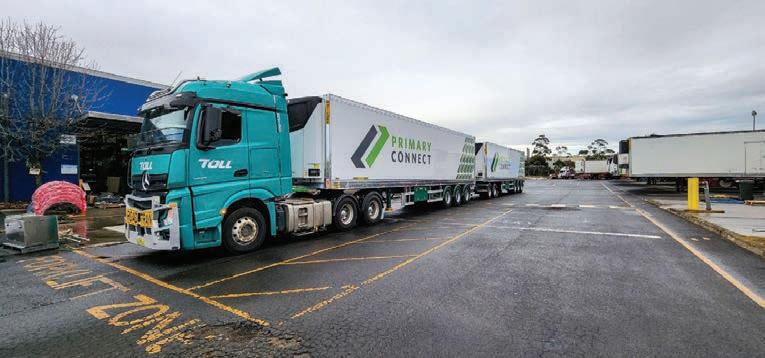

Toll expects the high productivity vehicle will travel up to 12,000km a week. The Euro 6 Mercedes-Benz Actros prime mover is powered by a 580hp engine offering a maximum of 2800Nm of torque. It also features lane departure assist, proximity control assist, Active Brake Assist 5, Stability Control Assist and Attention Assist. The Active Brake Assist
emergency situations. The truck is operating with the Seeing Machines Gen 1 Guardian DSS Fatigue and Distraction Monitoring Systems, Teletrac Navman telematics, which has the ability to operate an electronic work diary and on-board scales that are connected to the Knorr-Bremse suspension on the trailers.
MaxiTRANS designed and built the trailers while the roadtrain dollies come from Krueger.
The combination falls under PBS Level 2, and is approved to 79.5 tonne.
“The A-double handles exceptionally well both on the highway and on suburban
The Mercedes-Benz Actros 2658 haș often been deployed on B-double combinations for the fleet in the past. Manoeuvrability, at least after an initial assessment, has proven exceptional in negotiating corners and roundabouts. Toll is eager, once it collates more data, to appraise its performance pulling a fully loaded A-double as it pursues cost effective transport solutions for its customers.
“High productivity vehicles will assist our customer in a more efficient way and will help to reduce our carbon footprint on the environment leading to a more sustainable logistics solution,” said the Toll spokesperson.
PRIME NEWS PRIME NEWS 16 September 2023
Paul Hurley.
Mercedes-Benz Actros 2658 A-double.
No matter how hard the job, UD is paving the way in reliability.
As a full service civil construction company, our fleet of ten UD Trucks work in a wide range of challenging applications, and they always stand up to the test. What matters to us most is reliability, driver safety, versatility, driver comfort, and good fuel consumption. We trust UD to deliver maximum uptime and they never let us down.
 Patrick O’Sullivan Managing Director, Prestige Civil Group, Victoria
Patrick O’Sullivan Managing Director, Prestige Civil Group, Victoria
Going the Extra Mile
To find out more, contact your UD Trucks dealer on 1300 BUY A UD or visit udtrucks.com/australia
> Auswide Transport Solutions orders 20 Kenworths
The first two Kenworth Legend SARs have joined the fleet at Auswide Transport Solutions as part of a huge order. These trucks will be allocated to one of Auswide’s premium customers on the east coast where they will run round trips Melbourne to Sydney, with permanent drivers allocated.
The new prime movers join Auswide’s 95-per-cent Kenworth fleet consisting of T909s, Legends and K200s. Auswide Transport Solutions General Manager, Gabby Singh, told Prime Mover Kenworth is one of the most reliable and robust brands across the industry and are well suited to the Australian environment when running linehaul.
“They’re very sought after trucks — drivers feel pride driving these iconic trucks around,” he said. “The support of Nick Gesovski from Kenworth DAF of Melbourne is first class and consistent with the brand, while the Cummins aftersales support adds to our
confidence in Kenworth.
“Having booked Kenworths a while ago, we have seen a number start to enter our fleet and are excited to receive these two Legends being production numbers 310 and 311.”
According to Singh, there are also another 18 Kenworths to come.
“Investing back into and strengthening Australian businesses is central to our corporate philosophy,” he said.
Like all of the fleet’s units, they will come standard with air-conditioning units. The team at Auswide, though, have taken it a step further by having custom air and ice packs installed pre-delivery. Singh said this will give great assurance to fatigue management protocols as it will ensure drivers are well-rested on their trips away from home.
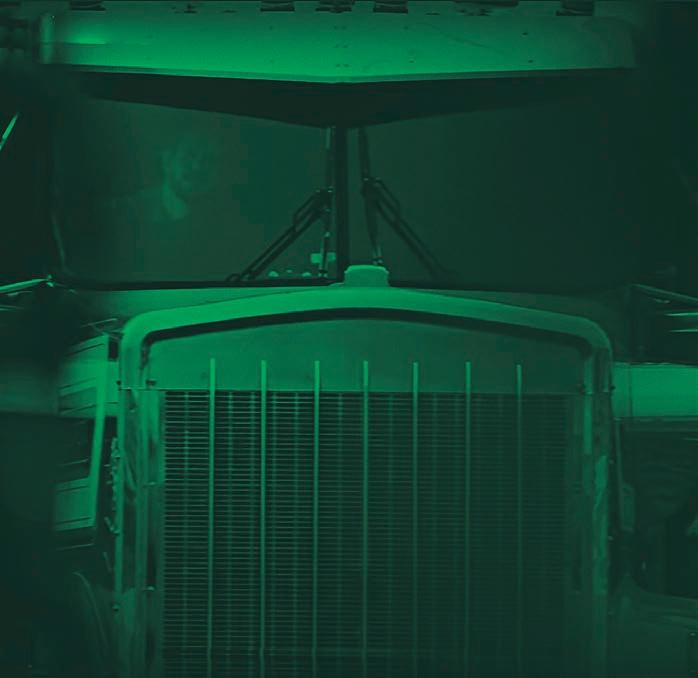
“The Australian environment can become hot running between Adelaide and Perth, and we make every effort to support proper fatigue management by
providing a good level of comfort for our drivers,” he said.
National Compliance Manager, Jeff Wright, told Prime Mover that the safety of its drivers and customers is the fleet’s primary focus.
“Our priority is to ensure our drivers are well looked after through our ‘customer first’ approach,” he said. “A first-class safety environment within the organisation assists not only with attracting drivers but keeping them as well. Making sure they’re safe, and getting them back to their families, is really important to us.”
CEO, Tom Pausic said attracting, engaging and retaining customers while increasing quality drivers is supported by the new Kenworth fleet.
“There are very few drivers who won’t put their hand up for it, so that’s helped us attract professional drivers and gives the fleet a very professional image,” he said.
> Mineral Resources to launch 120 autonomous roadtrains in world-first
Mineral Resources (MinRes) will deploy a fleet of 120 fully autonomous roadtrains equipped with an autonomous haulage solution in Western Australia under a landmark agreement. The world’s first fully autonomous roadtrains have been designed and developed for MinRes’ flagship Onslow Iron project in WA. A team of operators will control the fleet from a central operating centre in Onslow. MinRes is also developing an artificial intelligence-powered monitoring system.
Each triple-trailer vehicle will carry 330 tonnes of iron ore about 150km on a dedicated private haul road from the Ken’s Bore mine site to the Port of Ashburton. Ore will be transported to a 220,000-tonne enclosed, negative pressure storage facility at the port.
“We’re excited to cement our partnership with Hexagon to deliver the world’s first fleet of autonomous roadtrains, which will be an essential
part of Onslow Iron’s safe, efficient and dust-free solution for hauling ore,” said MinRes Chief Executive, Mining Services, Mike Grey. “Automation will remove the risk of driver fatigue, lower operating costs and reduce fuel use and emissions. There’s enormous potential for these vehicles to transform mining across the world.”
The vehicles, combining technology provided from Hexagon AB’s Autonomous Solutions with MinRes’ operational knowledge, are promising enormous benefits.
According to MinRes, they will remove the risk of driver fatigue, increase fleet availability, lower operating costs and reduce fuel use and emissions.

“Autonomous roadtrains form an essential part of the cost-effective and dust-free supply chain that will unlock deposits in the West Pilbara that would otherwise remain undeveloped,” a MinRes spokesperson said.
Safety is at the forefront of the
project’s design — grade separation will ensure there is no interaction between the autonomous roadtrains operating on the haul road and vehicles using public roads.
Testing of autonomous roadtrains has been progressing at MinRes’ Yilgarn iron ore operations since late 2021 ahead of the technology’s deployment at Onslow Iron.
The project, which is the cornerstone of MinRes’ strategy to deliver low-cost, long-life iron ore operations, will ship about 35 million tonnes of iron ore per year from mid-2024.
“At Hexagon, we see autonomy as a way to vastly improve our world,” said Hexagon President and CEO, Paolo Guglielmini. “[The] agreement with MinRes will ensure that transport activities will be safer, more sustainable, and more productive.
“I’m excited to see how similar solutions can be applied in other markets such as agriculture and heavy industry.”
PRIME NEWS PRIME NEWS 18 September 2023


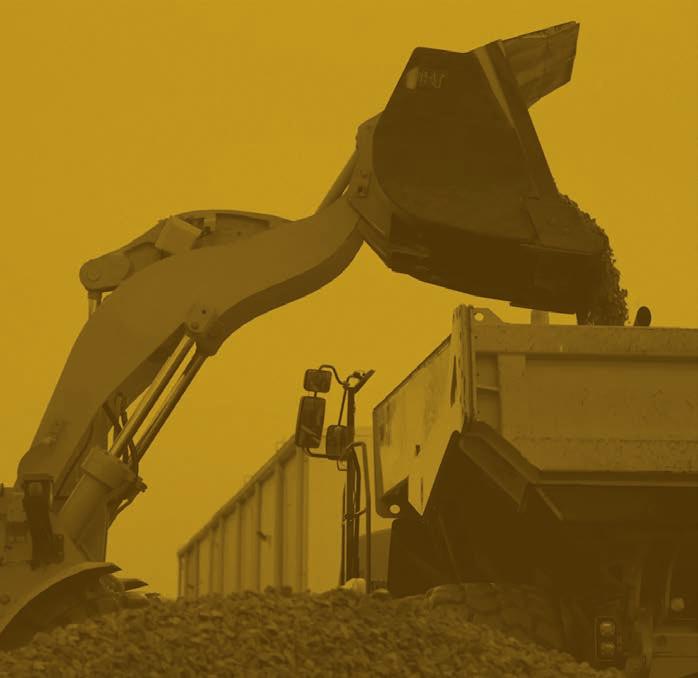

At NTI we’ve always been successful in finding new ways to keep our customers truckin’, shippin’ and diggin’. With specialist insurance and roadside assistance products designed to protect Australian businesses and families, NTI is the specialist our customers can count on in their time of need. Insurance products are provided by National Transport Insurance, a joint venture of the insurers Insurance Australia Limited trading as CGU Insurance ABN 11 000 016 722 AFSL 227681 and AAI Limited trading as Vero Insurance ABN 48 005 297 807 AFSL 230859 each holding 50% share. National Transport Insurance is administered on behalf of the insurers by its manager NTI Limited ABN 84 000 746 109 AFSL 237246. NTI.M197.1.062023
> Simon National Carriers recognised with ASP certification

Transport Certification Australia (TCA) has certified Simon National Carriers to be an Application Service Provider (ASP) through the National Telematics Framework (NTF).
Transport operators like Simon National Carriers, who have invested in their own telematics systems, can obtain TCA certification so they can participate in NTF applications and schemes by using technologies already used in their vehicles.
Having obtained certification, Simon National Carriers can provide telematics applications up to Level 2 Assurance, including the Telematics
Monitoring Application (TMA) and Road Infrastructure Management (RIM) applications of the NTF, for its own vehicles.

According to Simon National Carriers CEO, David Simon, the move to have the fleet’s telematics system certified by TCA allows the company’s Performance-Based Standard (PBS) drivers to meet TMA and Smart On-Board Mass (OBM) system requirements on the routes they travel between Brisbane and Melbourne. “Our fleet comprises PBS combinations, including A-doubles, that require enrolment in TMA and
> Silk Logistics to acquire Secon Freight Logistics







Silk Logistics Holdings has entered into a binding agreement to acquire Secon Freight Logistics it recently announced. The acquisition is subject to conditions precedent customary for a transaction of this nature.
Silk’s CEO Brendan Boyd said the acquisition of Secon added immediate scale to Silk’s Victorian footprint, consistent with its strategy as an integrated ‘port-to-door’ provider. “Further, this acquisition provides Silk with a significant platform in national bulk logistics, unlocking demand from our existing blue chip customer base as well as other potential cross-selling opportunities,” said Boyd in a prepared statement.
Secon generates annual revenue of over $65 million as well as strong margins and operating cashflow.
The acquisition is expected to contribute positively to Silk’s group earnings immediately and be over 10 per cent earnings per share accretive in the first full year of ownership, before accounting for any potential synergies and integration costs.




Secon is a freight industry leader with loyal and long-standing clients and a reputation for service excellence.



The company, now in its 53rd year of operations, handles a prodigious variety of goods for the retail, FMCG, light industrial, bulk plastics, food and dairy industries, moving containers from the port in Melbourne to sites nearby.

The acquisition increases Silk’s prominence in Victorian port logistics, offers a complementary bulk logistics platform, along with a value-add fumigation offering.
Smart OBM systems to conform with road access conditions,” he said. “We decided it was time to have our existing telematics system recognised by TCA, rather than fit yet another system in our vehicles.”
TCA General Manager Strategy and Delivery, Gavin Hill, congratulated Simon National Carriers on becoming a certified ASP and for delivering services for its own vehicles through the NTF. “It highlights how the NTF can accommodate transport operators who have made investments in their technology, which satisfy their specific needs,” he said.
The acquisition price consists of $30 million payable upfront in cash and $5 million in Silk shares.
The transaction is expected to complete on 30 September 2023, subject to the satisfaction of customary conditions including consents to change of control from major customers and landlords. A deferred earn-out payment (payable in cash) determined with reference to 5.0x normalised annual EBITDA achieved by Secon during each year in FY24 and FY25. The upfront cash price will be funded using Silk’s club acquisition facility with NAB and Rabobank. The share consideration is based on a 30-day VWAP prior to the execution date. The share consideration will be issued under Silk’s existing Listing Rule 7.1 capacity and will be held in escrow until 30 June 2024.

PRIME NEWS PRIME NEWS 20 September 2023
Isuzu Service Agreements really help take a load o .



























































































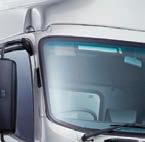


































































































The last thing anyone needs is an unexpected bill landing on their desk. But with an Isuzu Service Agreement, you can choose from three packages to fit your needs and flatten your servicing costs into a single, predictable, monthly payment. Plus, you’ll have the peace of mind knowing that you’re helping to meet your chain of responsibility requirements. And that all means a big load o your mind. To find out more, visit isuzu.com.au or see your nearest Isuzu Truck Dealer. Care. It’s what we do.










FSA/ISZS1663
> Matic lands largest Volvo ever produced at Wacol
to find better ways to service his customers, which in turn has allowed Matic Group to be at the forefront of providing innovative transport solutions,” said Kelly.
To celebrate its 20th anniversary, Matic Transport, has taken delivery of a new Volvo FH16 XXL 700hp prime mover. The twin-steer tri-drive truck is the largest Volvo to roll off the Wacol assembly line in Brisbane.
Matic Group operates a modern fleet of 200-plus trucks of predominantly Volvo prime movers along with over 750 pieces of trailing equipment.
“It was a proud moment for Danny and Katia to receive the keys for the first Wacol built FH16 XXL cab, twinsteer tri–drive”, Regional Commercial
Manager Anthony Raisch said. The new Volvo FH16 10×6 prime mover has a GCM of over 200t and will be transporting cement in pressurised tankers based out of Geraldton to remote mining sites around Western Australia.
Kevin Kelly, General Manager Volvo Sales at Truck Centre WA said the truck signifies 20 years of dedication on Danny Matic’s part. “Danny can be described as a man who has a genuine respect for all, has always had a dogmatic approach
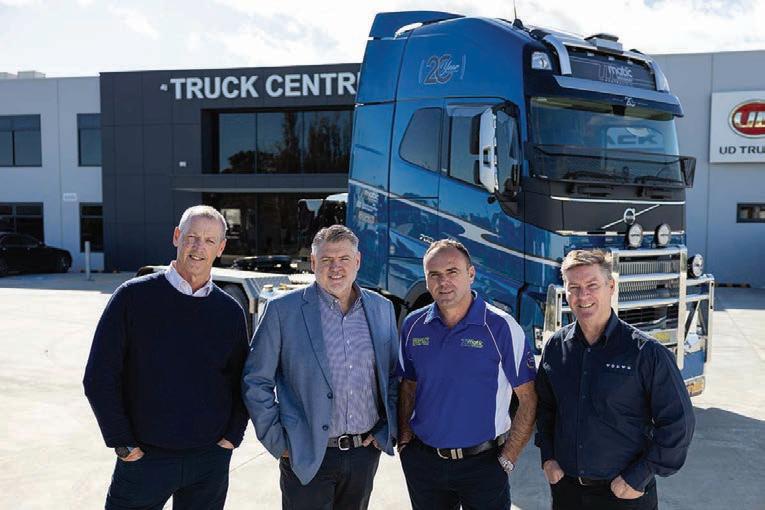
> New Mack tippers joining Alex Fraser Group
Alex Fraser Group has taken delivery of the first of three Mack Rigid 10×4 steel bodied tippers. The trucks have an increased load capacity to carry up to 20 tonnes of material and will maximise productivity and capability in Alex Fraser Group’s recycling team. This will enable the collection of demolition waste and cartage of Green Roads asphalt by its sister company, Suncoast Asphalt.
Alex Fraser Group Transport and Logistics Coordinator, Chris Fitzgerald was pleased to take delivery of the first truck.
“It’s been a long time coming, and it was great to see our first Mack twinsteer roll in,” he said. “There’s been a huge buzz as we’ve awaited its arrival, and we can’t wait to see our driver, Dale get behind the wheel.
“These trucks are larger, modern vehicles with a host of advanced features, including additional safety technologies, such as a flashing-talking left turn alert, blind spot detection and side under-run protection system to reduce the risks for the cyclists and pedestrians we share roads with.
“The blind spot detection uses radar










Matic, who continues to be driven by the dedication his team afforded the business, wanted a truck that had high GCM, high horsepower and a “big cab” for driver comfort. But it had to be safe for his driver Tony Watson. One of Matic’s company values is safety. The Matic Group was established in 2002 by Danny and Katia Matic and operates several business entities under the group umbrella. This includes Matic Transport Australia, Matic Resources and Bibra Lake Trailers with offices in Perth, Geraldton, Newman, Tom Price, Karratha, Darwin, Alice Springs and Adelaide.
It is a family owned, diversified transport and logistics company that specialises in servicing the resources, construction materials and oil and gas sectors.

The company invests heavily in safety resources and undertakes multiple campaigns to drive the safety culture across its entire operations.
Truck Centre WA has partnered with the company since its inception.
technology to constantly monitor the blind spot area of the vehicles.” Sales Manager, Nicole Bates, thanked the many people involved with the fleet expansion.
“There were a lot of people who helped make this happen,” she said. “Chris Fitzgerald did a wonderful job getting everything to align.
“We also sought out the expertise of Scott Barber at Hanson Australia, our Transport Manager Mario Tenaglia, Steve Helms at Mack Trucks Australia and Paul Gallagher from Borcat Trailers. Thanks to everyone involved.”
PRIME NEWS PRIME NEWS 22 September 2023
Ken Dowsen, TCWA CEO Brad Daff, Danny Matic and TCWA General Manager Sales, Kevin Kelly.












































































































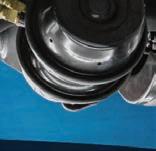





THE NEW D 190 FULL TIME PUMP HAS ARRIVED For more information contact Dana on 1300 00 DANA or visit us at www.Dana.com.au Strength • Power • Endurance ENGINEERED & BUILT IN AUSTRALIA
> Kenworth delivers new prime movers to Supercars
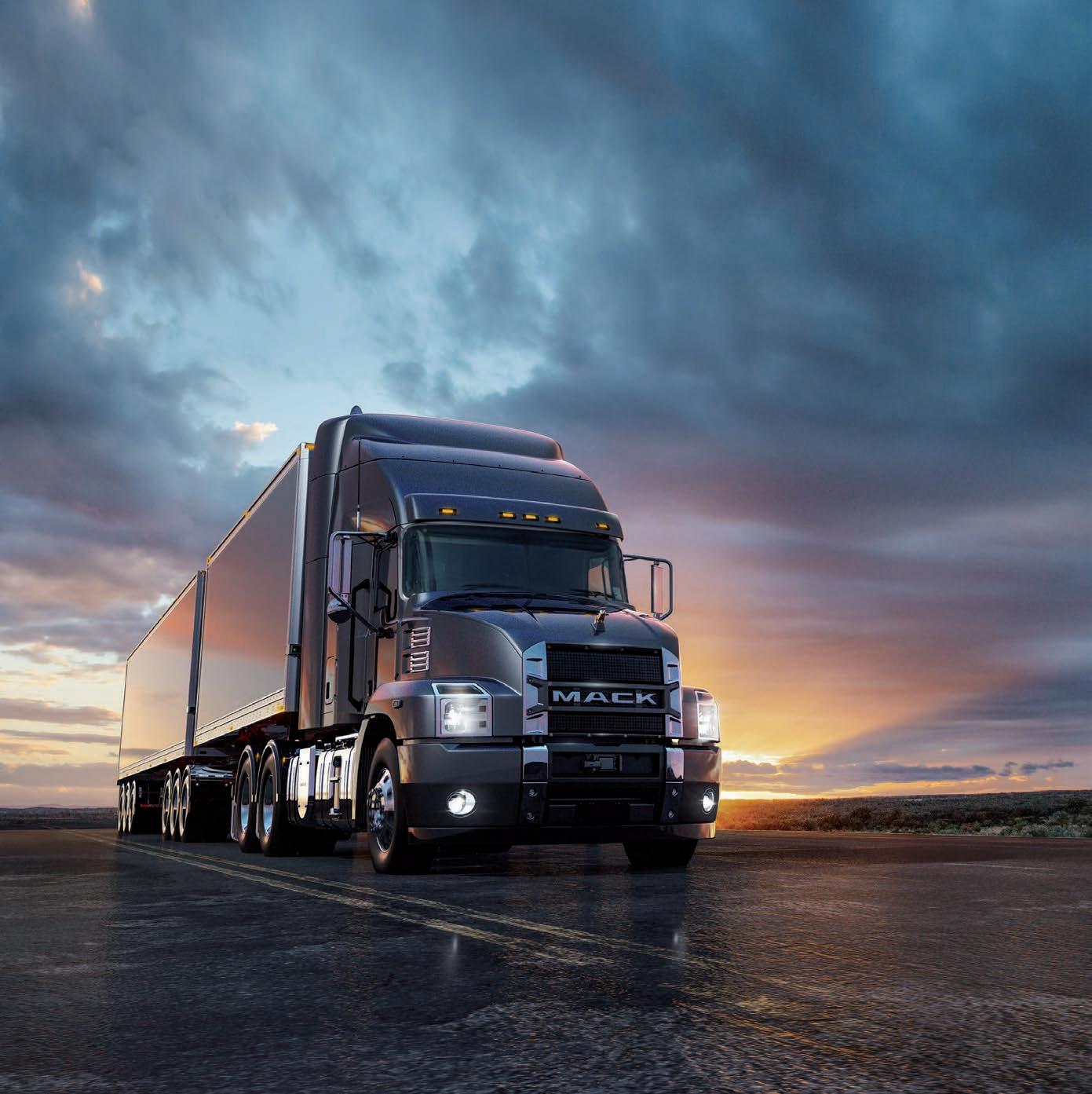
Kenworth will continue as the Official Heavy Duty Truck Partner of Supercars. The agreement extends until at least the end of 2025, making it the 26th consecutive year Kenworth is a partner of the category.
A new Kenworth T610 and K220 were delivered to Supercars on the Gold Coast to mark the occasion. Both prime movers feature a full suite of safety options, including adaptive cruise control, stationary vehicle braking, collision mitigation, driver alerts, lane departure warning, highway departure warning & braking, autonomous emergency braking (AEBS) & multi-lane autonomous emergency braking. As part of the longstanding partnership, Kenworth provides transportation
support to every Australian Supercars event — totalling more than 35,000 kilometres each season.
The two specialised trucks will serve critical functions during Supercars events. The T610 prime mover is powered by a Euro 6 Cummins X15 engine boasting next generation emission standards.
Kenworth has also retained the exclusive rights to the official Kenworth Drivers Parade at the iconic Repco Bathurst 1000.
Since its inception in 2006, this parade has become one of the most anticipated traditions of the fourday event.
“We are delighted to extend our partnership with Kenworth as
> Wide tyre impact results a cornerstone for change
The Truck Industry Council (TIC) and the National Heavy Vehicle Regulator (NHVR) have released the findings of the latest research project investigating the impacts of wide tyres.
Although wide single and ultrawide single tyres have been available for decades internationally, until now, TIC said, there has never been a substantial study focusing on Australian road construction – in particular sprayed seal unbound granular pavements.
According to TIC, this knowledge has always been a barrier to the adoption of next generation wider tyres in Australia. To address this, a large-scale testing program using the National Transport Research Organisation’s (NTRO) Accelerated Loading Facility was conducted.
Nine identically designed pavements were constructed, with each loaded repeatedly to determine the relative rate of pavement wear for each tyre. The results showed the pavement deformation rates for both the dual tyres and single tyres were within a similar range, and the 255/70R22.5 dual tyres caused the highest deformation rate.
The comparative pavement wear of super single tyres was not as sensitive to modest variations in inflation pressure, when compared to duals.
“Taking a real-world perspective on the comparatively small differences in pavement wear found, the pavement damage exhibited by the commonly used 11R22.5 dual tyre configuration was notably influenced by inflation pressure, with the highest damage observed when these tyres were over-inflated – a common occurrence in practice,” said TIC Technical Officer, Paul Caus. “In addition to the finding, day-to-day use of single tyres make it easier for drivers to check tyre conditions, monitor inflation pressures, and inspect brake components reducing the risk of overheating brakes and wheel end fires.”
In real world conditions, Caus said, it can be expected that the wider adoption of wide tyres would not cause a discernible increase in road pavement wear.
“TIC’s view is that there is no justification in limiting axle masses when using appropriate wide single tyres given the improved vehicle
the Official Heavy Duty Truck of Supercars,” said Shane Howard, Supercars CEO.
“Their unwavering support and dedication have been instrumental in the success of our events for over 20 years,“ he continued.
“We look forward to the next chapter of our partnership, delivering world-class experiences to our passionate fans.”
Michael Long, Director Sales and Marketing for PACCAR Australia said he was thrilled to be continuing the longstanding relationship with Supercars. “The partnership between the two organisations is into its third decade and continues to grow, creating excitement for everyone who’s involved.”
stability and efficiency they bring,” he said. “They should be permitted to operate at the same mass as equivalent dual tyred axles.”
The project, led by TIC, was funded by the NHVR’s Heavy Vehicle Safety Initiative and supported by the Australian Government.
NHVR Chief Safety and Productivity Officer, David Hourigan, welcomed the report’s findings.
“The findings of this report will be of great importance to equip road managers and the NHVR with the knowledge needed during consideration of vehicle load limits and the benefits provided by super single tyres,” he said.
According to Smedley’s Engineers Managing Director, Robert Smedley, this will become a cornerstone piece of research.
“It will lead to industry wide improvements in safety and environmental impacts of transport,” he said. “I’m proud to have been a contributor to this body of work that will have a positive impact for generations to come.”
PRIME NEWS PRIME NEWS 24 September 2023
60 YEARS. WE’RE IN IT FOR THE LONGHAUL. MAKE HISTORY WITH MACK
Mack started manufacturing in Australia back in 1963, and since then, we’ve gone from strength to strength. Along the way, Mack Anthem has been a big part of our success, thanks to its outstanding performance in tough line-haul assignments. Anthem delivers maximum uptime, improved fuel efficiency, sophisticated safety and unbeatable driveability, and its powerful Mack MP8 engine is specifically designed for B-Double work. Plus, the smart mDRIVE automated manual transmission means changing gears is far more efficient.
Make your own history with Mack, and talk to your dealer today, or visit MackTrucks.com.au/Anthem

> Mercedes-Benz Trucks introduces new GigaSpace cab option

Mercedes-Benz Trucks has added a new tall GigaSpace cab to its options list. The new cab, which made its public debut with the Actros 25 Driver Edition at the Brisbane Truck Show in May, was so well received that it is now an ongoing fixture in Australia and New Zealand. The spacious “home away from home” features 2.13-metres of interior height, measured from the floor between the seats to the ceiling, providing ample room for the tallest drivers.
Other benefits of the GigaSpace include the increased storage with three large cupboards built into the front of the truck, sitting above the windscreen. An optional microwave can be installed in the centre cupboard. These cupboards are in addition to the space under the bunk, which can include two pull out fridges that are within arms’ reach of the driver.
The standard Actros fixed bed provides a width of 750mm without any foldout sections. A locallysourced thick inner-spring mattress is also provided.
The GigaSpace can also be fitted with an additional second fold down bunk bed for those who need to double up. While the GigaSpace cab is taller, it is no longer than the standard Actros cab, maintaining its versatility regarding overall length regulations. Mercedes-Benz Trucks has also taken the opportunity to introduce an improved version of its optional MirrorCam system.
The Actros was the first truck manufacturer to replace traditional mirrors with cameras relaying the footage onto screens in the cabin in Australia and New Zealand in 2020. Apart from reducing drag, the cameras also improve visibility by removing the
traditional mirrors from the driver’s field of view. The exterior camera wing has been redesigned and is now 100mm shorter, while the screen resolution has been improved along with the low-light visibility.
Mercedes-Benz Vice President, Andrew Assimo, says the new options were added in response to customer feedback.
“We are always looking for ways to further refine our trucks for the very specific needs of our Australian and New Zealand customers,” he said. Assimo said he was pleased to add the GigaSpace option, which has proven popular in Europe.
“We like to offer our customers as much choice as we can and we think the GigaSpace cab will really hit the spot for some operators with the additional storage and additional interior height,” he said.
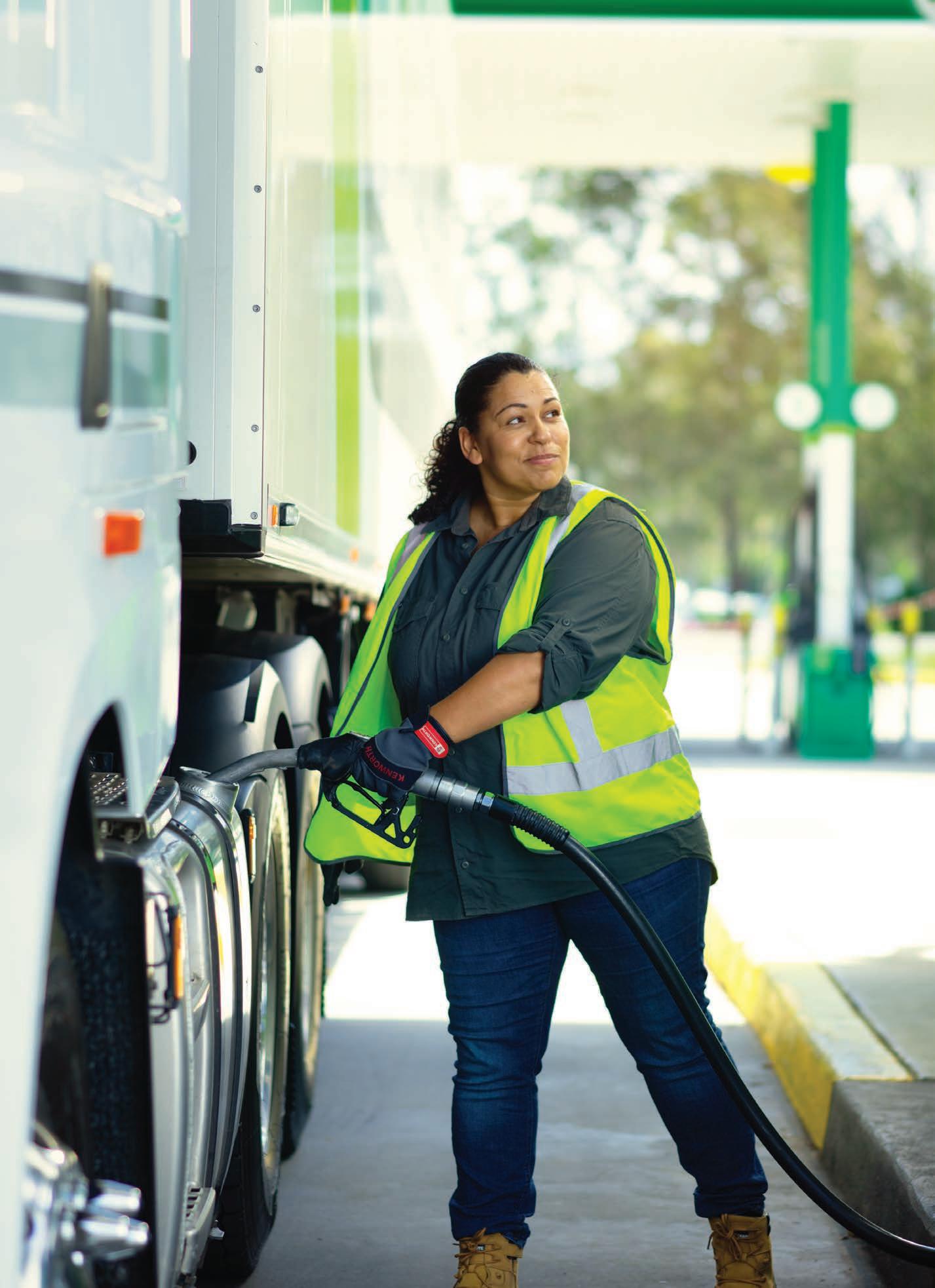
PRIME NEWS PRIME NEWS 26 September 2023
New Actros GigaSpace cab.


Business. The Clever Way. *Earn 3x Qantas Points plus save up to 5c off per litre for 6 months. Purchase 10,000 litres in 6 months for an additional 100,000 bonus Qantas Points. Limited time offer. Minimum spend criteria and conditions apply. Full T&Cs apply at www.bpplus.com.au + UP TO 3XQANTAS POINTS FOR6 MONTHS* BONUS POINTSMINLITREAGE APPLIES + 100 K Earn big & save bigger with BP Plus Scan or visit bpplus.com.au to sign your business up to a BP Plus fuel card to boost your Qantas Points & save on fuel.
> US giants look to consolidate market dominance
Knight-Swift Transportation has closed on the acquisition of US Xpress Enterprises after the purchase was approved by shareholders. Based in Chattanooga, Tennessee, US Xpress generated approximately USD$2.2 billion in total operating revenue in 2022 while serving its blue-chip customer base through a network of around 14 facilities, primarily located across the eastern United States.

US Xpress’ fleet includes approximately 7,200 heavy trucks and 15,000 trailers, including vehicles provided by an estimated 900 independent contractors. The company’s workforce includes approximately 7,700 drivers, 300 maintenance technicians, and 1,900 non-driver employees. The announcement follows Schneider National, another of the top tier fleets, acquiring West Bridgewater, Massachusetts-based M&M Transport Services. A 500 truck and 1,900 trailer provider of transportation, intermodal
and logistics services, M&M Transport provides custom solutions for the retail and manufacturing segments, including some Fortune 500 companies, from 12 locations in the Northeast, Midwest and Southwest.
Market volatility and ongoing economic uncertainty, fuelled by the recent collapse of trucking enterprise Yellow, which filed for bankruptcy last month, following the layoffs of hundreds of nonunion employees, is seeing a realignment of the major players in the market. More recently, Luminus Management LLC acquired Mexicobased carrier Jaguar Transportation, a former subsidiary of the bankrupt Celadon, in an all-cash stock purchase transaction. The acquisition includes over 775 tractor-trailers and five freight facilities throughout Mexico, according to a news release. Focused on cross-border trade with the US, Jaguar Transportation is based in Monterrey, Mexico.
In 2017 Knight merged with Swift Transportation to create a trucking giant valued at USD$5 billion. Still considered one of the biggest amalgamations in industry history, the two companies have maintained distinct brands and operations ever since.
“We are grateful for the efforts of so many who worked diligently to bring about such a significant transaction in the truckload industry,” said Knight-Swift CEO, Dave Jackson.
“Against the current backdrop of a particularly difficult business environment, the chance to add one of the largest brands in our industry, with significant opportunity to improve earnings, gain customers and reach more professional drivers, is a compelling part of our plan to drive higher highs and higher lows across successive truckload freight cycles. “As we have engaged with more of the US Xpress organisation since the announcement, we have even more confidence that our combined efforts will lead to achievement of the profitability targets we communicated. Our cross-functional synergy teams made up of leaders from Knight, Swift, and US Xpress are off to a great start collaborating on plans to share best practices, improve operations and leverage economies of scale — and now they have the green light to fully engage.”
Knight-Swift also is providing an update on current market conditions as management anticipates that consolidated second-quarter results will be lower than previously expected. This decline in operating performance is largely driven by the full truckload market, where persistently soft demand has caused volumes and pricing to be under greater pressure than originally anticipated, while costs remain stable on a sequential basis. This dynamic is expected to drive an estimated 1,100-1,200 basis point degradation in consolidated operating margins yearover-year for the quarter.

GLOBAL NEWS
28 September 2023
A Knight Transportation Freightliner travels down a highway in Arizona.
RELIABILITY AND EFFICIENCY.

MT-160 SERIES TANDEM DRIVE AXLE
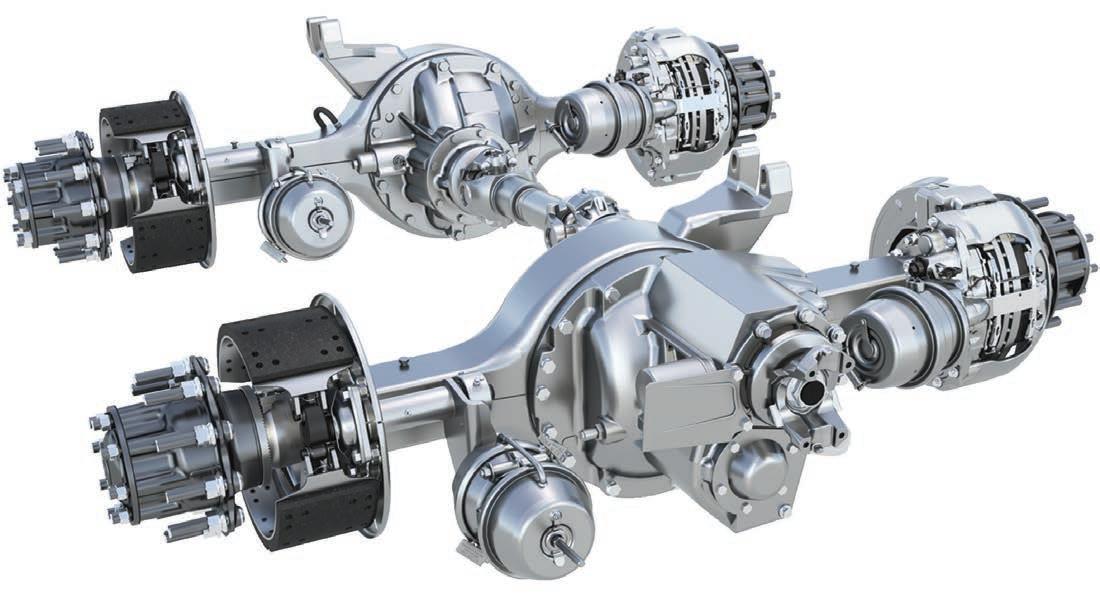
ADVANTAGES
Australia’s most popular heavy-duty axle
Available in Linehaul (Pumpless) or Vocational (Pumped) configurations
Built tough to suit Australian conditions
Frank Sandy
Frank Sandy, CEO of TWUSUPER has been with the fund since 2005. His previous roles have involved managing both finance and human resources. Frank is a CPA and has a Degree in Business Studies in accounting as well as a wealth of experience in finance and superannuation.

A SUPER FUTURE
The superannuation industry is going through a period of rapid consolidation. In part, driven by competitive forces, but also by the increasing costs of doing business, such as heightened regulation and compliance. No doubt as a person in the transport industry, you will relate to these issues, albeit in a different context.
For us at TWUSUPER, it’s imperative that we keep our operating costs down while still delivering the best outcomes for our members. For us to continue to do this, and thrive, we need the economies of scale that comes with being a larger fund.
In April, TWUSUPER and Mine Super announced the execution of a Heads of Agreement and are now in the middle of an extensive due diligence process with the prospect of creating a sustainable $20 Billion fund for mining and transport people. If successful, it is anticipated that the merger will be finalised in early 2024.
Within the superannuation sector, we are seeing generic, ‘mega super funds’ emerging aiming to be all things for all people. We see our future as being focused on transport, logistics and mining industries in a meaningful and substantial way — building on the natural affinities between these industries.
The proposed merger makes sense as transport and mining have many connections and both are the backbone
of Australia. Mining is as much about transport as it is about mining, shifting materials on loaders and trucks, to rail and then to ports and ships. Transport is central to delivering much needed infrastructure, parts, people and provisions to mine sites. I view this proposed merger as being one that builds on these synergies for growth, making the combined fund managing triple the size of TWUSUPER’s current funds under management.
As I’ve already mentioned, TWUSUPER is currently undergoing a comprehensive due diligence process. But as we navigate through the intricate complexities, I’m buoyed by the investment performance results of both TWUSUPER and Mine Super this financial year. It is testament to the funds’ resilience and promising prospects.
TWUSUPER’s Balanced investment option achieved a notable final return of 9.14 per cent in the FY 22/23, exceeding the performance of much larger industry funds. Our High Growth Option returned 12.90* per cent for the FY 22/23.
Of course, long-term returns remain the core objective, but a good year against peers is worth mentioning. This consolidation isn’t just about the financials though. I believe there is a deep-seated cultural resonance that underlies this strategic move. Mine Super, like TWUSUPER, is grounded in values of hard work,
30 September 2023
SUPER MINDSET
The proposed merger of TWUSUPER and Mine Super represents a significant leap towards strategic growth, as the balance between scale and identity is anticipated to make for greater resilience in the sector.
straight-talking communication, and enduring community ties. It’s not just a business merger, but a blending of two communities, where both identities and their underlying character continue to coexist and evolve and improve services for members and their retirement outcomes.
On a practical level, the new Board will be split 50/50 between mining and transport representatives from the current Boards, and a co-chair arrange for the first 18 months. Our Melbournebased office and Mine Super’s Sydney and Newcastle presence will be maintained as the two fund footprints are complementary and national. Importantly, our dedicated transportspecific insurance offering that protects people working in transport occupations,
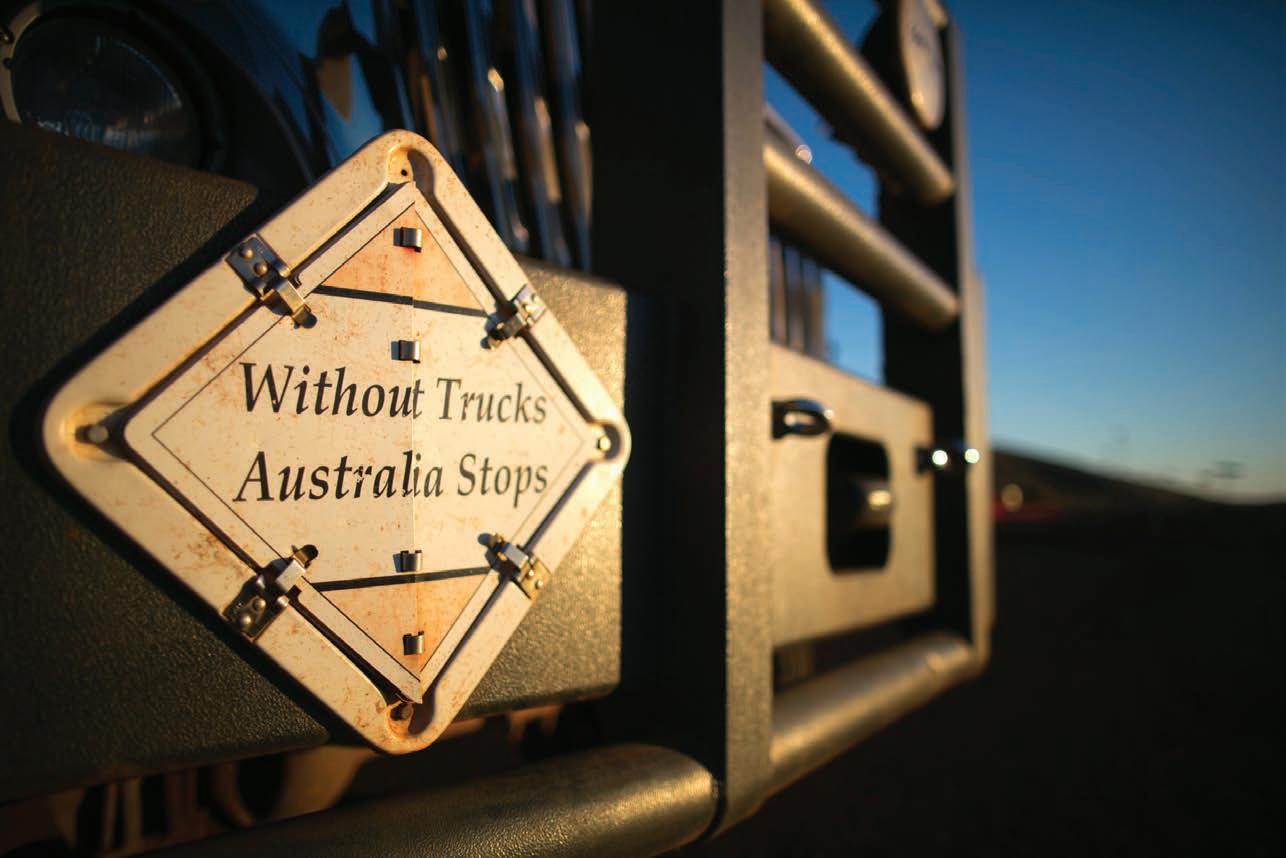
such as drivers, loaders, mechanics and other manual workers, will continue. Mine Super share the same insurer and also protect members in sectors with dangerous occupations that have unique risks. This is an important point of difference when comparing us with a number of other super funds. A useful byproduct of a transport/ mining fund merger will be the strategic relationships between the new entity and key transport partners such as the peak body associations, including the Victorian Transport Association, Queensland Trucking Association, Tasmanian Transport Association, Western Roads Federation. and Australian Road Transport Industrial organisation NSW. The proposed merger of TWUSUPER
and Mine Super represents a significant leap towards strategic growth, while maintaining a firm focus on industryspecific needs, such as dangerous occupation insurance.
As we confront the future, it’s crucial that we foster an environment where growth and industry identity coexist harmoniously, securing a better future for members. The balance between scale and identity will indeed define our sector’s resilience and adaptability in the years to come.
I can’t share our new proposed name just yet, but it will be something we can all get behind.
*Past performance is not a reliable indicator of future performance and should never be the sole factor considered when selecting a fund.
primemovermag.com.au 31 SPONSORED BY
Mining is considered as much about transport as it is mining.
POLE PO

COVER STORY 32 September 2023
SITION
Transporting forklifts is a specialty task that Waverley Forklifts, now in its 50th year, performs exceedingly well for its customers. Over time Hino has become one of its prime partners.

primemovermag.com.au 33
Waverley Forklifts relies on Hino for its lower weight applications.
Waverley Forklifts is the largest independent forklift company in Australia. The business handles in excess of 5,500 rental machines in its fleet and boasts branches in every state. The predominant brand of forklift is Toyota, with Manitou for rough terrain applications.
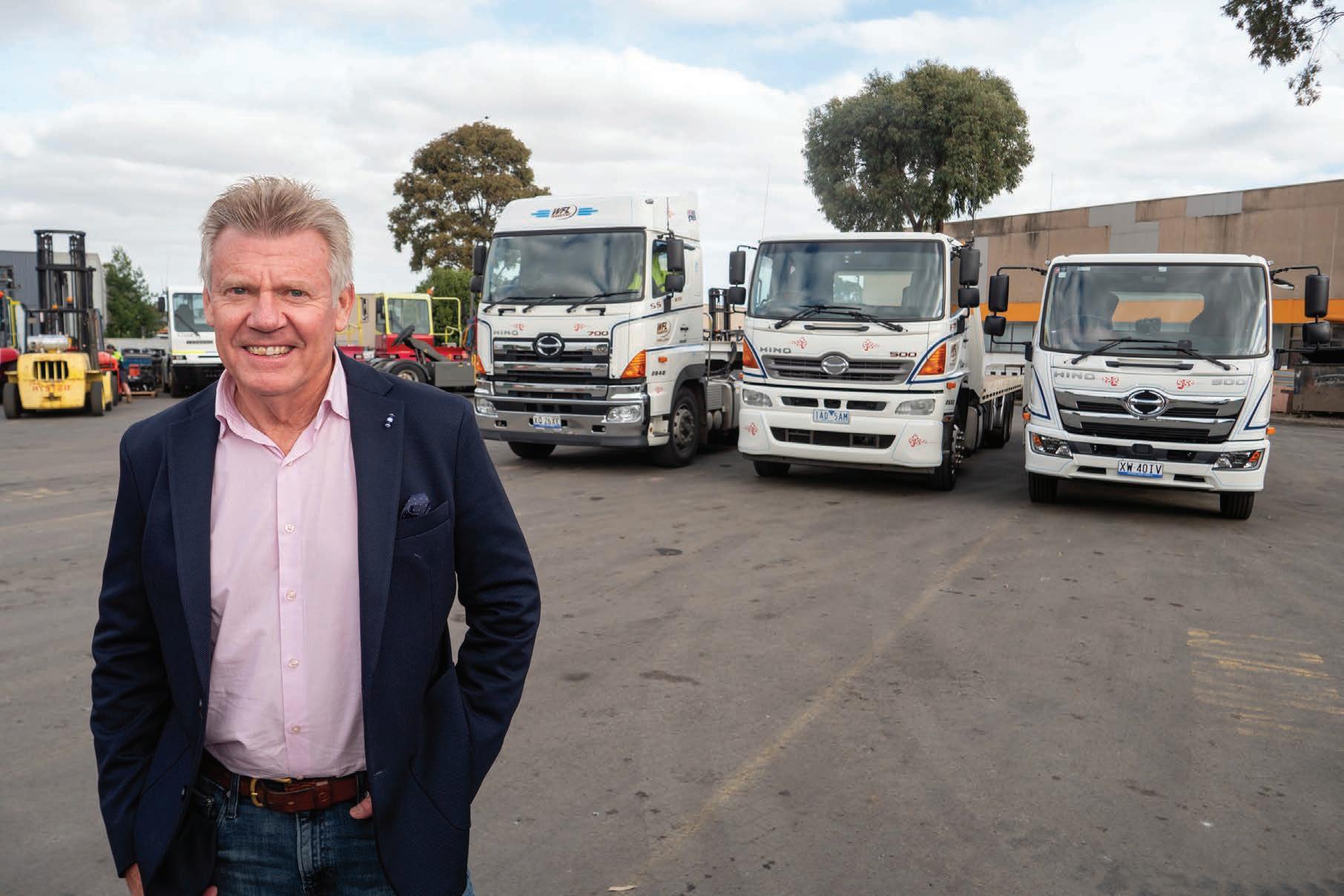
Company CEO Charlie Schwerkolt has built this family-owned enterprise on what he calls the three pillars: “extremely good equipment, amazing staff, and fantastic service.” That he doesn’t merely pay lip service to this mantra is proven by the impressive success of the company over many years and by using exactly the same model in every state. A key factor in providing the desired
high level of service provided by Waverley Forklifts is the use of its own fleet of trucks to transport the various pieces of forklift equipment. Nationally, the fleet has grown to more than 30 trucks ranging from six-tonne tilt trays to B-doubles with the clear intention to provide a one stop shop which can deliver forklifts to clients in most areas of the country on the same day as the initial phone call.
The core of the forklift operation is the provision of a fully maintained rental package for units between one-tonne and 16-tonnes capacity for periods ranging from one day to five years. The only other area Waverley Forklifts has ventured into is the supply of Terberg terminal tractors to Australia Post.
Charlie started out as a driver for his father. He has held a truck licence since he was 18 and regards forklifts as better to transport than general freight. “We have got to be fairly stringent in all our safety procedures, and now it’s a lot safer with winching everything up and strapping them down,” he says. “I think they are easier to cart but obviously you’ve got to watch your height and your weights. It’s just something I was taught as a kid to do every time I hop in a truck, I’ve got to make sure what’s on the back height-wise. Forklifts have a tendency of hitting bridges or power lines and you’ve got to be right on the ball.”
The average forklift weighs around four tonnes and ten units can be legal on a B-double provided the axle weights are
34 September 2023 COVER STORY
right. Moving a forklift just one metre can change the axle weight distribution, so the trailers are equipped with onboard scales.
Charlie’s father started the business using second hand Bedfords and when Charlie came into the company in 1988 one of his dreams was to get to the point of being able to afford a Kenworth.
“They are a very good quality truck and I’m proud to now have them in the fleet,” says Charlie.
The only other brand of truck to be considered, for the lower weight applications, is Hino.
“I’m a pretty loyal sort of a person. All the forklifts are Toyota. The bigger trucks are Kenworth and we’ve got 12 Hinos in fleet. They’ve been really great.”
Obviously, the relationship with Hino’s parent Toyota Corporation fits with the business as well.
“It ties in very well delivering the Toyota materials handling product on a Hino truck,” says Charlie. “The Hinos have been fantastic as a metro truck delivering forklifts all around Melbourne, Sydney and Brisbane. They’re reliable and very easy to drive.”
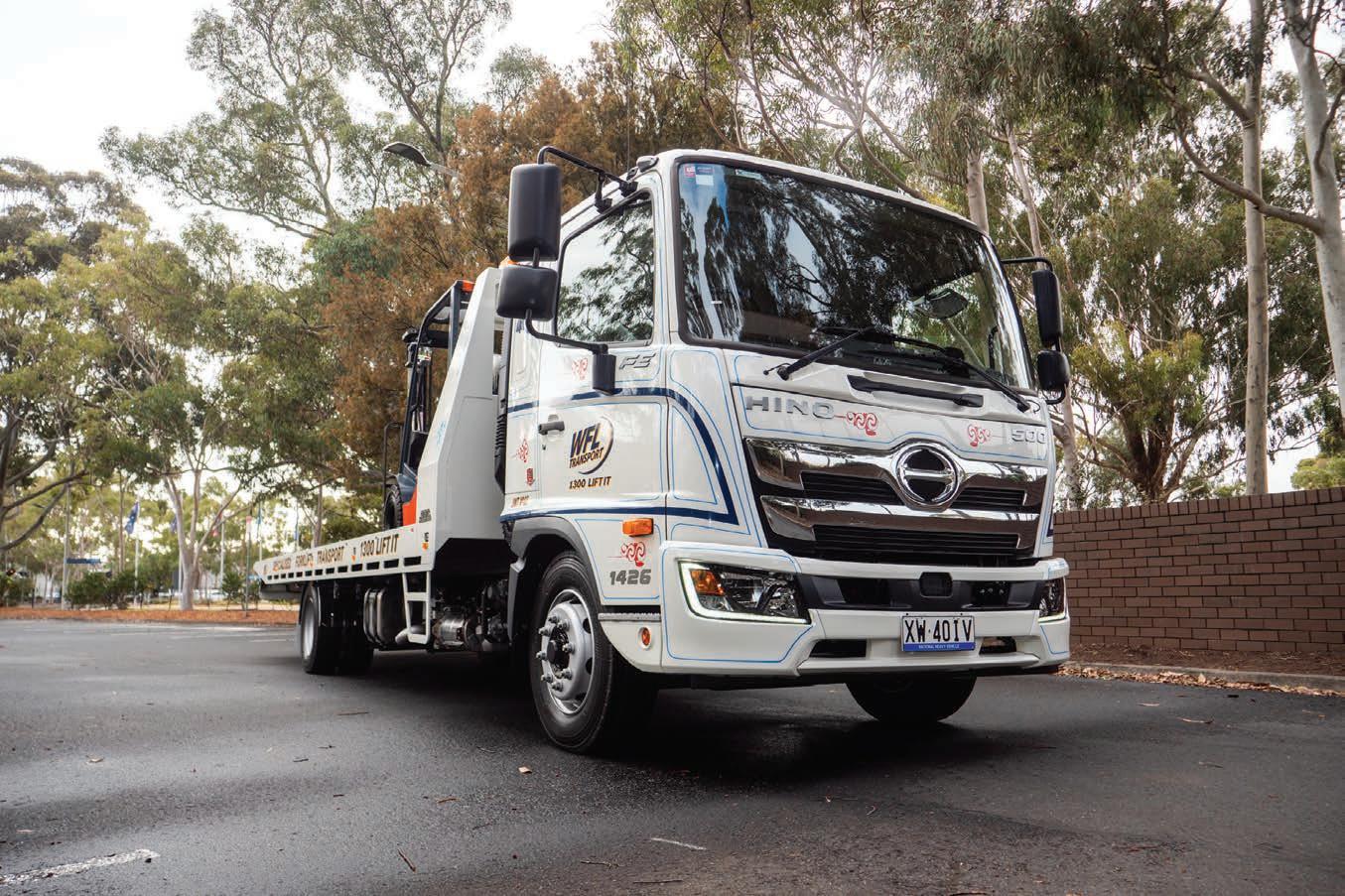

The Hino fleet includes 4x2 and 6x4 tilt trays based on Hino 500 Series models and recently a Hino 700 Series prime mover has been added.
Waverley Forklifts looks for good people to match its chosen brands of quality equipment.
“We’re a pretty tight family-style operation where we take great pride in
looking after our staff and I think that gives us a better shot of recruiting and retaining the right people,” he says. “Our staff turnover is extremely low because of this.”
Charlie considers his truck drivers to be important ambassadors for the company.
“You want your own driver delivering your forklift to a site,” he says. “If you’re a customer, the first impression of Waverley Forklifts is the truck driver delivering to your place. I want them to be a breath of fresh air and for the customer to think: ‘this guy actually cares.’”
Large public events also benefit from the expertise of the Waverley Forklifts team. An example is the Australian Grand Prix
primemovermag.com.au 35
Hino 500 with tilt tray in Melbourne.
Charlie Schwerkolt.
held at the Albert Park Circuit where Waverley Forklifts have been providing forklifts for the past 27 years, with up to 180 forklifts at the site from the end of January through to the end of May. The much-anticipated Taylor Swift tour next year will involve 35 to 40 Waverley machines at every concert venue. Other events such as the Sydney Boat Show may require 20 or so machines which might only be there a week.
To deliver onsite service to its forklift customers, Waverley Forklifts has more than 50 service vans around the country, all based on Toyota HiLux cab-chassis. The trucks are not under service contracts and a service provider ensures a team of technicians handle the needs

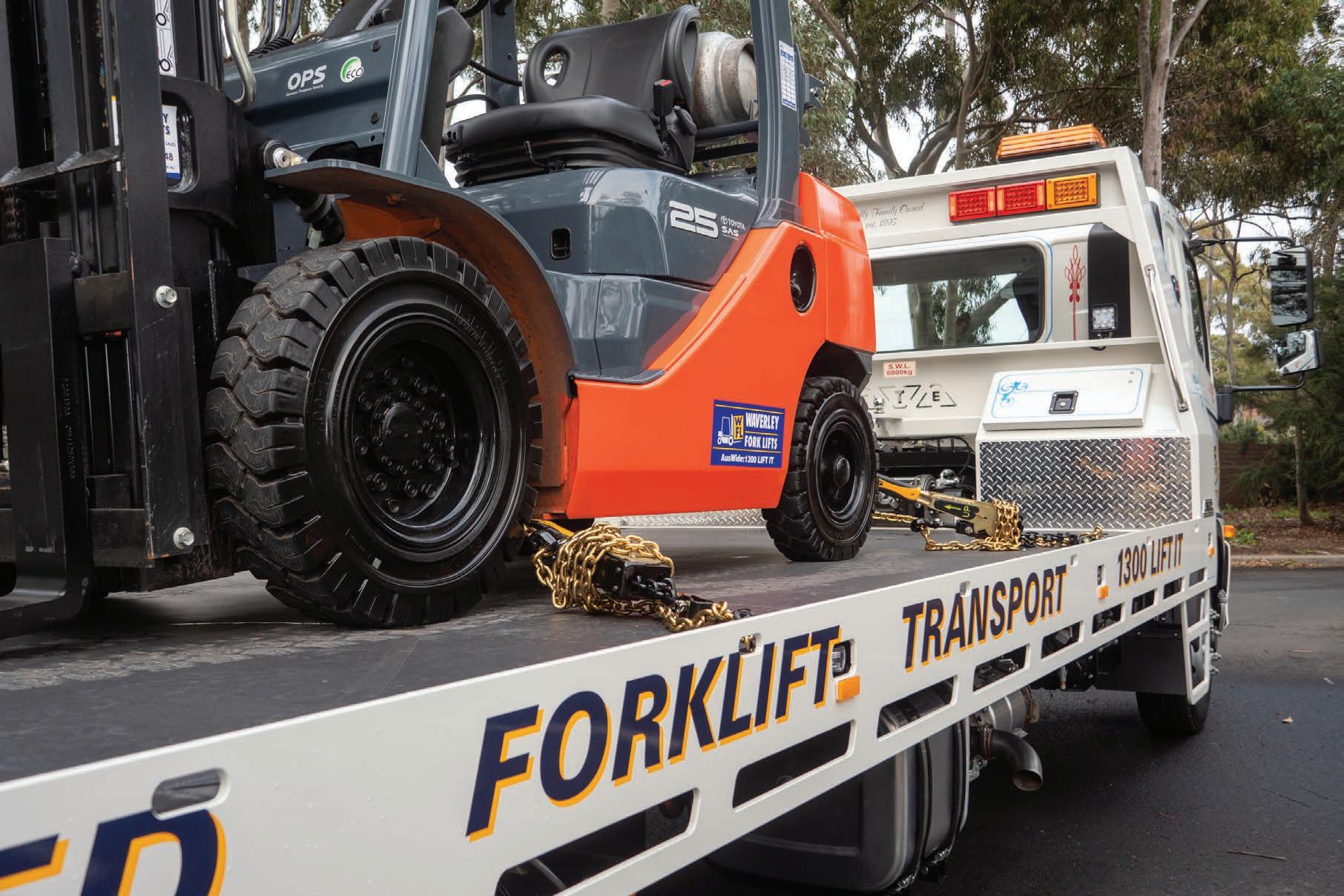
of the trucks every weekend in all locations.
This aids in achieving optimum time management for the trucks while ensuring all repairs and maintenance procedures are expertly carried out. Most of Waverley Forklifts transport applications are quite low in annual mileage. Consequently the Kenworths are generally kept for ten years and the Hinos seven years.
At the end of their time, there are no issues selling them off as complete units because the equipment is good to begin with and is well looked after. The tilt trays and the low loader trailers are manufactured to Waverley Forklift’s specifications by CTE.
There is considerable investment in building the tilt tray bodies and efforts are made to keep the tray level as low as possible, assisted by utilising low profile tyres to keep height down, which also requires specifying taller diff ratios to maintain correct engine and road speeds.
“Forklifts are going higher and as industrial space gets more expensive people want to go higher with their racking,” says Charlie. “When we started a five or six metre forklift was considered high. Now we’re providing 11 and 12 metres lift heights.”
Something which permeates throughout the entire Waverley Forklifts operation is the feeling of a special corporate
COVER STORY
Hino 500 delivers a forklift.
“culture”. New employees sometimes express surprise at how friendly and helpful other team members are in their effort to be a part of building the biggest forklift rental company in Australia.
“Culture in business doesn’t just happen, you’ve really got to work hard,” says Charlie. “I’ve been in this business at the same place for 45 years and during that time I’ve built a great leadership team, including our Manager Director, Justin White, and it’s so important to have a good culture where everyone feels part of the team.”
Charlie is also known for being the
in-house. Motor racing serves as a very effective promotional program for not only Waverley Forklifts, but for the long-term race team sponsors as well, including long-time supporters Hino and Kenworth. Ironically, it was because of a forklift that Charlie became involved in Supercars, after abandoning his own motor racing ambitions as a young man to concentrate on building the business. Years later Charlie found himself seated on a plane next to Australian motorsport icon Dick Johnson.
tired old forklift in his race shop and invited Charlie to visit, which lead to a new forklift as part of a sponsorship arrangement which, in due course, reignited Charlie’s interest in motor sport, ultimately leading to his ownership of Team 18.
Waverly Forklifts’ sustained success in the competitive forklift rental sector can be attributed to many things such as providing top level service and world class equipment.
“I’m still extremely passionate about Waverley Forklifts and enjoy coming to work every day.. says Charlie. “We’ve
 A Toyota forklift secured to the tilt tray.
A Toyota forklift secured to the tilt tray.
TOP OF TH
Since 1989, when the fleet first opened its depot in Sydney, Shaw’s Darwin Transport has resolved to help its clientele move freight between Darwin, Sydney, Perth and Brisbane. With a wide range of equipment capable of completing various freight tasks, the well-respected and independently-owned business, specialises in moving fresh produce, non-perishables, medical equipment, pharmaceuticals, mining equipment, heavy machinery and vehicles. The business is the creation of William Shaw, who in 1989 started operating a Kenworth for a road express service between Sydney and Darwin,
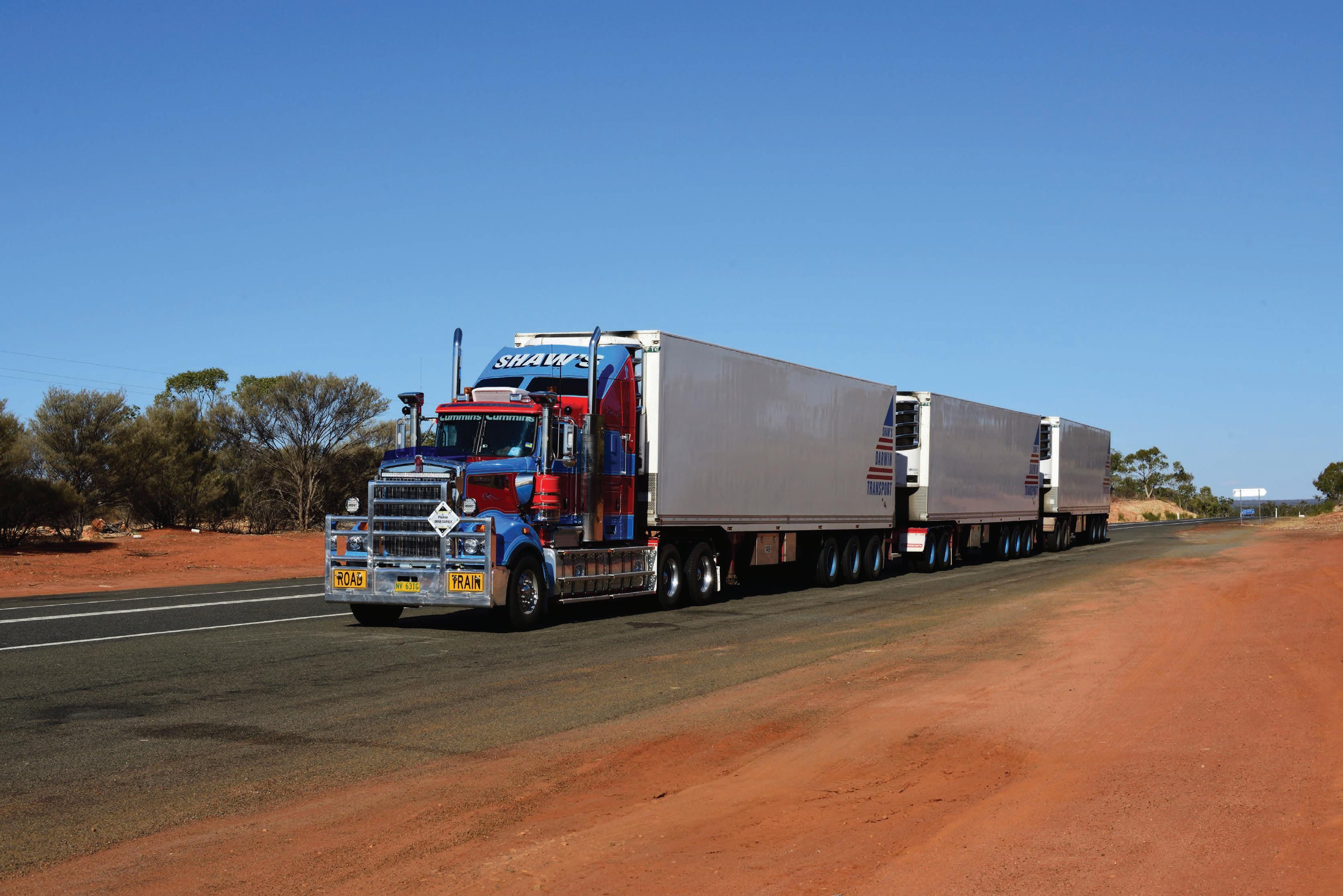

mainly as a subcontractor for one of the major national carriers. Not more than a year later he was already pursuing expansion with purchases of additional prime movers and trailers. By 1986 the business name ‘Shaw’s Darwin’ had been officially registered. Several more expansion phases followed and with it a growing reputation for quality service.
Shaw’s Darwin Transport, as the company is now known as today, uses 50 prime movers, 133 trailers, and 63 dollies in its daily operations. Excepting one old Detroit engine, the fleet is 100 per cent Cummins powered. Put simply, as Fleet Maintenance Manager, Jim Backhouse says, the Cummins product
FLEET FOCUS 38 September 2023
Fleets like Shaw’s Darwin Transport, which relies on Cummins and Meritor, are getting the best of both worlds, following the merger of the two companies.
E WORLD
serves the fleet well.
“The product is strong, and we’ve run it for many, many years,” he says. “We originally started with Detroit engines, however, in later years we saw the way to go was with Cummins. Because we’re pulling two and three trailers at a time, we needed more horsepower. Since then, we’ve never thought about changing or looking back.”
The ongoing affiliation with Cummins is undergirded by the company’s impressive national presence and close proximity to Shaw’s Darwin Transport headquarters. That it continues to power the entire fleet will speak volumes to anyone involved in long haul operations


with its brutal demands on equipment. “The runs are on the board because of the way the product serves us,” Jim says. “If we continually had issues such as breakdowns or things breaking and leaking, we would definitely look outside that current supplier.” He adds, “But to be quite honest, we haven’t had a reason to.”
The fleet’s transformation in many ways has come about given how well the Cummins engines had been performing in isolation. Opting for the Cummins product was hence more obvious when it came time to grow the fleet. In that time Shaw’s Darwin Transport has accumulated a lot of experience with
Cummins’ engines — particularly the X15, which Jim is a big fan of.
“It’s a vast improvement over and above the EGR engine,” he says. “It’s been very good. Its life is great, and its fuel economy is quite good in our operations. It had some early teething problems but we’re well over them.” The engine, no matter what you throw at it, has positioned itself as a top-tier product in the eyes of many owneroperators according to Jim.
“People know how hard these vehicles work and how quickly we can put kilometres on them,” he says. “Our trucks average 8,000 kilometres a week on the Darwin run, and they’re up
primemovermag.com.au 39
Kenworth T909 triple roadtain.
around 380,000 kilometres a calendar year on the express. In addition, if there are ever any issues, which I’m not saying there are very often, we are able to get them looked at and sorted quite quickly to get back on the road.”
To some, Cummins’ $3.7 billion acquisition of Meritor last year will drastically alter the commercial vehicle landscape. The alignment of both companies means the process of getting a more complete and seamless solution is possible, for businesses like Shaw’s Darwin Transport, given it solely relies on products from both OEMs.
Shaw’s Darwin Transport has been associated with the Meritor product since 1991. Now, knowing both teams behind each brand, Jim is certain Cummins-Meritor will be a very strong competitor under the one name.
“It has only been a very short period of time, but I’m sure it will be,” he says. “We know the people to talk to and
they’re always willing to look outside the square and try to help us, so we’re looking forward to continuing the relationship with both companies, only now together.”
Meritor’s product, not dissimilar to the Cummins equipment, is notable for its reliable performance particularly for its longevity. They are, in Jim’s estimation, complementary.
“Both the products have a very good lifespan, and the teams backing the products don’t tend to change,” he says. “They have suppliers that they have had for the whole history of the company. We’ve seen this throughout our entire dealings with Cummins and Meritor, and that whole time the product hasn’t let us down.”
Backing this claim are Shaw’s Darwin Transport’s demanding operations.
The fleet, typically, will move a single trailer over the Blue Mountains along the Great Dividing Range en route to
Darwin, hook up one more trailer in Dubbo before heading out even further to Bourke, and then, hooking up a third trailer to make a triple roadtrain that from here will trek another 3,000-odd kilometres back to Darwin. In some cases these units can weigh upward of 100 tonnes.
“So, as you can see, it’s quite a testing operation through a very remote part of Australia,” Jim says. “But the axles hold up.”
Cummins-Meritor guarantees help in these instances with service availabilities in some of Australia’s most remote areas — areas Shaw’s Darwin Transport vehicles are a frequent presence.
“One of the other things you have, which is an advantage with these two products, is we can go to any other OEM dealership and get repairs,” Jim says. “Whether that be international or local dealerships, they’re all under the same banner which is quite powerful.”

40 September 2023 FLEET FOCUS
Cummins X15 power plant.
For many years, Shaw’s Darin Transport has chosen Meritor’s MT21-165GP and MT23-168GP axles under the 160 series. The 160 series tandem axle has been proven in Australia over many years of use and is the most popular axle produced at the Cummins-Meritor facility in Sunshine, Victoria. Considered an ideal choice for a variety of applications calling for 21- to 23-tonne Gross Axle Weight Ratings (GAWR), these axles feature precision forging of differential side gears and pinions which in turn increases reliability and shock resistance.
In addition, the driver controlled differential lock (DCDL) allows users to select engagement to generate equal drive in each wheel as needed.
“We’ve always found these to be an extremely good axle for our operations,” Jim says. “Our trucks are rated at 130 tonnes and this axle goes that far. About 95 per cent of our operations is bitumen road conditions. Therefore we don’t require a heavier axle. This suits us quite well for the road conditions we encounter.”
Thanks to Meritor’s eye for catching new opportunities, these axles now come in two versions. In the Linehaul spec, Meritor has essentially taken the oil pump out of the tandem axle to give customers more efficiency and better economy. Good news for the traditional pump fanatics though, a pump is still available through the Vocational version (Jim’s preferred choice) where it protects the whole axle against internal damage when factoring in wheel spin.
Put simply, the Linehaul version is more suitable for customers who have a clearly defined linehaul B-double or single trailer freight task, while the Vocational is more durable in heavier applications.
“It’s a very strong axle,” Jim says. “It suits our operation because we only run to 130 tonnes. We have used bigger axles made by the same people, but they haven’t served us as well as the 160 axles. We service them and we look after them, too. We change the oils and we have certain intervals, and all of our front diffs on our
130-tonne rated Kenworths come with an oil cooler fitted as a requirement of Shaw’s. It just helps the axle cool better. I think this prolongs the life a little bit, but that’s just something Shaw’s do.”
In the long run, Jim says the benefits of going with Cummins and Meritor can be seen in their reliability, and the fact that some of these products have the capability to withstand enormous amounts of miles.
“Our engines are well over a million kilometres before requiring major repairs,” he says. “Our Meritor axles are the same — they’re well over a couple of million kilometres, which is extremely good for an axle pulling three trailers

around the country. The axle, going back a step, has a little bit of an issue with leakage which Meritor have been working on. I believe, at this stage, it’s been rectified.”
The support both brands offer both before and after an agreement is made, Jim says, is also unmatched.
“Both the companies have very strong teams behind them, and the service outlets they have around the country are excellent,” he says. “We never suffer from poor service. With Cummins and Meritor, we’re extremely lucky to be able to speak to people in the right place and get action quite quickly, and I think in this day and age that’s a must.”
primemovermag.com.au 41
Meritor 160 Series axle.

FLEET FOCUS 42 September 2023
A glimpse of new long haul Kenworth K200s.
In 2004, Anthony Mansell and his wife jumped straight into the deep end. With just a single Kenworth and a shared vision between them, AJM Transport was born.
“It will be quite a big milestone for us next year, celebrating 20 years of AJM Transport,” he says. “I would be lying if I said we’re not super proud of that. “I took the plunge and bought one truck, and I suppose we’ve sort of grown off the back of that. Twenty years condensed into one minute is a quick version of our story, but that’s basically the nutshell of what we do.”
The fleet, based out of Newcastle in New South Wales with branches in Sunshine in Victoria and Rocklea in Queensland, finds itself revolving around express and time sensitive freight.

AJM Transport has, since the purchase of its first prime mover, diversified into what Anthony describes as a unique shuttle system on the eastern seaboard between Melbourne and Brisbane. “We shuttle everything between those ports with trailer and driver changes, and what that does is it supplies a pretty unique and vast service to customers,” he says. “But also for us as a business, it gives massive utilisation – our shuttle trucks in the middle are doing about 580,000 kilometres a year.”
On the other side of the coin, the fleet is involved with several other tasks as well. Manufacturers, for example, will come to Anthony to test equipment on trailers, trucks and engines. This, he finds, is a quite enjoyable part of the job.
“We’ve built our business off of relationships, providing a service, and supplying, I believe, exceptional gear and spec,” he says. “We’ve been doing
it for 20 years, so we’ve got to be doing something right.”
Anthony purchased a second-hand Kenworth after his first one, and since then, he has continued to replenish the fleet’s numbers, whenever suitable, with Kenworth. In the long run, this has paid off given the fleet’s various operations due to the brand’s reliability.
“It’s just the continuity we experience with the product,” he says. “We can put a new engine in a million-kilometre unit and replace gearboxes and diffs at certain intervals, and it will be good to go again.
“When you do nearly 12,000 kilometres a week, you can’t progressively wait for things to fail as they just break and let you down. So, we’ve got a pretty good truck record now. Our Group General Manager, Dennis Roohan, has been instrumental around that preventative maintenance program and being able to achieve those high kilometres in a short period of time.”
More recently, AJM Transport took delivery of a new Kenworth T909. The unit, part of a larger order consisting of 36-odd prime movers, will soon be joined by another eight K200s for the fleet’s east coast express shuttles between Melbourne and Brisbane.
“We just got another one in and there’s another three right behind them,”
Anthony says. “Then there’s another two that will go to our Melbourne to Newcastle run for a specific customer. They’re long overdue, but I can’t wait to put them in the fleet. It’s almost like you can breathe fresh air as you’ve updated the fleet.”
The new T909 was bought specifically for one of AJM Transport’s long-term customers. But the deal, Anthony
reveals, didn’t go according to plan.
“We bought this truck for a customer which we do a lot for on the east coast,” he says. “We do the Darwin leg and have done it for nearly ten years with that customer. It was a big commitment – a lot of kilometres travelled, a lot of roads taken – and literally a young guy that’s been catapulted into a national role asked me to cut all my rates. We’re just not about that — we’ve never done it. I told him I was happy to work with him, organised a hook up, but he didn’t take me up on it. He sent me an email, didn’t even pick up the phone, and cut us on the Monday for $6 million worth of work.”
By Tuesday, all of that gear was placed again, thanks to its relationships with loyal customers it maintains throughout its business.
“That makes me proud of what we’re doing and what we’ve done,” adds Anthony.
It’s important, he believes, that people understand that the industry can’t just cut rates.
“I mean, we’re all living in a world of inflation and interest rates,” he says.
“I feel strongly about that because our customer base is strong and I love that about our business.”
The Kenworth, nevertheless, went straight to work for its new dedicated customer. According to Anthony, it has performed flawlessly without ever missing a beat.
“We couldn’t be prouder of what we’ve achieved with it,” he says. “The T909 suits it extremely well with double bunks, TVs, microwaves and separate air conditioners. It’s basically selfsufficient.”
primemovermag.com.au 43
As AJM Transport approaches its 20-year milestone, Managing Director Anthony Mansell is continuing a tradition he started two decades ago with the purchase of his first truck, a Kenworth T401.
Although the unit is grossing just under 130 tonnes, AJM Transport over-specs it, like all of its units, at 160 tonnes to prevent inadvertent mistakes made in the past.
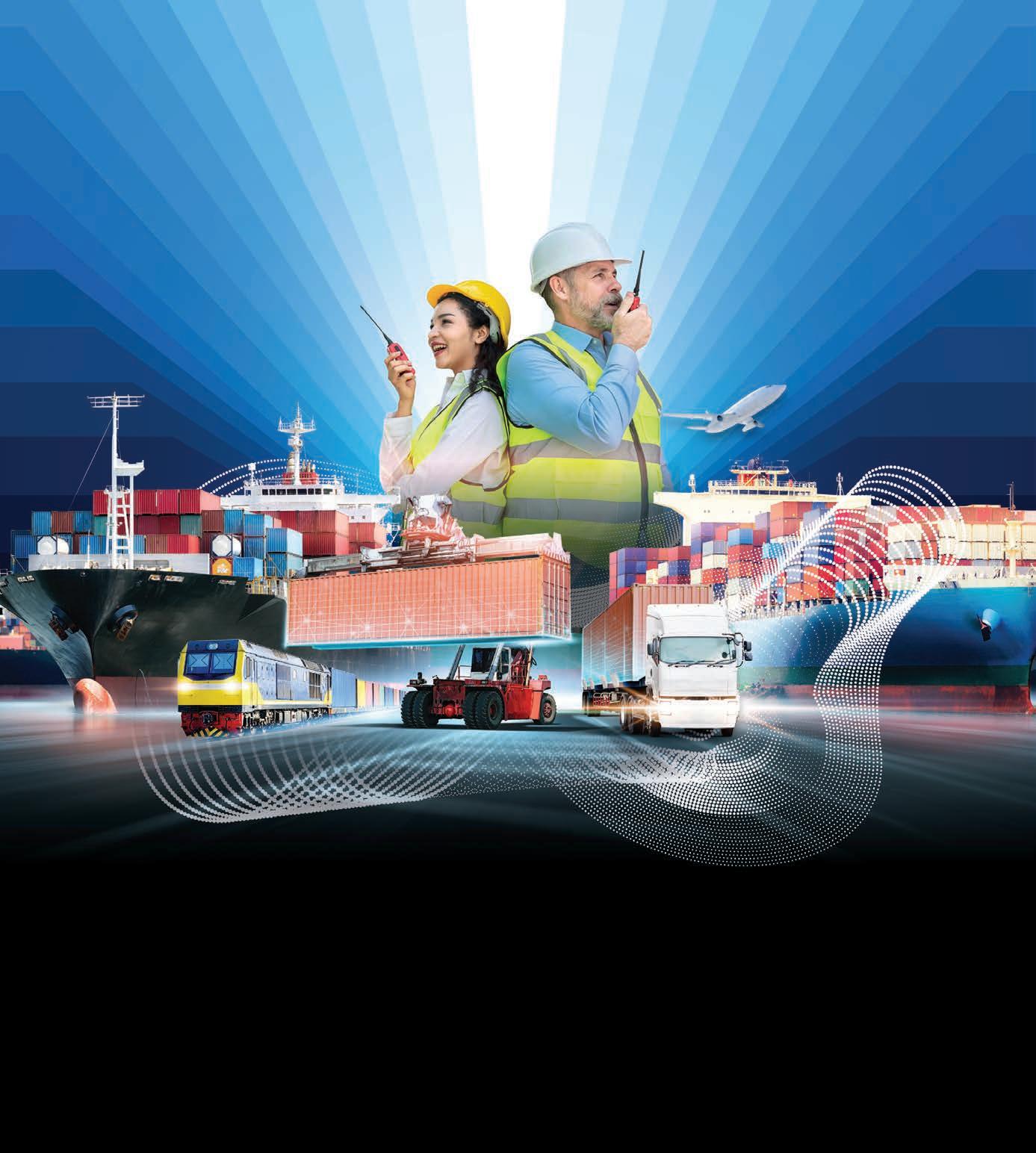
“We’ve developed the spec of those trucks over time with Cummins and Meritor,” Anthony says. “It might not sound like much, but we’ve had challenges with a slightly different spec and we’ve been able to tweak that. Now, we literally turn the key, and it goes to work.”
Behind the wheel of the T909 is a husband-and-wife team which run the truck up and down the east coast every week, every month, and every year, as has been the case for the last ten years. “There’s a wet season every year, and sometimes the husband-and-wife team gets stuck in the middle of nowhere,” Anthony says. “We don’t like it, but it happens. That’s the reason why we equip them with the right tools for the trade.”
to take it from Brisbane to Darwin. The road conditions encountered by this Kenworth, among the fleet’s other ones, is quite extreme. It’s also why Anthony believes it is, as a prime mover brand, the only suitable choice.
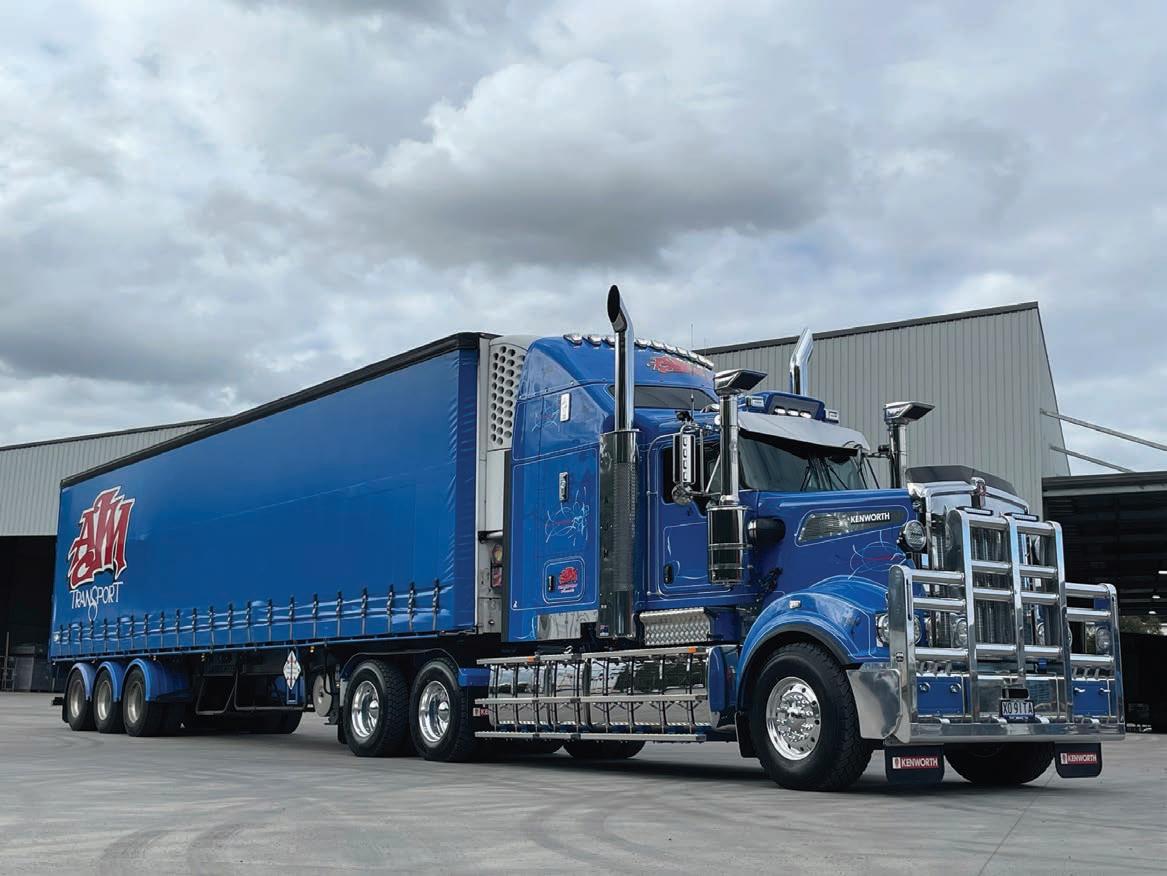
“There’s no other truck that will do that run up there,” he says. “With respect to other manufacturers, they just would not cut it. The roads are horrendous. You’re back to 40- and 50 kilometres an hour sometimes, literally. The easiest way to describe it is if you’re sitting on your chair at the kitchen table and I get behind you and shake you around, that’s what it’s like — and you’re doing that for hours on end sometimes. It’s just a different monster up there.” For Anthony, Volvo is a very close second on the eastern seaboard. In fact, he says they do an extremely good job on the linehaul side in a B-double application. But, with the shuttle trucks and high utilisation, the Kenworths have
“We choose specifically to deal with our local dealers at Gilbert & Roach. They’re extremely supportive, and I’d like to make a point of that. The Suttons Group, and locally at Gilbert & Roach Newcastle, are super supportive and that actually is a big factor of why we keep going back to the product as well. They’re extremely good in our industry and good for our business.”
Looking ahead, there’s no doubt in Anthony’s mind that, sometime down the track, he will find himself at Gilbert & Roach again looking for additional Kenworths.
“We’ve got a constant order base and we’ve got to plan so far ahead these days,” he says. “We generally do between 16 and 22 new prime movers a year, whether that’s additional, replacing, or a bit of both. We’ve got some trailers we’re going to dribble through as well. We’ve got another ten sets coming in the next month, and then we’ll get some at
44 September 2023 FLEET FOCUS
The new Kenworth T909.


MEGATRANS is Australia’s largest integrated conference and exhibition dedicated to the logistics industry. MEGATRANS will showcase the latest in artificial Intelligence (AI), robotics, automated racking, telematics and route optimisation, warehouse automation, intelligent fleet systems, blockchain, Internet of Things, big data and advanced analytics. megatrans.com.au REIMAGINING THE SUPPLY CHAIN MEGATRANS returning 18-19 September 2024 BOOK YOUR STAND TODAY IN CONJUNCTION WITH Melbourne Convention and Exhibition Centre ASSOCIATION PARTNER PROUD SPONSOR
TRAIL BLAZING
Soon to mark ten years since its founding in October, 2013, ColdRex Refrigerated Logistics offers an inimitable value proposition through a regional network it has nurtured and grown steadily over that time. The next phase of expansion, when it comes, will see the company move further north into Bundaberg and then Central Queensland. At current, the Sunshine Coast is its most northern extremity. To the south, it services customers as far down as Melbourne. The key focus of its transport operations revolves around deliveries to regional independent supermarkets and food distributors. A majority of these are IGA stores found in the three most populous states of New South Wales, Victoria and Queensland, where ColdRex maintains a depot in each including Noble Park in Melbourne, Archerfield to the south of Brisbane and Sydney’s Smithfield, where a workshop for servicing and minor repairs is also situated.
The first iteration of the company saw it operating as a tow operator. That was when it possessed three initial trucks. The fleet today contains nearly 60 vehicles. Operations Director Brendan Donnelly previously worked for Toll’s refrigeration arm and Scott’s Refrigerated Logistics prior to founding ColdRex. Business bloomed, he recalls, after it won a contract from Monde Nissin who, at the time had taken on Bulla Ice Cream as a client. That was, historically speaking, ColdRex’s point of entry into independent supermarkets.
“They needed someone who could do frozen and chilled distribution,” Brendan says. “We won the contract in New South Wales and tended for the one in Victoria and then tended for the one in Queensland and it has progressed over the last five or six years.”
That work led to subsequent accounts on the eastern seaboard, notably Primo Smallgoods.
Today, utilising the same network it has established in little under a decade, ColdRex will handle regional freight for the likes of Lindsay Transport.
“We deliver different freight for multiple
customers that go out on those same routes using all our own company equipment,” says Brendan. “That gets us to every country town on the network multiple times per week.”
More than 95 per cent of the mobile asset infrastructure is company-owned with third party outsourcing, at present, an exception rather than the rule.
“We do a 100 loads a week of Nudie orange juice,” Brendan explains. “Some of those occasionally are full loads out of Griffith going to Melbourne that will require a sub-contractor but predominantly it’s all of our own company fleet in use.”
Late last year the fleet, which had been for many years largely mixed as it found its feet, debuted a new Euro 6 DAF CF450. It has since excelled pulling a single trailer. So impressed was Brendan he invested in a further three DAFs this year, opting for the larger DAF CF530 model to move its B-doubles between Sydney and Griffith.
Improving the fuel consumption, given the punishing operating environment, is an early triumph made possible by the new DAF trucks.
“The single trailer DAF is getting 2.7 kilometres per litre,” says Brendan. “That’s big. The other trucks are getting around 2.2.”
As the fleet still runs a few Kenworth T909s, there was a pre-existing relationship with PACCAR that opened the door to DAF, a brand, along with Volvo, ColdRex, according to Brendan, will look to consolidate within the fleet going forward.
“The CF450 does local runs during the day and three shuttles between Smithfield and East Gardens of orange juice and at 3pm it does a changeover at Holbrook,” Brendan says. “The dayshift driver gets in it at 4am in the morning and does two shuttles that takes about ten hours during the day.”
That all adds up to around 22 to 23 hours work a day for the vehicle. So far it hasn’t faltered.
“It’s doing great, and the drivers are pleased with its performance,” says Brendan. “It’s versatile as well as being
FLEET FOCUS 46 September 2023
Celebrating its tenth anniversary next month, ColdRex has steadily built a reputation as a premier eastern states cold carrier, servicing regional areas.
really good on fuel.”
Brendan, who has driven the new DAFs albeit briefly, defers to the feedback from his driver’s, which is uniformly enthusiastic.
European style cabovers are favourably cited by fleet managers usually for the
“big plus” in the new Euro 6 DAFs, it’s the user-friendly product, as Brendan refers to it, which convinces him of its long-term viability as a flagship truck in the fleet.

“The automatic transmission makes it easier to drive for the new age
The drivers have told Brendan, not coincidentally. that the DAFs are easy to use. Part of that comes down to the layout in the cabin. The location of the instruments on the dash are well thought out in relation to the steering wheel and sightlines outside the truck says Brendan.
Euro 6 DAF CF450 6x4 prime mover.
personnel employed by the business. A workshop, mentioned earlier in Smithfield, is staffed by one mechanic who can handle servicing, general repairs and jumpstarting.
“All your basic sort of stuff,” says Brendan. “Anything considered major gets outsourced by us.”
FMCGs, better known as fast-moving consumer goods, have, as a consequence of mass mobilisation, evolved rapidly in recent times. Where ColdRex might be said to succeed foremost is in how it has anticipated changes in the market specific to its working model as if they were born of its own planning rather than the other way around. Demand for regional freight spiked during the COVID period when remote working environments and migrations from major cities, following lockdowns, began in earnest.
“It changed noticeably during COVID between people travelling and getting busy along the north and south coast and regional areas were busier and products were harder to get in supplies,” Brendan says. “During winter it’s normally a quieter time with staff taking time off and then
summer is usually busy but because of COVID people soldiered on and worked through.”
That period has proven particularly fruitful for ColdRex. Brendan acknowledges that the business, ever since then, has undergone a rapid growth journey.
“We had a 90 per cent increase in revenue year-on-year in 2020 that coincided with expansion into Queensland and taking on a large contract out of Griffith in NSW,” he says.
That new account inexorably expanded its multi-combination footprint. The new B-doubles are mainly doing changeovers in Griffith where packaged goods are delivered before the trucks return with finished goods. ColdRex will also blend in consolidated cartons from across its customer portfolio where appropriate.
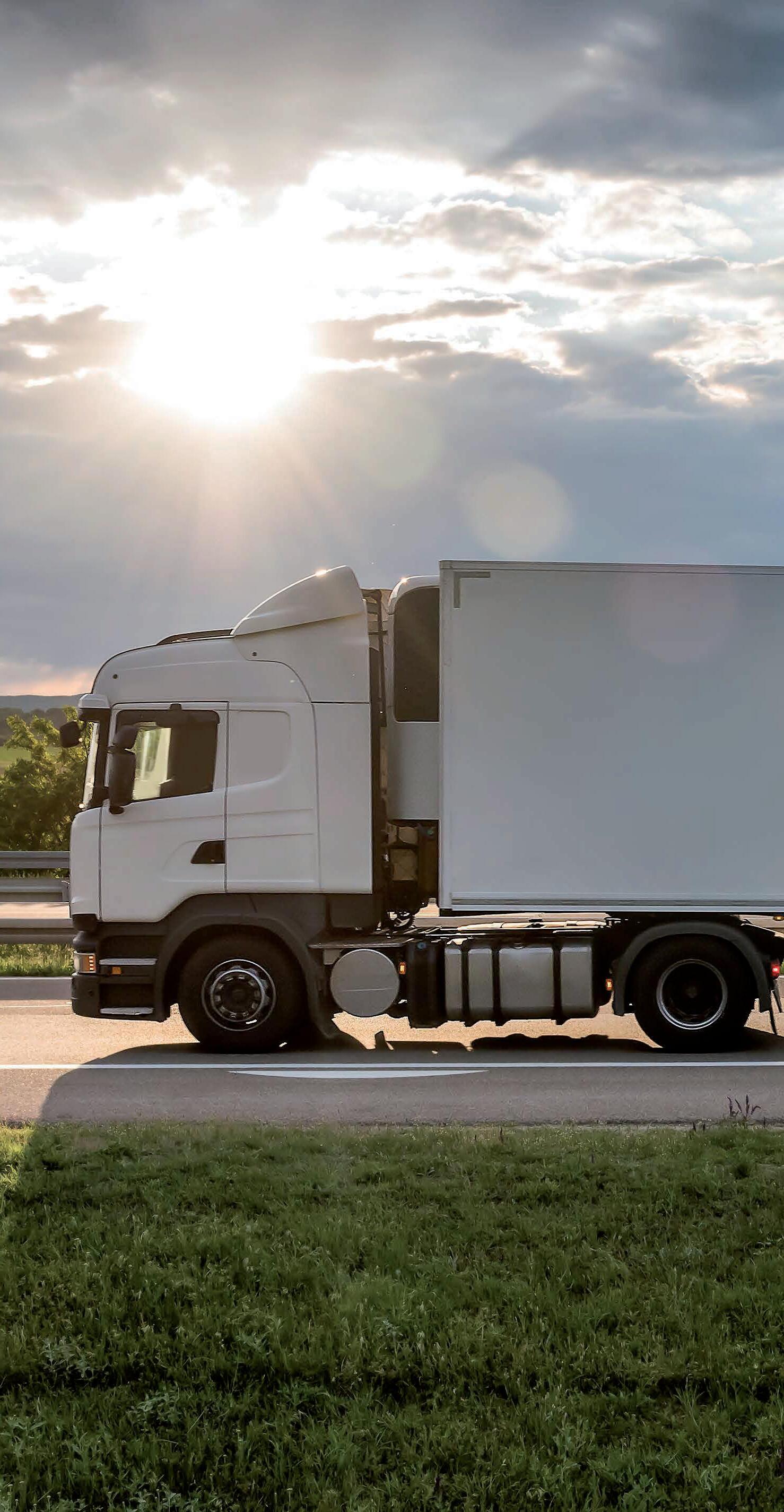

“We’ve gone from servicing one or two customers into that IGA network to a lot
another 15 for another one and ten more for someone else. That all gets packed and wrapped on one pallet and delivered as a full pallet delivery to the store.”
All mobile refrigeration units are supplied by Thermo King. Outside the purview of the cold chain, however, the company also runs two Tautliner B-double sets that carry dangerous goods. The trucks have flattop trailers equipped with 1,000 litre IBCs. A range of acids and alkaline, which these trucks carry, flush the lines of the tanks that are used to clean abattoirs at places like Wagga Wagga and Raleigh.
The DG revenue stream began around seven years ago. Inasmuch as it represents an entirely separate operational service, it runs in accordance with the same regional task the company has, through wise investment, timely expansion and old-fashioned derring-do, since made its own. While it is worth remembering
48 September 2023 FLEET FOCUS
DAF CF450 B-double.


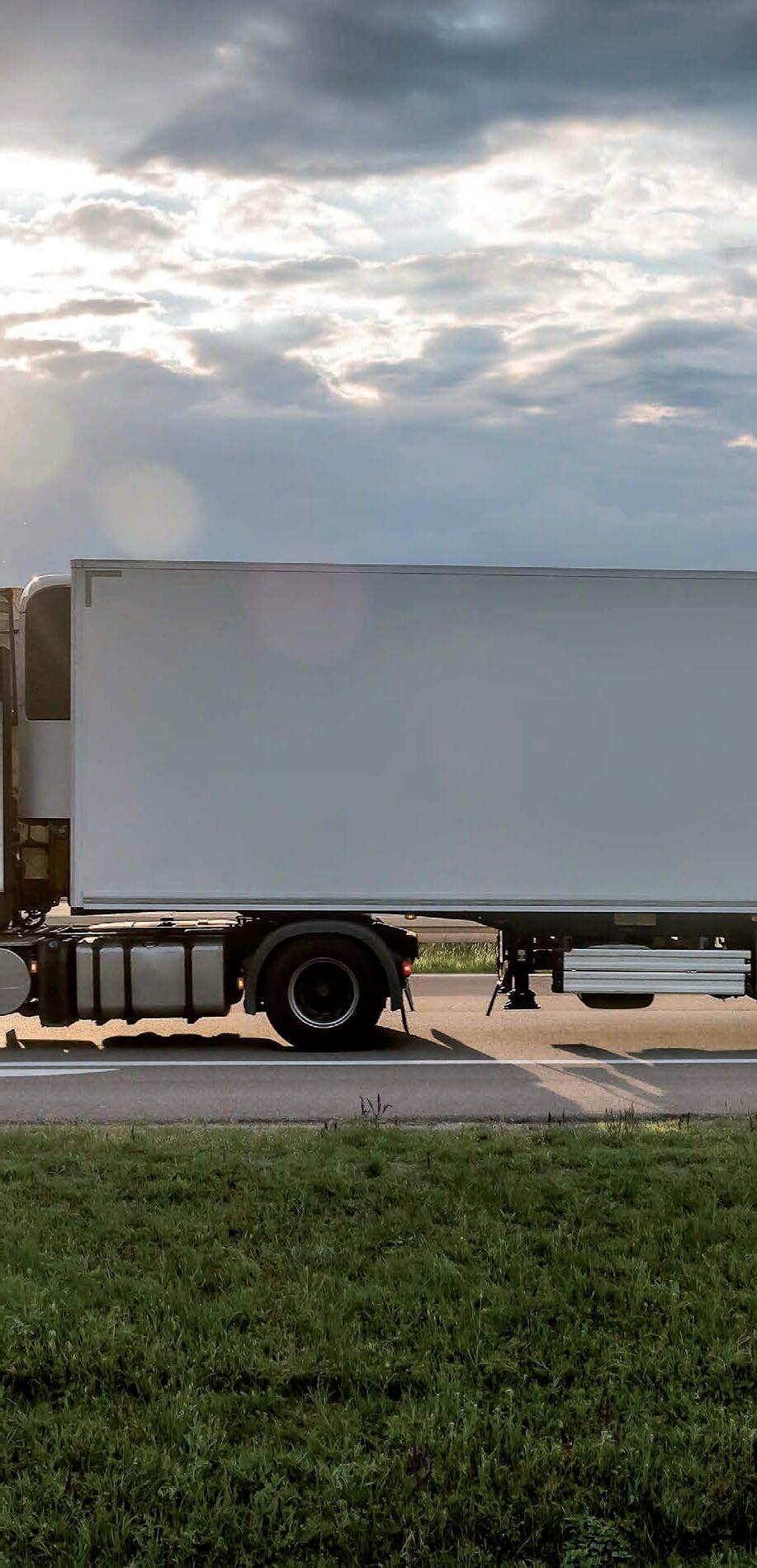
MARKETPLACE ® AUSTRALIA’S DEDICATED ONLINE MARKETPLACE PORTAL FOR BUYING, SELLING AND HIRING TRUCKS AND TRAILERS. Our online marketplace is dedicated to the sale and hire of trucks, trailers and other transport equipment Australiawide. From low loaders and tag trailers to rigid-bodied vehicles and prime movers, you’ll find it here. Whether you’re looking for a deal or keen to sell some high-value assets, we have you covered. For advertising opportunities, contact ben.coleman@primecreative.com.au or call 0466 545 664 BUY. SELL. HIRE. Scan the QR code to find out more.
Established in 1971, Local Mix has grown to be considerably more than a supplier of ready mix concrete to the Geelong area. Local Mix has progressively become a vertically integrated organisation with operations ranging from quarrying and crushing, to recycling construction and demolition waste materials. The company supplies up to half a million tonnes of crushed rock and road base to the Victorian construction industry each

year. Local Mix’s range of equipment includes mobile crushing and screening machines, wheel loaders and excavators and a float to enable their relocation, and various other pieces of plant including a truck-mounted concrete pump built on a Mercedes-Benz Actros. In its quest to optimise operational efficiencies in conjunction with enhanced safety outcomes, Local Mix has developed an innovative truck and dog trailer combination which since its introduction
has aroused considerable interest in the bulk transport industry. The truck uses a rigid Freightliner Cascadia 126 day cab-chassis as its base, but this is not a typical 6x4 setup as the Cascadia’s conventional configuration is enhanced with an additional “lazy” (non-driven) axle located in front of the bogie drive axles creating an innovative 8x4 without the complication of a second steer axle. Rather than being a local retro-fit, the Hendrickson lift up axle, and its
DIFFE DARE TO BE
TRUCK & TECH 50 September 2023
Once disparagingly referred to as “silly wheels”, an air suspended lift-up axle is playing an important part in Local Mix’s latest PBS truck and dog combination.
suspension, were fitted to the chassis as it came down the assembly line at the Freightliner factory in Charlotte in the USA.
In combination with its five-axle dog trailer, the truck operates under PBS and Mass Management regulations with a GCM of 68.5 tonnes, mostly carrying raw materials from Local Mix’s basalt quarry located at Anakie, and sand and gravel from its pit at Moriac, to Local Mix’s concrete batching plants located in Moolap and North Shore near Geelong. “We are carrying four tonnes more payload on every trip than with a conventional B-double, which is close

to ten per cent capacity increase,” says Local Mix Operations Manager, Paul Beretta. “The Cascadia combo replaced a traditional truck and four axle dog trailer combination, and it regularly does four runs per day, so we are moving an extra 16 tonnes per day over the old combo, plus it’s a safer vehicle and we’re getting better fuel economy as a bonus.”
To deliver even more operational savings by minimising tyre wear, the additional axle is lifted off the pavement when the truck isn’t carrying a load.
“The owner of Local Mix, Trevor Richardson, has always had a focus on operational efficiencies, so he was all for
it when we floated the idea of the new Cascadia platform,” says Paul.
The Cascadia is powered by a Detroit Diesel DD16 engine rated at 600hp with 2,050 lbs/ft of torque in combination with the Detroit DT12 Automated Manual Transmission (AMT).
“Being backed by Daimler Trucks is important and we know how good that automated transmission is, which is a big positive,” Paul says.
This engine-gearbox combination immediately impressed the Local Mix team by recording fuel figures of 1.8km per litre in its first month of operation, which is much the same as the truck it
RENT
primemovermag.com.au 51
Local Mix’s innovative Freightliner 8x4 with additional lazy axle.
replaces yet the Cascadia is carrying a significantly higher payload.
“We are extremely pleased with those fuel numbers from a new truck in that application and we know they are only going to get even better in time,” Paul says.
The Cascadia’s safety features include the Detroit Assurance package which includes such functions as the Advanced Emergency Braking System (AEBS), Lane Departure Warning System and adaptive cruise control. Currently, Freightliner Cascadias are the only bonneted trucks in Australia with a driver’s airbag. Local Mix also chose to add the optional Side Guard Assist (SGA) feature, which uses radar to maintain a lookout on any kerbside blind spots and provides audio warnings as well as a yellow warning light located on the kerbside A-pillar to
alert the driver of a potential collision with objects such as power poles or street signs when turning left. The system also provides a warning if the truck is about to merge left into a lane already occupied by another vehicle.
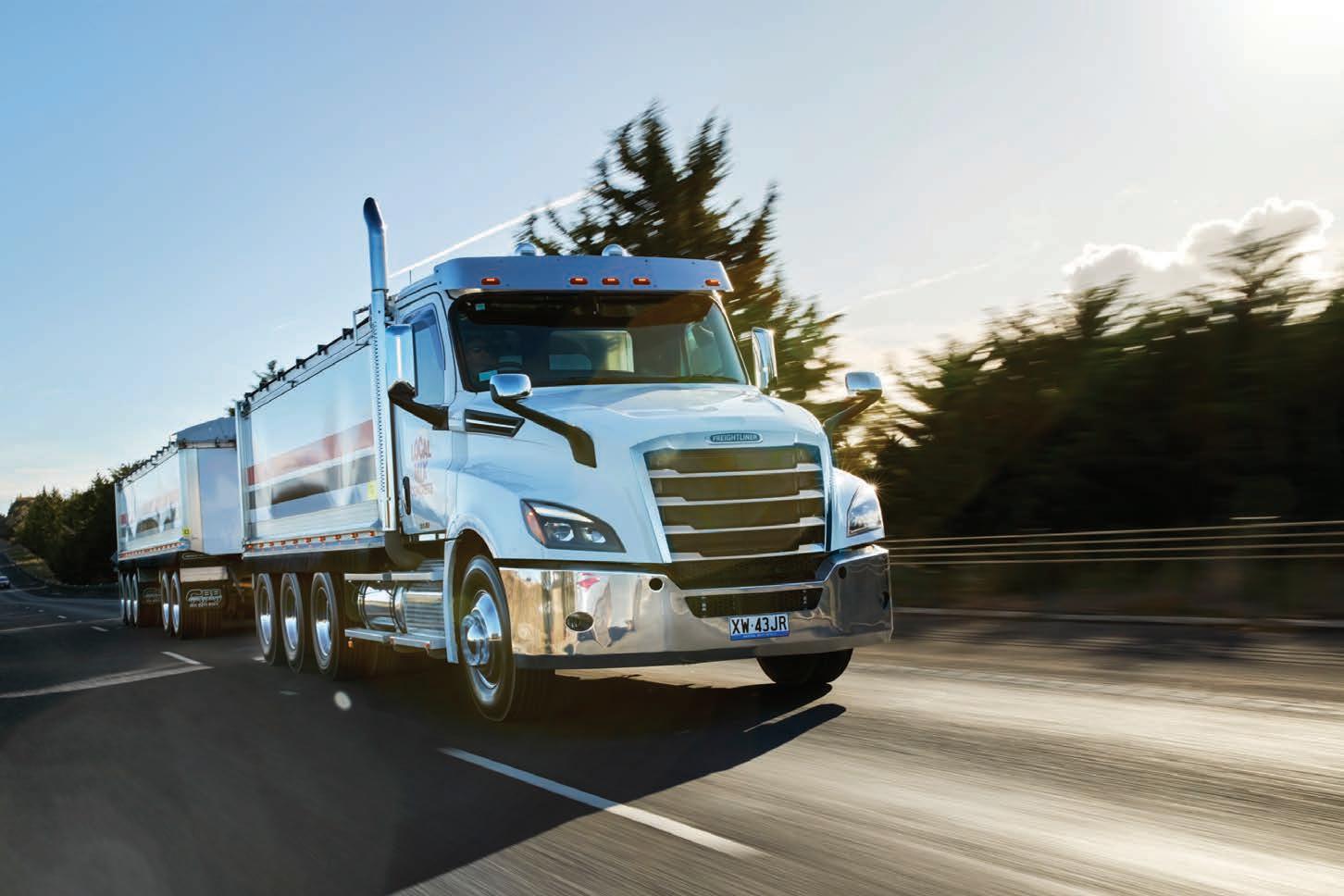
Local Mix also optioned for the bonnetmounted mirrors to further enhance the driver’s vision along the sides of the combination.
The safety factors are considered to be very important by Local Mix, which is a family-owned company based in Geelong, the second biggest city in Victoria.
“Our trucks operate in traffic in Geelong every day, so it is critical that we have the most advanced safety features available to help protect our driver and other road users,” says Paul. “Given the amount of time our trucks are in traffic, visibility
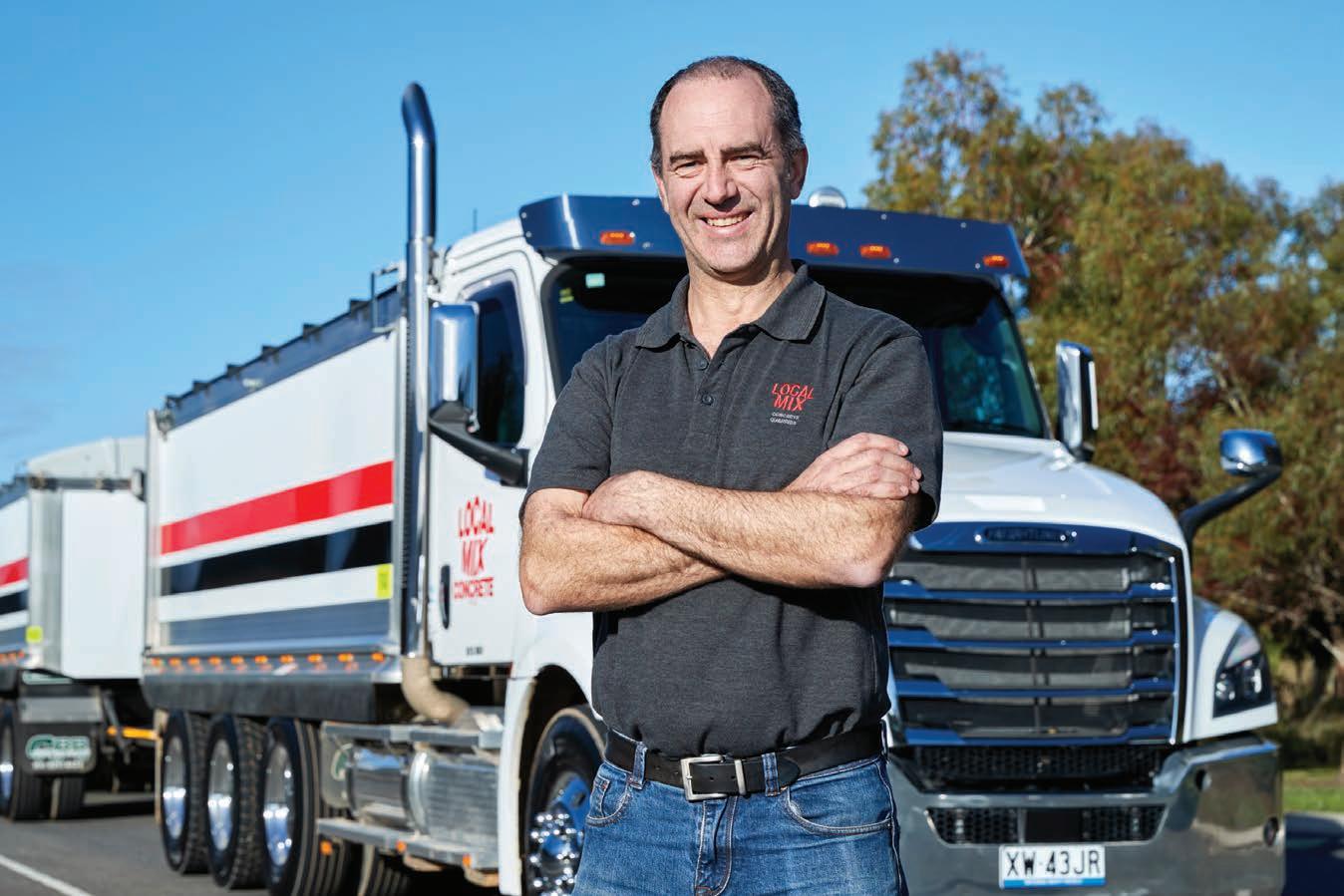
is hugely important and the collision warning and emergency braking systems also get a big tick.”
Each axle load, as it operates under mass management regulations, is required to be measured before departure, which is not a problem at Local Mix’s plants which all have weighbridges.
“Thanks to its increased productivity, the truck is doing less trips to move the same amount of material, which is what PBS was designed for,” Paul says.
The regular driver of the combination is long-term Local Mix employee Cyril Baldey, who, at six feet seven inches tall (2.0 metres), has been surprised at how roomy the Cascadia day cab is.
“Being a tall bloke, I can tell you how much I appreciate the amount of space there is in this thing,” Cyril says. “This truck is so comfortable.”
52 September 2023 TRUCK & TECH
Paul Beretta.
Paul corroborates the testimony.
“When he got in it, he was surprised how comfortable it was because he has had so many issues in the past,” he adds. “Day cab trucks are usually limited for space, particularly legroom, and this truck is really, really spacious.”
The tipping body on the Cascadia and the five-axle dog trailer are products of Chris’s Body Builders in Melbourne. In addition to the recently acquired Cascadia, Local Mix operates an eclectic fleet of truck and dog, semi and B-double tippers using Scania, Volvo and Kenworth trucks. The majority of the company’s 30 concrete agitators are IVECO with some Mercedes-Benz, Mack and Kenworth units also included. With a fleet of this size mainly operating in metropolitan traffic conditions it can be expected that incidents can and do happen, yet most
of the issues are proven by the onboard cameras as being caused by car drivers. Paul himself spent some time driving trucks in Canada in 1996 and was impressed by the strong focus on fuel economy and efficiency over there. “And yet that kind of mindset is not as common here among many Australian operators who don’t seem to pay attention to it,” he says. Paul is aware of some other operators in Victoria who have embarked on a similar 8x4 route and he also sees this particular combination as suitable for other bulk transport applications.
“It would be a no-brainer for grain,” Paul says. “It has better weight distribution than a B-double from the perspective of wear and tear on the road. I think that this set-up could replace a lot of B-doubles.”
Local Mix worked with the team at
Daimler Trucks Dandenong, including salesman Mitch Hynd, to select a truck that would suit the application and fit within the requirements of the PBS and Mass management regulations. The resulting higher payload combination is safer and has a lighter tare weight, less wheels on the ground when it is empty, and is less expensive to register than a B-double.
The Performance-Based Standards (PBS) scheme is built around the basic principle of matching the right vehicles to the right freight tasks as a means of improving productivity, safety and sustainability through adopting innovative and optimised vehicle design. Reduced impact on road infrastructure is another key element of PBS and the Local Mix Freightliner Cascadia combination satisfies all requirements.

primemovermag.com.au 53
Freightliner Cascadie 126 outside Geelong.
NEVER NEVER SAY
A return to the waste industry in the midst of the COVID pandemic was a major success for Ben Harris and Suzanne Magro, who together built Adelaide Liquid Waste Solutions from the ground up with a growing fleet of Isuzu vacuum tanker trucks.

TRUCK & TECH 54 September 2023
Ben Harris, Suzanne Magro and Blake Harris.
It was ten years ago when Ben and his partner, Suzanne, purchased a company under the name of Septic Pumping Services. This marked the beginning of their journey into Australia’s waste industry, as they both held regular jobs before that; Ben was a farmer and Suzanne was occupied with bookkeeping.

“The business came about, so we bought it,” Suzanne says. “At the time it had about 13 trucks. We didn’t know much about the industry, but my family were all involved in interstate haulage. I used to work with my dad, running his office, so I knew about trucks, but not about waste.”
Ben and Suzanne ran Septic Pumping Services for three years until they were approached with an offer by REMONDIS, who was interested in purchasing the business.
“It wasn’t something that we really ever thought of doing, but everything’s for sale at a price,” Suzanne says. “So, it worked for us, and it put us in a good position.”
From there, Ben and Suzanne took a break from the industry for around three years — until they found out REMONDIS had shut down the business it bought from them. This, Suzanne says, gave herself and Ben a reason to come back into the industry.
“That was when we decided to set up Adelaide Liquid Waste Solutions, which was our new branding,” she says. “It was our baby because we had someone else’s before. This time we got to design our own colour and branding which was very exciting. Our trucks look pretty amazing now.”
It was in 2020, right in the middle of the COVID pandemic, when Ben and Suzanne started back up again. At the time, they began operations at Adelaide Liquid Waste Solutions with four Isuzu trucks, two of which were tray top trucks, to transport portable toilets for Bianco Hire, their main customer. Both directors then bought two Isuzu FXZ vacuum trucks from North East Isuzu, and they went to Blade Engineering, based in Adelaide, to manufacture

the tanks.
Before Adelaide Liquid Waste Solutions, the trucks at Septic Pumping Services were always predominantly Isuzus. So, when the time came for a second shot at the industry, Ben knew it was right to carry Isuzu over with the new business. “North East Isuzu’s depot wasn’t too far from us, and we’d always had a good rapport with the staff,” he says. “I’ve known one of the guys there for a long time, so we sort of had that connection, and it made everything a bit easier.”
The trucks in Ben and Suzanne’s previous operations had been very reliable.
“We never had any issues, and all the drivers that we’ve got, most of which worked for us before, are all used to driving the Isuzus,” Suzanne says. “They like them — they’re comfortable and reliable.
“We’ve had a pretty good run with Isuzu since we got into the industry. And, because North East Isuzu was around the corner from our business, it was just convenient for us too. If we had a problem we could just go straight there.” Even now, from where they are based, it’s only 15 to 20 minutes from the depot.
Their latest Isuzu addition to the fleet, a FYH 300-350, is being used for bulk tankering operations. Ben says it’s the largest truck available to complete such operations, for weight reasons, unless you go for a semi-tanker.
“That truck has a 16,000-litre vacuum tank on it specifically built to make sure it’s not overweight,” he says. “Like all of our tanks, it’s made out of aluminium. Whereas normally they’re made out of steel. That’s how we were able to get our weights higher than most trucks on the road.”
Ben has driven this vehicle himself a number of times, and like his workers, he thinks it outperforms in virtually every task.
“It’s comfortable and very easy to operate,” he says. “It’s a nice truck to drive for the size of it. It’s light on steering too, because you’ve got fourwheel steering versus two, so the weight capacity is easier to control.”
Suzanne agrees that the twin-steer unit is a favourite in the fleet.
“All the drivers seem to find it easy,” she says. “They’re all liking it, the ones that have driven it. There’s been no complaints yet. So far, it’s running smoothly.”
primemovermag.com.au 55
Ben at work with the new truck.
The liquid capacity on this Isuzu is the key differentiating factor between the fleet’s previous units. According to Suzanne it has even given Adelaide Liquid Waste Solutions an edge over its competitors. This was also the main reason why she and Ben originally leaned towards the bigger model. “There’s not a lot of companies in Adelaide that, other than a tanker, have a truck that can take 16,000 litres,” she says. “So, it’s good for bulk tankering, because there’s a lot of subdivisions in Adelaide or South Australia that haven’t been connected to sewer and need tankering from one site to another. “We just thought we’d go with the bigger truck. We were going to go with the same as the two we had, the FXZs, but then we decided to get the bigger twin-steer just to give us that edge in

the market.”





The fleet’s attention to detail is another way Suzanne believes it excels in the waste sector.

“I think we do have a massive edge in Adelaide,” she says. “Adelaide’s only small. It’s a bit of a niche market over here. There is probably only half a dozen other companies like us, but we feel like we have the edge now with this new truck.”
The trucks are immaculately presented, well maintained and now feature the company’s new branding.
“Our drivers enjoy coming to work and they enjoy what they do,” says Suzanne. “They keep them clean, and they are always getting comments on how great they look.”
The FYH 300-350, following its initial tasks with Adelaide Liquid Waste

Solutions, recently went for its first post-sale service at North East Isuzu. The registered inspection of the truck, Suzanne says, couldn’t have gone better. “We dropped it off at a certain time, and they had it back to us within the time they said they would,” she says. “So, everything has been good in that regard.” While Ben and Suzanne haven’t planned for any further expansion in the fleet as of yet, they aren’t counting out further investments in Isuzu products.
“I think we’re where we’d like to be,” Suzanne says. “We’re happy where we’re at, but we said that two trucks ago — that we weren’t going to get any bigger, and we did. For now, I think we’d just like to establish ourselves with the six trucks we’ve got for another couple of years. But you never say never, I suppose.”
56 September 2023 TRUCK & TECH
Isuzu FYH 300-350 with 16,000-litre tank.
Don’t do your truck a disservice.






Congratulations. You made a very wise business decision by choosing an Isuzu truck. Now keep that smart approach going and protect your investment by having it serviced at an Isuzu-approved workshop. Our highly trained technicians use genuine parts designed specifically to help your truck deliver its very best performance. You’ll also protect your future re-sale value.

Plus, you’ll have the peace of mind knowing that you’re helping to meet your chain of responsibility requirements.

















































































To find your nearest Isuzu Service Centre, visit isuzu.com.au Care. It’s what we do.











FSA/ISZS1662
LEARNING HIRE
Australia’s two biggest states for land mass, Queensland and Western Australia, are also two of its powerhouses for natural resources. CST Hire, a commercial vehicle hire business, not by accident, has hoisted its flag at sites in each of these markets where it has strategically targeted the construction and infrastructure industries from which it draws its customer base. The company has swiftly built up a fleet in excess of 600 total vehicles including both trucks and light vehicles. Today it carries a variety of commercial brands with UD Trucks an increasing presence. There are now, with the latest two trucks delivered in August, 30 UD units in total. While the majority are Quon twin-steer 8x4s, there is a small selection of UD Croners also available.
As a service-based business, CST Hire must be responsive to the needs of its clients who represent a fast growing and respectable portfolio and include the likes of Spiecapag Australia, Yurika Energy, Wasco Energy, Nacap, McConnell Dowell, Quanta Group, Clough Engineering, Uni-Span, Georgiou and Acciona. The hire fleet they have need to access consists of a
range of service trucks, tilt trays, water trucks, crane trucks, fuel trucks, buses and even utes in an assortment of different wheelbases and cab sizes.
UD have been a key partner since 2017 when CST Hire introduced a UD Condor – its first – into Queensland operations. When UD launched its first Quon 8x4 in 2019, CST Hire jumped at the chance to mobilise the new model whose chief attractions, aside from a wealth of safety features, was most notably the new electronic stability control, a requirement on many projects the business found itself catering to. “Many of our customers were needing it on trucks and it wasn’t available on other brands,” recalls Todd Wilton, CST Hire General Manager. “So that was the main reason we were drawn to it. It was the first mainstream Japanese truck to receive stability control. Some European trucks had it for a while but that was the major attraction for us.”
The UD Stability Control functions via a sensor that detects conditions in which the truck can become unstable, such as curves, uneven or slippery road surfaces. Remote areas of Western Australia often impacted by extreme weather and more recently flood events, can satisfy these
challenging conditions at the best of times. To maintain stability, the system applies control appropriate to engine output and braking power to each tyre. UD has made its Stability Control available on all models. It’s an important concession for customers given that many fleet hire businesses, including CST Hire, actively promote zero injury workplace cultures. At CST Hire this is accomplished by a proactive approach to feedback from employees and contractors, both internally and externally and a continuous focus on improving the work environment as it relates, directly and indirectly, to safety. The acquisition of commercial vehicles can be filed under either category. “The Quon has all the safety features expected of a modern truck,” says Todd. “All trucks come with a host of safety features these days and UD is at the forefront of providing these features as standard fitment.”
The new UD Quon incorporates into its architecture a Lane Departure Prevention function, Traffic Eye Brake, Driver Alert System and a Lane departure warning system. Under-run protection (front and rear) is another safety inclusion designed to reduce damage to other
TRUCK & TECH 58 September 2023
In just a few years the team at CST Hire has, as a business dedicated to vehicle and equipment hire to the mining, construction and pipeline industries, broadened its footprint.
LEARNING

UD
and UD
in
Croner
Quon
Brisbane.
vehicles and their drivers. Meanwhile, a highly rigid cab known as the SAFES CABIN, redirects collision impacts to the rear. Side-door beams, what’s more, improve safety by enhancing interior strength.
Just as CST Hire is conscious, as a company, about offering the best safety options available to its customers, the fleet must consist of quality, fully maintained and serviced vehicles and trucks. Both of its sites, not unexpectedly, run workshops where mechanics are fully trained and have over 50 years’ worth of combined experience.
“We strive to be a complete vehicle supplier in one of the most important sectors within Australia,” says Todd. “By listening to our clients and tapping our extensive industry experience we are developing a fleet of project trucks offering clients an efficient and costeffective project fleet.”

The UD fleet runs on different engine displacement ratings ranging from the 360-horsepower to -410 and -430hp
models. There’s no one size fits all powertrain. The twin-steer UD Quon 8x4 is ideal for crane tilt combination trucks besides water carts, an application it also serves well within the fleet. CST Hire deploys these predominantly in infrastructure projects all around Australia, some of which are in remote areas, characterised by conditions that make serious demands of working vehicles. That the UD Quon is a product proven for its reliability and comfort helps.
“It’s well equipped for the Australian market,” says Todd. “This is why our customers enjoy driving it so much.” Head office is in Brisbane where Todd is also based. He’s been with the business from its inception in 2016.
Prior to that he was working in an adjacent field on the Gold Coast hiring out equipment like motorbikes to tourists.
The company was founded by directors Nick Barnsdall and John Wilton, Todd’s father. It too, as is industry custom, began with a solitary truck before rapid
expansion brought with it an influx of mobile assets.
“Being a small business, we were able to react quickly, and we managed to order stock and build trucks on spec and put them to the market and continue to evolve our product range from customer feedback,” says Todd. “Our versatility is one of our strengths.”
Even from the early days of business, it was clear that project spec vehicles were a niche with major upside as Australia undertook what today remains a massive and ongoing expansion to its infrastructure.
“Our trucks are sort of unique,” says Todd. “They’re not your standard flatbed which you can get anywhere. They have specialised modules on the back.”
The fleet offers short-term hire options for up to a week to longer-term arrangements which are its stock and trade for most of its customers. It also builds projectspecific trucks upon request.
“Some of our customers come to us and say this is the truck we need for this project, and we’ll go and build it and go
60 September 2023 TRUCK & TECH
Todd Wilton.
from there,” says Todd. In order to facilitate these jobs, CST Hire relies on a network of bodybuilding partners that it engages with regularly. In Brisbane they partner with Mini Bodies Engineering and Crane Trucks Australia. On the Gold Coast they use the services of Customer Truck Bodies while in Perth the main supplier is Welding Solutions. Demand continues to outstrip supply for the moment as the equilibrium that was once a luxury of the market prior to 2019 remains ever more elusive.
“There’s a major backlog for businesses waiting on body builders,” says Todd. “Some body builders are booked out 12 months in advance. The lead time on new trucks isn’t getting any better either. It seems like it’s getting worse.”
CST Hire is not resistant to buying from multiple brands to ensure it gets what it needs. This trend, increasing across the industry over the last 12 months, will
unlikely abate any time soon.
“When it was really busy a year ago, we were able to pivot to other suppliers to get more stock in other brands,” says Todd. “If we couldn’t get what we normally ordered we would pivot to a different brand to get what we needed. Manufacturer delays and supplier shortages have blown out lead times, especially when demand was so high, making it a tougher operating environment.”
That was compounded by having such a strong truck market in Australia. Demand, for the moment, is still strong.
“In terms of people wanting to buy them and also rent them there wasn’t enough to go around,” says Todd. “We have seen rental demand has levelled off now that the tax incentive has finished at the end of June and the incentive to buy new trucks has levelled off, too.”

Insofar as constraints on lead times
have limited available stock, quarantine challenges and industrial action at ports haven’t improved matters for many manufacturers. UD is not, however, one of them according to Todd.
“We’ve had no issues getting stock from UD,” he says. “They have been a consistent supplier even in such a volatile market.”
Just over 12 months ago, CST Hire opened its Perth branch as part of a growth strategy. Having a permanent base in Western Australia has allowed the company to work its way into an important market for it going forward.
“We’re constantly growing the fleet and have the capability to supply short term and long-term hires, single vehicle hires through to project fleets requiring over 100 vehicles,” says Todd. “The WA market is a very busy one with lots of mining and mineral and energy projects on the horizon.”

primemovermag.com.au 61
VCV Brisbane’s Stuart Blackmore with Todd at CST Hire’s headquarters.
SHIFTING MORE THAN BOXES
The most common current challenge expressed within the industry is the acute shortage of suitable people to fulfil the multiple and diverse roles required to keep freight moving across Australia. During the Sydney CeMAT exhibition, which is aimed at the supply chain logistics and materials handling industries, Transport Women Australia Limited (TWAL) facilitates an informative presentation by several experts in associated fields with the focus on changing the dynamic to make more people aware of the broad range of career opportunities available.
Hosted by TWAL Director True RossSawrey who is General Manager of Ross Transport, the panel includes Courtenay Skinner who is a driver with Ross Transport, Emma Andrew who is a senior program manager at Amazon, and Lauren Bourke who specialises in procurement, logistics and supply chain personnel at recruitment company TalentWeb. Recent advances in technology are seen as only part of the answer to the shortage of suitable staff, especially in the warehousing and distribution sectors. “There is a misconception that robotics will take over human positions, but we need to look from the perspective of repositioning our roles, not replacing them,” says Emma Andrew. “AI and machine learning are really about improving customer experience, and a lot of roles will shift to areas such as data analytics and robotics technicians.”
In Emma’s estimation, the human aspect will still be required, but mainly to drive change management and
customer experience.
“It’s more about repositioning what the workforce looks like with the introduction of more technology like AI and robotics,” says Lauren Bourke. “I think there is a bit of fear in the industry about jobs being replaced and people becoming redundant, whereas we need to look at how AI tech can actually support us to do the work.”
Courtenay Skinner says the flexibility which is possible in transport is what brought her to become a truck driver, which is a career she didn’t consider while growing up.
“When I was younger, I wanted to apply for the police force in the mounted division because I grew up riding horses,” she says. “It was my uncle who got me into transport. I’d just come back from maternity leave, I was a boilermaker with council and what I was doing wasn’t really fitting in with my family life anymore, so he told me to go and get my truck licence and then he helped to get me a job.”
Addressing some of the many misconceptions about the industry has the potential to encourage more young people to give more consideration to a career in transport and logistics.
“When I started in logistics one of my previous employers said to me, ‘it’s just moving boxes’,” recalls Emma, whose position as Senior Program Manager at Amazon includes third party transport and the roll out of alcohol deliveries nationally. Shifting the stigma that the jobs are merely doing the same thing repeatedly is an important early step in changing perceptions.
“It’s so much more than just moving boxes,” Emma says.” It’s about analytical knowledge that we can put in to make decisions, how we can innovate to drive different customer experiences, how we can improve our speed, how are we going to build our driver pool, how are we going to help our drivers to create more convenient rosters, and all the supply planning that goes into it.
“We need to create the awareness that we have different roles all with specific skills, and we are trying to articulate what those skills are and how they translate into a role within the supply chain and transport and logistics industries.”
The ‘moving boxes’ perception needs to be countered and school students be made more aware of the quality career paths available in the industry. School and third-party careers advisors are finding ways to leverage internships and apprenticeships to create more pathways to enable school leavers to gain an appreciation of the industry where opportunities are not restricted to driving roles and there are more diverse offerings in areas such as administration and customer service and the ever-expanding digital areas.
“When we are talking to the younger generation, particularly females, we are not actually selling the benefits of the industry,” says Lauren. “One key success that we had at a school expo was a truck driver who was actually a former make-up artist. She’s wearing her hi-vis, she’s got her black safety shoes on and at the same time she looks fabulous and she’s making six figures as a MC truck driver. To young women that is an ‘Oh wow!’ revelation.”
INDUSTRY 62 September 2023
A panel of expert women examine some innovative means of encouraging a broader range of people to consider a career in the transport and logistics industry.
This diversity within industry roles is seen as important to attracting interest from females.

“I’m a female driver and you can be a woman and still be in this industry, especially driving trucks,” says Courtenay. “But you don’t have to take femininity away, you can still be ‘girly’ and ‘you’ if that is what you want to do.”
A passionate advocate for the industry herself, True Ross-Sawrey sees the many possibilities.

“The way to get people into the industry is via awareness, by promotion and by
a positive view of the industry. We’re typically perceived as just a dumb truck driver but that’s not the case at all,” says True. “All of us have to constantly strive to advocate what the industry actually is and what we actually do and how essential we are and how many jobs there are and how much money you can make.”
TWAL Chair Jacquelene Brotherton urges industry recruiters to look beyond the usual targets for personnel in order to contribute to a sustainable workforce.

“We really need to be innovative in how we recruit, how we train and how we
retain people,” she says. “Women and youth alone are not going to solve our problems in the supply chain, we’ve got to look further than that.”
The focus, she suggests, can be put on various groups including the refugee community and immigrant groups, such as Sikh communities to create awareness of the industry’s opportunities.
“This is a hidden industry,” adds Jacquelene. “People don’t realise how technologically advanced it is with factors such as trucks, robotic forklifts, and parcel sorting.”
primemovermag.com.au 63
Emma Andrew, Lauren Bourke and Courtenay Skinner.
Jacquelene Brotherton.
True Ross-Sawrey.
NOWHERE TO RUN
as especially vulnerable across Northern and remote Australia.
Increasing disruptions by adverse weather events, poor maintenance and rising demand for road freight services are compromising food and fuel security, strategic defence operations and economic development according to two of Australia’s peak transport bodies. Western Roads Federation (WRF) and Northern Territory Road Transport Association (NTRTA) have called on the Federal Government to establish a joint industry taskforce to build greater resilience for major freight networks, which they see
The peak bodies cited the impact of climate events on the state of the road networks as a mounting concern given there are usually no alternative roads for trucks to use. As a result of the impacts on road networks across the North and Northwest, WRF and NTRTA reveal that freight costs have skyrocketed at a time when all Australians are suffering a costof-living crisis.
The WRF and NTRTA’s call for a joint taskforce flows from what they describe as hard-won lessons dealing with major road freight disruptions (road and rail) over recent years, ranging from bushfires, floods, COVID-19 and even the on-going loss of a key bridge. According to the WRF and NTRTA, multiple government reports are converging on the same issues. CSIRO modelling shows critical freight routes
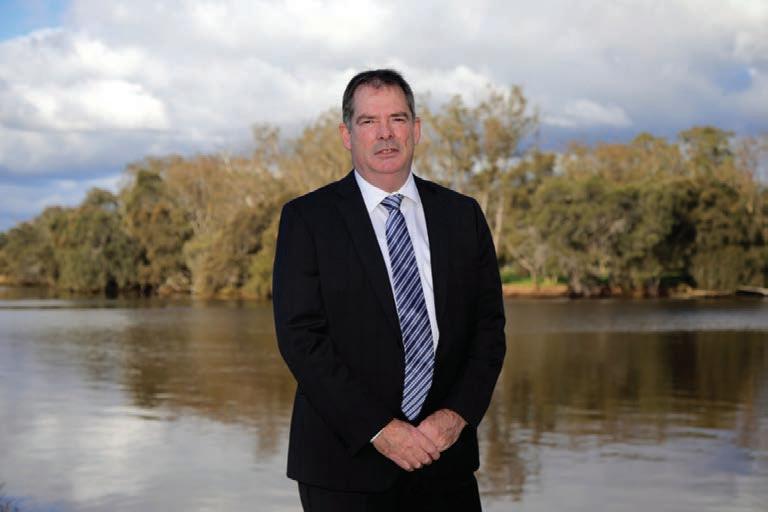

to the north of the country as having high or very high vulnerability risks. It must be noted that the CSIRO modelling derives from scenarios visualised by its Transport Network Strategic Investment Tool in partnership with Australian Climate Service (ACS) whose stated purpose is to better prepare Australians for natural disasters before they happen. As the ACS interacts with its own customers and partners to generate data, it remains to be seen as to how much of the findings will be driven by science or defer, rather, to scientific consensus, as was the case for COVID-19 policies at the state levels. Be that as it may, there are other primary sources at hand.
The BITRE Road and Rail Resilience Report 2022 identified that “the lack of a single, overarching national approach to address gaps and emerging issues in the transport context presents a risk
INDUSTRY 64 September 2023
A high productivity freight vehicle negotiates floodwaters in Western Australia.
Calls have come for the establishment of a joint taskforce to shore up vulnerable freight networks in Australia.
Cam Dumesny.
to supply chain resilience.” While a Defence Strategic Review outlined that a “central component of deterrence is resilience,” and noted “Australia’s deterrence efforts sit within a wholeof-government framework.” Much of this relies on harnessing all elements of national power which included “robust national logistics”.
An outline of several actions that might assist in helping to make these freight networks more resilient has been put forth by WRF and NTRTA. The increasingly frequent loss of the Perth – Kimberley – Darwin freight route due to flooding, at present, means that roadtrains need to be sent via Port Augusta in South Australia then up to Katherine in the Northern Territory then back into the East Kimberley. A return distance equivalent of driving one way from the English Channel at Calais to Vladivostok on the Sea of Japan. However, to meet freight volume needs cost-effectively, the transport industry must negotiate each time for it to allow triple roadtrains on the detour route. This requires negotiation with the Western Australia, South Australia and Northern Territory Governments, as well as with the National Heavy Vehicle Regulator in SA on permit and operating conditions for the transport. Concurrently, approvals then need to be sought from either State or Federal Government’s to cover the additional

freight cost, rising by 80 per cent in some cases, so that the costs aren’t unfairly worn by the local communities. Standing arrangements, as part of a short-term recommendation, need to be made such that both approvals and subsidies can be immediately activated by a delegated authority.
In regard to longer term actions, considerations for re-building warehouse and storage in vulnerable regions need to be made so they can continue to supply communities and businesses until an adjusted freight supply is implemented and to educate the public not to ‘panic buy’, to alleviate further stress on logistics supply systems. Agility also needs to be built into the logistics system, such that the loss of a single route doesn’t create up to 6,000km detours.
“Achieving this will require accelerating new identified road freight routes, hardening of vulnerable parts of the network, investigating the role of coast shipping and multi-modal hubs in regions,” the joint statement notes. Speaking at the Developing Northern Australia Conference 2023 in Darwin, NTRTA Executive Officer Louise Bilato, said a nationally-led joint Industry and Government Taskforce would help deliver a resilient, sustainable freight network across vulnerable parts of WA and the NT.
“The freight industry has learnt the hard
lessons through the pandemic and why the nation needs a network of resilient roads which secure supply chains across the nation,” Bilato says. “As a nation, we need to ensure that essential foods, fuel, medicines and groceries can be transported uninterrupted to communities and businesses in regional and remote parts of the country.”
WRF Chief Executive Cam Dumesny, says the Commonwealth Government’s Defence Strategic Review had brought renewed focus on Northern Australia. However, Northern defence bases and capabilities will require logistics support from the South as he views it.
“Any sustained military defence operation in the North or Northwest of Australia will depend on civilian road transport and logistics operators to help sustain supply operations, but we question how we’re expected to meet the demands of defence given our challenges supporting civilian communities and businesses now due to increasing freight disruptions?”
Dumesny agrees with the Defence Strategic Report which identified the need for a ‘robust national logistics’ system.
“But support to the North is built on a fragile logistics system. WRF and the NTRTA are offering to work with the Federal Government on a joint Taskforce to contribute the hard learnt lessons of the transport industry.”
primemovermag.com.au 65
It’s no secret that data analytics can be used to develop a robust risk management strategy for fleets in the commercial road transport industry. What’s perhaps less apparent to many businesses in the sector is how the proficient application of data can optimise the areas that matter such as fleet performance, driver safety and wellbeing, and, most noticeably, reducing insurance claims frequency. Zurich works closely with customers in several ways to provide risk prevention and mitigation advice. Motor risk assessments and leveraging key partnerships with data analytics companies like Fleetyr can help fleets make better use of their data, which in turn, should result in better driver safety outcomes and operational improvements.
Maximising the benefits of data analytics can be achieved by knowing which data sets to assess and how to analyse it. For useful insights on risk and resilience, there are a growing number of data sets available that can be interpreted in isolation. But often, as Mervyn Rea, Head of Zurich Resilience Solutions (ZRS) observes, data needs to be cleaned and when it is merged with other forms of
data, the insights become much richer. “This is where our partners at Fleetyr come in,” he says. “In a modern fleet, data sets can be derived from telematics, other on-board technology, engine management systems, fuel cards, OEM specification data, GPS tracking, claims records and vehicle infringement data.”
In this way Fleetyr can offer precise insights that help businesses create a safer, healthier, more cost-effective fleet. The actionable insights created are often far-reaching according to Tim Hill, CEO at Fleetyr.
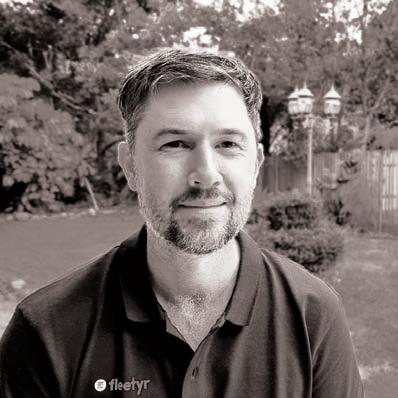
“We use whatever they have, push it together, clean it and turn it into usable, structured data,” he says. “For us, though, our primary focus is the utilisation of assets. Everything starts and ends with utilisation. If you have appropriately utilised vehicles and assets, areas around running costs, emissions, operations, and safety are already made easier. There is a very high chance that you have too many vehicles in your fleet.”
Not only does ‘dirty data’ create poor choices, but it can also significantly affect operational integrity. As there are no actionable insights with inaccurate data and reporting, Fleetyr connects multiple datasets and cleans them. If the vehicle
engine hours and odometer readings are incorrect or misaligned, for instance, how can a fleet properly schedule maintenance? To go ahead and schedule the maintenance without knowing the error operationally is to court trouble according to Tim.
“If you under-maintain the asset, you open yourself to safety issues, compliance, and costly breakdowns,” he says. “If you over-maintain the asset, cost and availability will become the problem.”
Looking at Fleetyr’s customer data during its first three months of using the platform, it was found that fleets consisting of light commercial or yellow plant vehicles have 1 in 3 vehicles that have been stationary upwards of 45 days in a 90-day period. From the perspective of efficiency, simply reviewing and
HEAVY VEHICLE INSURANCE SHOWCASE 66 September 2023
FLEET
Zurich offers actionable insights that can assist businesses create a safer, healthier, more costeffective fleet.
FIRST
Tim Hill.
data resides. This can be salvaged through telematics data, and/or engine management, maintenance and fuel card data. A multi-layered analysis can, alternately, monitor driver behaviour. “A fairly simple analysis of fleet asset data relating to tyres can lead to economic efficiency and improve safety,” says Mervyn. “If additional driver-related procedures and remedies are implemented, this will improve safety, reduce crashes, increase business efficiency and avoid uninsured costs.”
Both ZRS and Fleetyr, to this degree, are complementary yet very different.
ZRS uses Fleetyr for its data cleaning and analysis expertise to help customers improve fleet efficiency and safety. Combining multiple datasets is critical to continuously improving safety and efficiency according to Tim.
“You might use telematics, OK, no problem, you will get some insights out of this,” he says. “But combining your telematics data with other safety software and hardware like pre-start apps, fatigue monitoring, and maintenance records creates a higher level of safety analytics.” Looking into fleet efficiency is similar wherein combining multiple datasets like fuel, maintenance, and telematics and enriching it through, say, Fleetyr, with other data such as benchmarking fault codes and fuel economy, for two examples, will help fleet managers find anomalies in their fleet such as underutilised vehicles and high running costs.
Zurich’s claims analysis tool, Z Fleet Navigator (ZFN), enables a fleet manager to analyse their claims data and trends by types of incidents, age of driver, time of day, day of week, vehicle class, company division, and state of loss among others. In total there are over 30 reports which can be downloaded and analysed to identify trends which can be used for deeper analysis and corrective actions. ZFN also has the capability to benchmark a Zurich customer’s claims in comparison with their industry peers
(similar size and type of fleet) as well as all of Zurich motor fleet policies (portfolio) over a period of the last three financial years. The data is displayed in graphical form which is easy for a fleet manager to interpret and gauge where their performance sits for the likes of average cost of claims; average frequency of claims; frequency of claims including top 5 descriptions of loss (hit in rear, reversing, lost control, hit stationary object); percentage of cost for top 5 descriptions of loss; and average cost of claims for top 5 descriptions of loss (overturning or tipping, theft). Examples are plentiful where the analysis of data, particularly relating to driver behaviour, can lead to a reduction in crashes. But only, Mervyn Rea points out, if the data is used to highlight improvements, that when implemented, positively modify driver behaviour and actions.
“Using data in this way, often, but not limited to telematics, has seen businesses reduce their crash frequency by 20-40 per cent,” he says. “Reducing crashes also reduced uninsured costs, and by keeping a fleet on the road, it ensures that the business is more resilient and customer focused. All of this is only possible by clearly understanding and analysing the relevant data, determining the best course of action, and implementing improvements.”

primemovermag.com.au 67
FIRST
Mervyn Rea.
AWARE SITUATION
There isn’t any way to sugarcoat it. Truck accidents are traumatic, and even the minor ones can leave drivers shaken and causing major disruption to the business while the vehicle is out of operation. The subsequent insurance claim is often the farthest thing from the

driver’s mind — as it should be. With its award-winning claims system, NTI is ensuring the welfare of drivers comes first and that they get back to work as quickly as possible.
“Our primary concern is the safety of the driver,” says NTI’s Head of Claims Operations, Mary-Ann Van Rensburg.
“By being involved from the time the call is made from the accident scene, we can work with our network of service providers to assist the driver by providing access to professional nursing services, repatriating the driver to the nearest accommodation or transport home, and access to trauma counselling
HEAVY VEHICLE INSURANCE SHOWCASE 68 September 2023
Taking the stress out of an already stressful situation is a priority for Australian transport and logistics insurance specialists NTI.
Insurance claims are an inevitable fact of life.
AWARE
post accident when required. Whilst this is happening, the NTI team are busy arranging the recovery of the vehicle, clean up of the accident scene, and opening up the roads again.” But claims, and the paperwork involved, is an unfortunate inevitability and can be fraught with obstacles. This is why NTI has taken the claims process and redesigned it into their own unique solution.
NTI’s first step was distinguishing what the pain points in the process were and reducing as many of them as possible. The outcome was a clearer understanding of its customers’ needs, as well as recognition that, just like no customer is the same, every accident is unique.
“We have a dedicated internal incident response team that works closely with all relevant stakeholders to activate the appropriate response, all starting from the accident scene,” says NTI Head of Claims Services, Tim Pontifex. “We’re all about reducing any stress and effort and making the aftermath of a traumatic event as seamless as possible.”
The incident response team is all part of an integrated approach that combines both internal and external expertise, all working together towards getting customers back to work. Among the advantages of this process is an in-house, 24-hour national service centre that provides an Accident Assist Service seven days a week. A dedicated repair manager
keeping the downtime to a minimum.” That understanding has resulted in NTI getting noticed within the industry. The company has recently been awarded the Mansfield Award for Specialty Insurance. The award recognises excellence in claims within the Australian insurance industry and are awarded based on surveys completed by insurance brokers, policyholders, and repairers.
NTI has built up a national network
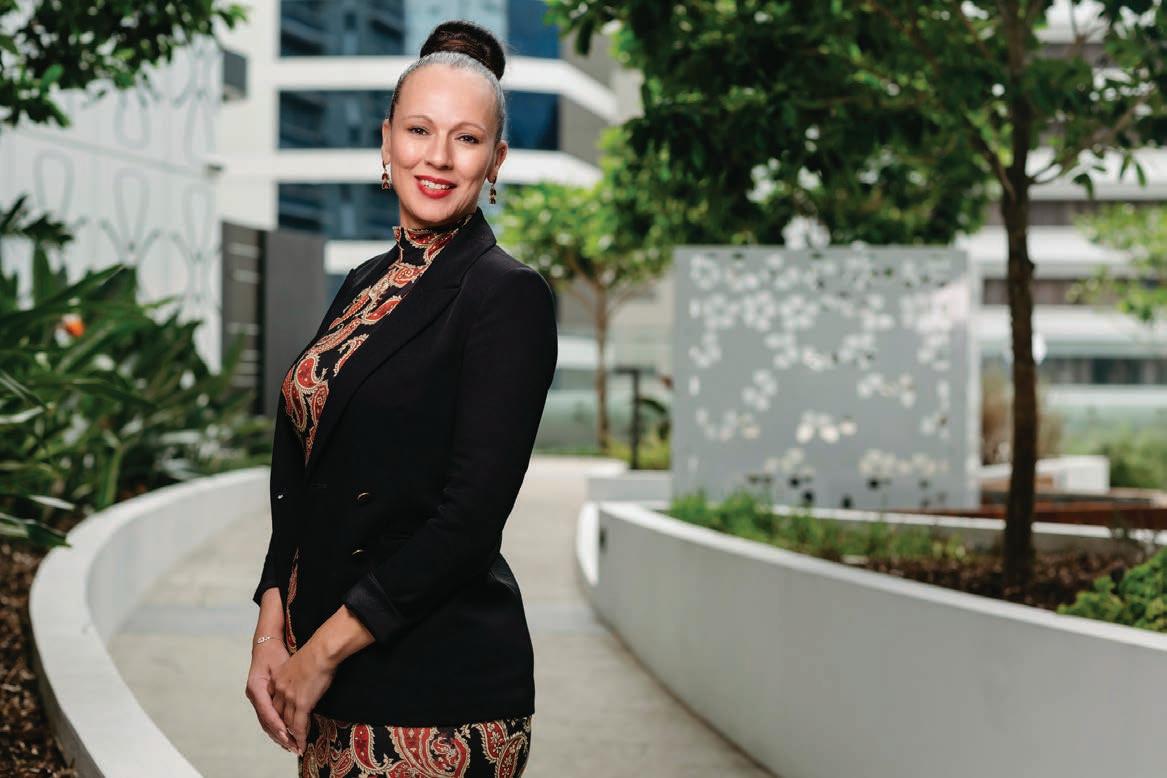
road is a cost to the client. Part of the reason for its quick turn-around time is that NTI authorised repairers don’t require an official assessment on vehicles before beginning repairs and can begin ordering parts immediately.
Other benefits NTI can offer include its own parts division, offering a costeffective and time-saving option for repairers. It also provides a lifetime guarantee on all authorised repairs.
primemovermag.com.au 69
Tim Pontifex.
Mary-Ann Van Rensburg.
THE POWER OF
ONE
The Fuso Shogun 510 has been a success in a number of guises and now a tipper showcases the capabilities of Australia’s most powerful Japanese truck.

TEST DRIVE 70 September 2023
The accelerator can be used to to shuffle the drive between forward and reverse on the new Fuso Shogun 510 tipper.
Decades ago, there was a catchy marketing phrase used in relation to a Japanese car which, for the time, was rather pretentiously pitched at customers more inclined to consider European brands.
“When your heart says Europe…but your head says Japan” resonates as a very apt position for the Fuso Shogun, even more so now that it is available in a categorytopping 510 horsepower specification. However, it doesn’t all have to be about horsepower, as the Fuso Shogun is also able to be specified with an 8-litre engine with 360hp, an 11-litre with 400hp or 460hp outputs as well as the 13-litre rated at 510hp. The Shogun 510 has been specifically developed for the Australian and New Zealand markets and its genesis was helped along due to some very concerted pushing by local management. The power output of this truck is identified by a discreet badge on the front panel plus, in case anybody misses that, the not so subtle graphics applied prior to the truck’s display at the Brisbane Truck Show announce to the world how many horses are under the cab. The availability of a driveline based
cemented the Fuso Shogun as a serious contender in the Australian Heavy Duty truck market. The engine’s maximum torque of 2,500Nm is available from as low as 1,100rpm with 84 per cent of the maximum torque still available at 1,700rpm. At the other end of the torque curve 86 per cent of maximum torque is available at as low as 800rpm. The maximum 510 horsepower is developed at 1,600rpm and much of the engine’s performance and flat torque curve can be credited to its finely developed high pressure fuel system in combination with the asymmetric turbocharger.

The engine is Euro VI compliant and uses a Diesel Particulate Filter and AdBlue exhaust aftertreatment drawn from a 60-litre tank.
Fresh from its debut at the 2023 Brisbane Truck Show, this Fuso 510 tipper brings with it the lightest tare weight of any 500-plus horsepower tipper currently on the Australian market. Prime Mover has previously sampled the 510 Shogun in single and even B-double combinations. This, however, is the first time we’ve been behind the wheel in its rigid configuration.
Complete with the steel tipping body and
This 4.3-metre wheelbase tipper has been ‘put together’ by the Daimler Trucks dealership located on Queensland’s Gold Coast, which also has arranged for a local bulk building material supplier to loan us an eleven-tonne load of sand to bring the gross weight up to just over 22.5 tonnes which may be well under the 26-tonne GVM yet can still provide a realistic load for the exercise of this test drive.
This Shogun has been fully set up for a tipping dog trailer operation, but as most people in the industry are aware, the current waiting time for a new trailer is almost as long as the line for new trucks. Thus, we can only speculate how well the 510’s 2,500Nm of torque is capable of handling up to the GCM of 63 tonnes. Recalling experiences with the 510 hauling a B-double set at close to maximum GCM, it doesn’t require a lot of imagination at all as the tipper version handles the short, yet challenging hills around the Gold Coast Hinterland near the town of Canungra with ease, rarely shifting lower than ninth gear on the ascents despite not always being able to build good momentum at the base of the climbs, some of which are 14 per cent grades. The roller coaster roads also provide a
 The digital dash includes customisable satellite navigation to suit trucks.
The digital dash includes customisable satellite navigation to suit trucks.
the operation of the brake, it has an impressive maximum retardation power of 411kW. Although it will change down gears itself when descending the steeper hills, a nudge on the transmission selector will also cause the gearbox to drop down a gear or even two ratios to maximise the effect of the engine braking.
In sections of road where the Shogun’s torque isn’t fully needed, the Eco-Roll feature now common on most automated manuals makes its own contribution to fuel efficiency and reduces noise in the already quiet cabin even more as the driveline temporarily disconnects itself. The transmission also has a “rock free” mode which, when activated, uses the accelerator to shuffle the drive between forward and reverse in an effort to get the truck back onto solid ground should it become bogged. This is a handy feature to have in a rigid tipper applications and limited slip diffs are also available as an option.
The suspension consists of taper leaf springs with double acting shocks at the front and Fuso’s trailing arm electronically controlled four bag air suspension at the rear, also with double acting shocks,
combination delivers a smooth ride across a variety of surfaces and differing road cambers.

The all-steel cab is suspended on air front and rear. In combination with the air suspended driver’s seat and the leather trimmed steering wheel, it provides a high standard of comfort. This Shogun also has the “Premium” badge on the dash which explains the purpose of the faux carbon fibre interior trim which is such a refreshing change from the dolphin grey that Japanese trucks have used for decades. The digital dash incorporates a trip computer with a multi-media unit off to the left which includes customisable satellite navigation to suit trucks. Other cab features include climate control HVAC, central locking, electric windows and automatic rain sensing windscreen wipers, as well as halogen headlights that switch on automatically as well as auto dip to LED low beam when approaching vehicles are detected. Another nifty feature is the key fob and stop/start button combination.
The Fuso Shogun has, as standard equipment, an impressive suite of safety features including its Advanced Emergency
Braking System which uses a combination of radar and camera to deliver an enhanced pedestrian sensing capability that will bring the truck to a complete stop if the driver doesn’t respond to the initial audible warning. There aren’t many pedestrians on the test route, so we’ll remain confident that the system operates in the background and is able to do what is required of it should the circumstances arise. Other safety systems on the acronym list include Adaptive Cruise Control (ACC), Lane Departure Warning System (LDWS), Electronic Stability Program (ESP) and the Hill Start System (HSS). There is also a driver’s airbag and Fuso’s Active Attention Assist driver monitoring system which uses a facial recognition camera located on top of the dash in combination with data from systems such as lane departure warning to assess driver behaviour related to fatigue and low levels of concentration.
More power and torque with less tare weight is an equation that should endear the Fuso Shogun 510 to customers for a variety of applications. Its high level of safety features and driver-friendly operation significantly contribute to the Shogun 510’s business case.

72 September 2023 TEST DRIVE
This Fuso 510 tipper features the lightest tare weight of any 500-plus horsepower tipper on the local market.
SAFETY APPLICATION TECH
ADVERTISE IN OUR NOVEMBER 2023 PRODUCT SHOWCASE ON SAFETY APPS AND TECHNOLOGY.

BOOKING DEADLINE: 29 SEPTEMBER 2023
The capture of operational data in the vehicle and the transfer of that data into a computer program that can analyse it and produce reports has made safety and driver monitoring technology one of the key recent trends in industry where fatigue events and their risk mitigation are critical to compliance and mandatory reporting requirements. A gamechanger for enhancing operational efficiencies such as fuel cost reductions through optimal driving styles, the utilisation of driver scores to measure and ensure safety, maintenance planning and even data integration from all parts of the business, driver monitoring technology, along with the dashcam, can also reduce the financial burden of accidents and assist in insurance claims. Get involved in our upcoming showcase on safety applications to inform potential customers of how your solution can change their world for the better.

Delivery Magazine inside: Pages 78-89. SEPTEMBER 2023 primemovermag.com.au ® September 2023 ISSN 1838-2320 9 771838232000 08 SEPTEMBER 2023 $11.00 THE PEOPLE & PRODUCTS THAT MAKE TRANSPORT MOVE INDUSTRY Carrier: ColdRex Logistics Spotlight: Local Mix Showcase: Heavy Vehicle Insurance Personality Profile: Lauren Pulitano INNOVATION Fleet: Shaw’s Darwin Transport Linehaul: AJM Transport Test Drive: Fuso Shogun 510 tipper Delivery: FedEx ASHLEY.BLACHFORD@PRIMECREATIVE.COM.AU | 0425 699 819 TO BOOK IN PRIME MOVER CONTACT ASHLEY BLACHFORD NOW ®
Waverley Forklifts Pole Position
JEWELS FAMILY
Record sales figures and a major historical milestone are cause for celebration at UD Trucks Australia whose Vice President, Lauren Pulitano, is understandably excited by what the future might hold for the brand.

Prime Mover: Prior to your role with UD Trucks you spent a number of years at Volvo Buses. What are you looking forward to?
Lauren Pulitano: Brisbane was my first official truck show with the UD brand. I am so excited coming off the back of a record year, which followed on top of
another record year, and we’re on track to have another one this year if the first two quarters are anything to go by. It’s now 50 years in Australia for the UD brand so the team is pumped and there are so many exciting things happening.
PM: What’s the main challenge?
LP: The industry is the biggest we’ve ever had in Australia in terms of 15,000 new Heavy Duty trucks last year, and it’s pumping again this year so it’s actually how the body builders and the other technicians can cope with the extra sales. It’s not just for UD Trucks, the situation is industry-
wide. If we could magically click our fingers and pump them out, there’d be more UDs on the road.
PM: Did the sunset of the instant asset write off tax incentive have much of an effect on sales?
LP: At the end of the day trucks are important to Australia and the nation needs trucks whether there is a tax incentive or not. Organisations and transport companies are going to have to replace their trucks with new ones, and they’re going to have to grow their business with additional ones.
PERSONALITY PROFILE 74 September 2023
Lauren Pulitano, Vice President of UD Trucks in Australia speaks to Prime Mover as the brand is set to celebrate its 50th anniversary in the local market.
PM: UD Trucks was acquired by Isuzu in 2021. Do you see any complications as the situation develops?
LP: The situation is not so unusual because there are lots of examples in the automotive industry where there is the same parent company and then two, three, even four brands, and all fiercely competitive.
PM: Are we going the get the 13-litre engine by UD Trucks in Australia?
LP: Not in Australia. Obviously, it’s been launched in the Japanese domestic market but not in the Australian market.
PM: And yet another un-related Japanese competitor has a 13-litre available here?
LP: Big isn’t always better. If you have
a look at our 11-litre and especially the enhanced 11-litre with the improved torque and extra horsepower, I’d say buyers would comfortably pick up a UD Quon over others.
PM: In the categories where UD operates, is there anything which can be done to better satisfy the current demand?
LP: The joy is there are markets such as Australia which are booming, whereas there are other truck markets which aren’t booming, so they can move around and figure out where to supply. From a prime mover perspective, our Quon GW model for example, we can get a lot of them in, and they don’t have to go to body builders or anything like that. Even if they don’t require a body there is still some constraint with the local industry supplying components such as bullbars. We are really committed with our rigid trucks to get support from the Australian body building industry. We may import our cab-chassis from Japan but I’m a big believer in supporting the local industry as well. It’s tough at the moment when we are in a sales boom, but it’s not going to be that big forever.
PM: Australia is building roads and major infrastructure projects such as the Inland Rail. Is the construction industry, including the 8x4 spec, an important part of the mix of applications for UD?
LP: Absolutely. From the UD Trucks perspective, and together with our Australian dealers, it’s not just concrete agitators, but a lot of our trucks go into other heavy construction applications as well. We’ve got the Olympics coming up in Brisbane in 2032 so there will be a lot of construction projects going on and the Federal and State Governments have committed to many other rail and road projects. Construction in Australia is year-round and for the UD brand that’s a major part of what we do. The finance sector is saying that approvals for new housing has gone down, but it’s widely accepted there’s a housing crisis, so we
are going to be doing more construction in Australia, making it perfect timing to have our 8x4 agitator models out there.
PM: Is there much in the UD Trucks’ pipeline around technologies such as alternative propulsion and autonomous vehicles?
LP: There certainly is. It’s no secret that UD for a couple of years now has been busy developing the Fujin and Rajin (Wind and Thunder) Vision 2030 project. They’ve been busy working on it and have trials happening, which is exciting. I can’t say when it’s going to be here in Australia, but I can tell you one thing I have really loved about the UD brand is innovation. It’s what they do. They take on challenges and they have the position of wanting to challenge back. They’ll be celebrating 90 years globally in two years’ time and it’s interesting when you go back and look at the history of how much was really about the company mantra of ultimate reliability. When a new model comes here sometimes it can be a little frustrating because they take a little bit longer to develop it. They are very conservative but at the same time I love that because when it eventually comes here, it’s perfect. It will be very exciting when we get to bring the Fujin-Rajin program to Australia.
PM: You celebrate 50 years of UD Trucks in Australia this year. Is the dealer network an important factor in that success?

LP: One hundred per cent! We say we are only as good as our dealer network, and I genuinely believe that. I know with our brand, our customers benefit from having access to, and being supported by, the entire Volvo Group Australia dealer network.
I know we are often told we should be humble but, hands down, I believe we’re strong because we have the three brands of Volvo, Mack and UD. The power of the Volvo Group and the three brands means we complement each other, and from headquarters down and with our dealers, we are family.
primemovermag.com.au 75
Lauren Pulitano.
CHANGING OF THE GUARD
SRH Milk Haulage Operations Manager, Blair Harvey is receiving her due as a young leader to watch in the future.
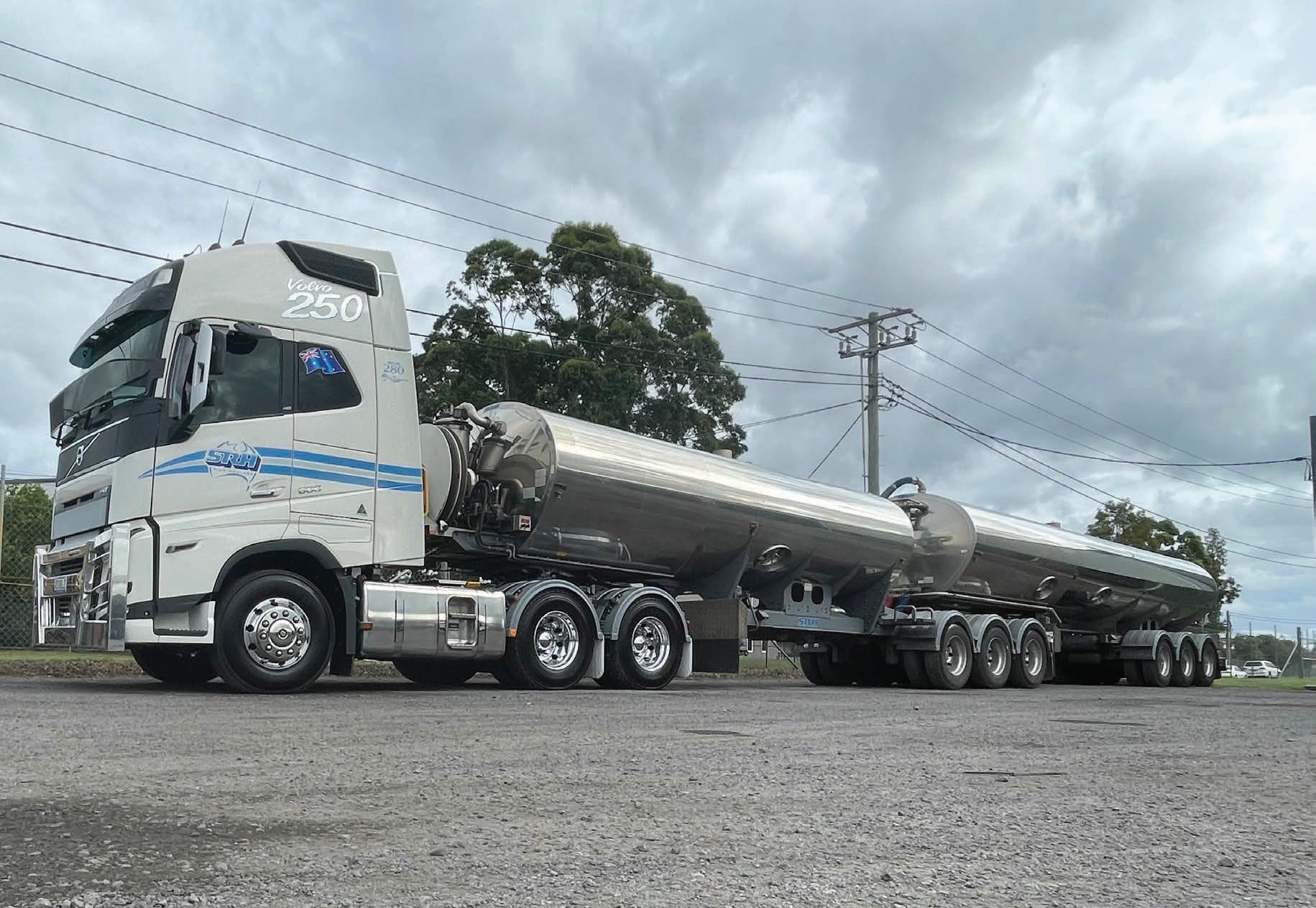
At just 30 years of age, Blair Harvey has spent nearly half of her life in road transport. The notion, when put to her, doesn’t take her by surprise. If an apprenticeship hadn’t fallen through when she was 16 things might be very different. She would likely be a hairdresser. Even at this young age she was intimately acquainted with the family business having gone on milk runs in the truck with her father, Scott Harvey, Founder and Director of SRH Milk Haulage, from the age of ten. Like many privately owned transport enterprises involving both parents, work life and family life often blurred in those early years making it difficult to know where one begun and the other ended. With Scott driving
trucks, Blair’s mother, Regina, handled the bookkeeping.
“Growing up I just thought it was normal that everyone worked all the time,” recalls Blair. “They put their heart and soul into it but also tried to maintain a stable home environment as well.”
Milk cartage, especially farm pickups, remains, even today, a niche segment of the transport industry. This wasn’t lost on Blair as she found her feet, at first working part time after school.
“We were always polishing tanks and trying to keep everything clean,” she recalls. “Dad was very pedantic about stuff like that.”
Were it not for the fact that she had initially set out to do something totally unrelated, it might seem, at least from the
outside, like it was predestined for Blair be absorbed into SRH Milk Haulage. After about a month working part time it was Scott who immediately saw her potential. And it was Regina who reminded him that if Blair was to work full time for the business, she would always take her side and not his. Even so, Scott insisted Blair, if she was to eventually come on board, would have to do the requisite business administration courses, which she completed in Maitland.
One particular memory stands out for Blair as to when she knew she belonged in the industry. It was at a Trucking Australia conference in Sydney. At the time she was 18. She sat down at an empty 12-seater table and wondered if anyone would join her.
PRIME MOVERS & SHAKERS 76 September 2023
“In a matter of ten minutes there were six different people from all different walks of life asking about me,” she recalls.
“In the industry there’s always someone who will strike up a conversation. It was very welcoming.”
Having worked in compliance for five years following on from when national operator work diaries were rolled out, she soon developed an interest in scheduling and allocations which put her in direct contact with the drivers. That lasted for four years before she moved up to Operations Manager, her current position. The role involves working across every depot in the SRH Milk Haulage network, problem solving and tackling new issues as they arise. It also means working, as a bonus, more directly with her dad.
“He’s got all these genius ideas he comes up with that need somebody to put them into action,” Blair jokes. “That’s one way to explain it.”
One of these concepts materialised earlier in the year as the Super Mega Tanker, a 75,000 litre PBS `Super Pocket` milk tanker engineered and built by long-time partner Tieman. Its operating between Bunbury and Perth in Western Australia.

“It’s very interesting to see running,” says Blair. “It definitely turns heads out on
the road.”
The introduction of Performance-Based Standards and its adaptation to the milk cartage sector was a watershed moment for SRH Milk Haulage, who continues to push the envelope for greater payloads with innovative high productivity units. For Blair it’s enjoyable to work alongside her father as he devises the ways and means of adding new combinations to the fleet.
“He loves coming up with different ideas, but he hates the legalities of it all,” she says. “He will order it and it’s then up to everyone to ensure it meets regulations.” Recently, they teamed up to produce a new portable chiller, not surprisingly a crucial piece of equipment in the milk industry. The milk, as it goes through the system, is chilled another two or three degrees lower. When it gets pumped into the tanker, which is insulated and not refrigerated, the temperature is a stable 1.2 degrees Celsius. “The lower we get the milk temperature the better the temperature is maintained inside the tanker,” says Blair. “It’s something totally out of our scope on the transport side but it definitely helps our customers and it’s just another thing Scott sat down and thought through.”
Blair’s life changed three years ago with the birth of her first child. Juggling work, especially an operations role, with a kid is not easy.

“At least with other stuff you can turn off,” she says. “You can’t turn the kid off. They’re always going. I think being in the transport industry makes it tough, too. Especially our operation. We don’t stop. We run 24/7 everywhere. There’s always something happening.”
That said, no career milestone will compare with Maisie, her daughter, who helped her to reassess where she was in life.
“When I told people I was pregnant they said, ‘you will be really good at that because it’s like you babysit everyone now,’” Blair says. “Jokes aside, it’s a job I love doing. No day is the same. It doesn’t matter if you plan for it to be the same every day. Something is different.”
Naturally Blair gets asked if she sees herself taking over the reins of the business in future. It’s something she is open to. Not
that Scott is going anywhere soon. Much of it will depend on timing or more to the point, where everyone is individually placed in their lives. There’s certainly no talk just yet, at least, of any changing of the guard.
“Dad still has a lot more years left in him and a lot on his list of things he wants to achieve before he even considers retiring,” says Blair. “Then we’ll make the best decision, not just for us, but for everyone in the company.”
Blair has already been part of the Australian Truck Association’s Future Leaders program, an annual initiative sponsored by Daimler, an experience she enjoyed immensely. Meeting with likeminded people and talking about challenges and the best ways to overcome them comes naturally to her.
“You realise you are not alone in the industry and that there are many other people trying to achieve goals comparable to your own,” she says. “It’s always good to wrap your brain around something with other people to reach a better solution. Then again, I like fixing things.”
Although she doesn’t deal with drivers on a day-to-day basis anymore, they will often still call her up to see how she is going.
“I get the gossip like a hairdresser from all the truck drivers,” she says. “So, I guess there’s some crossover after all.”
primemovermag.com.au 77
Blair Harvey.
One of the PBS rated road tankers in the SRH Milk Haulage fleet.
RAM INTRODUCES LARAMIE SPORT
Following its booming midyear sales success, RAM Trucks has announced the arrival of the RAM 1500 Laramie Sport. Built off the class-leading Laramie platform, the Sport edition blends a modern intuitive interior with a striking exterior.

The exterior features colour-coded bumpers, grille and mirrors, and newly designed 20-inch alloy wheels. It also comes standard with the innovative and useful RamBox cargo management system on both sides of the tub — ideal for easy access to tools or to fill with ice for a portable esky (bungs included). Inside, the Laramie Sport features black headlining and black carbon fibre-effect dash inserts. A 12-inch Digital Gauge Driver’s Cluster with Full-colour 3D Graphics, Blind Spot Monitoring with Rear Cross-path Detection, Forward Collision Warning with Active Braking (FCW+), 360° Surround View Camera, Parallel/Perpendicular Park Assist, LaneSense Lane Departure Warning-plus, Adaptive Cruise Control, Front and Rear ParkSense Park Assist System, ParkView Rear Back-up Camera
all come as standard safety features. The Laramie Sport is powered by a 5.7-litre V8 HEMI engine, delivering 291kW and 556Nm through a 8-speed gearbox. The powertrain features eTorque technology creating a mild hybrid system which assists the fuelsaving cylinder deactivation and Stop/ Start functions.
RAM Trucks lays claim to the V8 HEMI boasting the best-in-class towing abilities for the RAM 1500 Laramie Sport, with up to 4.5 tonne maximum towing made available.
“Australia’s favourite premium full-size pickup truck now sports a new edition,” says Jeff Barber, RAM Trucks Australia National Manager.
“The 1500 Laramie Sport full-size pickup combines all the benefits of a ute with the comfort, space and premium finishes of a luxury SUV. This unique proposition allows a range of customers to travel business class whether they’re towing, on work sites, on family road trip adventures, or even doing the school run.”
RAM Trucks Australia recently enjoyed a record-breaking end to the financial year
GROWTH PLANS IMPLEMENTED BY B DYNAMIC
Third-party logistics provider, B dynamic Logistics, has created a new role with the aim to broaden its footprint in Australia and explore international expansion opportunities. The Head of Growth position will facilitate projects that include adding more warehouse sites nationally, as well as launching a new proprietary software platform to help track the management of end-to-end logistics, including reverse logistics.

The company have appointed Adam Quinn to the role, who brings with him senior experience in supply chain management and third-party logistics.
Quinn is the grandson of Brian Quinn, considered by many to be retail royalty for his role in designing equipment used to manufacture
ice cream confectionary, including brands Paddle Pop, Calippo and Golden Gaytime.
“Adam’s expertise and industry knowledge will be invaluable as we implement our aggressive growth strategy over the near term,” said B
having recorded a massive 1,172 retail units sold in June, up 85.2 per cent on the same period in 2022. That brought the mid-year tally for 2023 to 4,156 vehicles — an increase of 61.6 per cent over the previous period in 2022.
In the broader 4x4 pickup category, RAM 1500 outsold Jeep Gladiator, Nissan Navara, Volkswagen Amarok and the Toyota Landcruiser crew cab during June. The new Laramie Sport is available from 68 dealer locations nationally, in three colours bright white, diamond black and granite crystal, and is priced from $136,950 RRP.
dynamic Logistic founder and CEO, Mal Siriwardhane.
“Adam will help to raise awareness of our unmatched capabilities and engage with new customers to increase our network and highlight our extraordinary offerings.”
Sydney-based B dynamic Logistics is part of the B dynamic Group of companies which provides services including ecommerce enablement, third-party logistics, warehousing and branded and sustainable packaging. Its client portfolio includes Dymocks, Dettol, ALDI and Costco, is shared between traditional Business to Business and Business to Consumer solutions which are spread across various sectors, including wholesale, retail, mining, construction, technology and healthcare.
DELIVERY NEWS
78 September 2023
RAM 1500 Laramie Sport.
The managerial team at B dynamic.
LANDCRUISER UPGRADED 70 SERIES REVEALED
Toyota has taken the wraps off a significantly upgraded LandCruiser 70 Series.
It will be offered with a four-cylinder turbodiesel engine mated to a six-speed automatic transmission for the first time when it arrives in Australia later this year. In addition to the new powertrain, the upgraded 70 Series brings refreshed styling, a significant increase in safety technology and comfort and convenience features, and an upgraded multimedia system. The new powertrain will be available across the range that includes four body styles and three grades, and will join the V8 turbodiesel/ five-speed manual variants offering customers more choice.
Toyota Australia President Sales, Marketing and Franchise Operations
Sean Hanley said the expanded range and substantial upgrades to the LandCruiser 70 Series demonstrated Toyota’s commitment to continuing to meet the needs of Australian customers.
“The LandCruiser 70 Series has built up a loyal and passionate fanbase with customers drawn to its rugged styling and legendary off-road performance and this substantially upgraded model builds upon those strengths,” said Hanley.

“Now with a new powertrain including an automatic transmission for the first time, along with the significant increase in safety and convenience technology, the LC70 is an ideal vehicle for those working on the land or as a tool of trade and recreational users heading off on an outback adventure,” he said. The new 2.8-litre four-cylinder turbodiesel engine in the LandCruiser generates a maximum power of 150kW at 3400rpm and peak torque of 500Nm between 1600rpm and 2800rpm, 70Nm greater than the existing V8 diesel engine. This engine will be mated exclusively to a six-speed automatic transmission and will be offered in three Single Cab grades - Workmate, GX and GXL - and two grades - Workmate and GXL - for Double Cab, Troop Carrier and Wagon variants.
The proven 4.5-litre V8 turbodiesel generates a maximum power of 151kW at 3400rpm and peak torque of 430Nm from 1200rpm to 3200rpm.
This engine is paired with a five-speed manual gearbox and is offered in the same grades and body styles as the 2.8-litre powertrain with the exception of the Wagon that will only be available in
Visually, the significantly upgraded LandCruiser 70 Series maintains its rugged appearance with a redesigned front end that references the design of the iconic LandCruiser 40 Series. The interior of the vehicle has also undergone a styling refresh to enhance its appeal and accommodate a number of substantial feature upgrades. The instrument cluster and centre console have been redesigned for improved ergonomics, visual ease and practicality including the addition of a 4.2-inch multi information display (MID). The multimedia system has also been upgraded and now features a 6.7-inch touchscreen on all grades that is now compatible with wired Apple CarPlay1 and Android Auto2.
Toyota has also substantially improved the safety technology in the new LandCruiser 70 Series with the addition of lane departure alert, road sign assist (speed signs only) and automatic high beam as part of the Toyota Safety Sense suite of advanced driver assistance features.
Further details and Australian specifications will be released ahead of the Q4 launch of the upgraded Toyota
79
LandCruiser 70 Series has been upgraded by Toyota.
MITSUBISHI AUSTRALIA INTRODUCES NEW-GEN TRITON

Following its global unveil in July, Mitsubishi Motors Australia Limited (MMAL) is introducing the new generation Mitsubishi Triton to the local market. Production of the new Triton for the Australian market will commence in Thailand this December, with expected showroom arrivals due in February 2024. At launch, Double Cap and Club Cab Pickup variants will be available, with Cab-Chassis variants to be added postlaunch.
The new-gen Triton also follows a highly recognisable model structure, offering GLX, GLX+, GLS and GSR grades. “New-gen Triton is such a significant vehicle for Mitsubishi, globally and of course in Australia,” said MMAL CEO, Shaun Westcott. “The new model is a significant step forward in many ways, with its upgraded drivetrain, enhanced load carrying capacity, increased interior comfort and modern day connectivity options.
capability, but is equally at home on the work site, the desert, the beach, the snow or in the city. We cannot wait to bring the Triton to Australian showrooms.”
The new-gen Triton has been redesigned inside and out, using improved materials throughout. The new body reduces drag by 8.1 per cent for enhanced aerodynamics, complemented by a range of newdesign alloy wheels. Two new colours will also debut on the model – blade silver and the GSRonly Yamabuki orange. The new-gen Triton boasts a significantly enhanced, Mitsubishi-designed and developed 2.4-litre Bi-Turbo diesel engine. This power unit employs ‘twin stage’ turbocharging – one small turbocharger for fast response at low revs and a larger one to fortify the top end – to develop 150kW of power with a 470Nm peak torque figure.
Headlining the comprehensive safety suite is a class-first Driver Monitoring System, while rear AEB, Forward Collision Mitigation with pedestrian detection, cyclist detection and junction assist further add to new-gen Triton’s safety credentials.
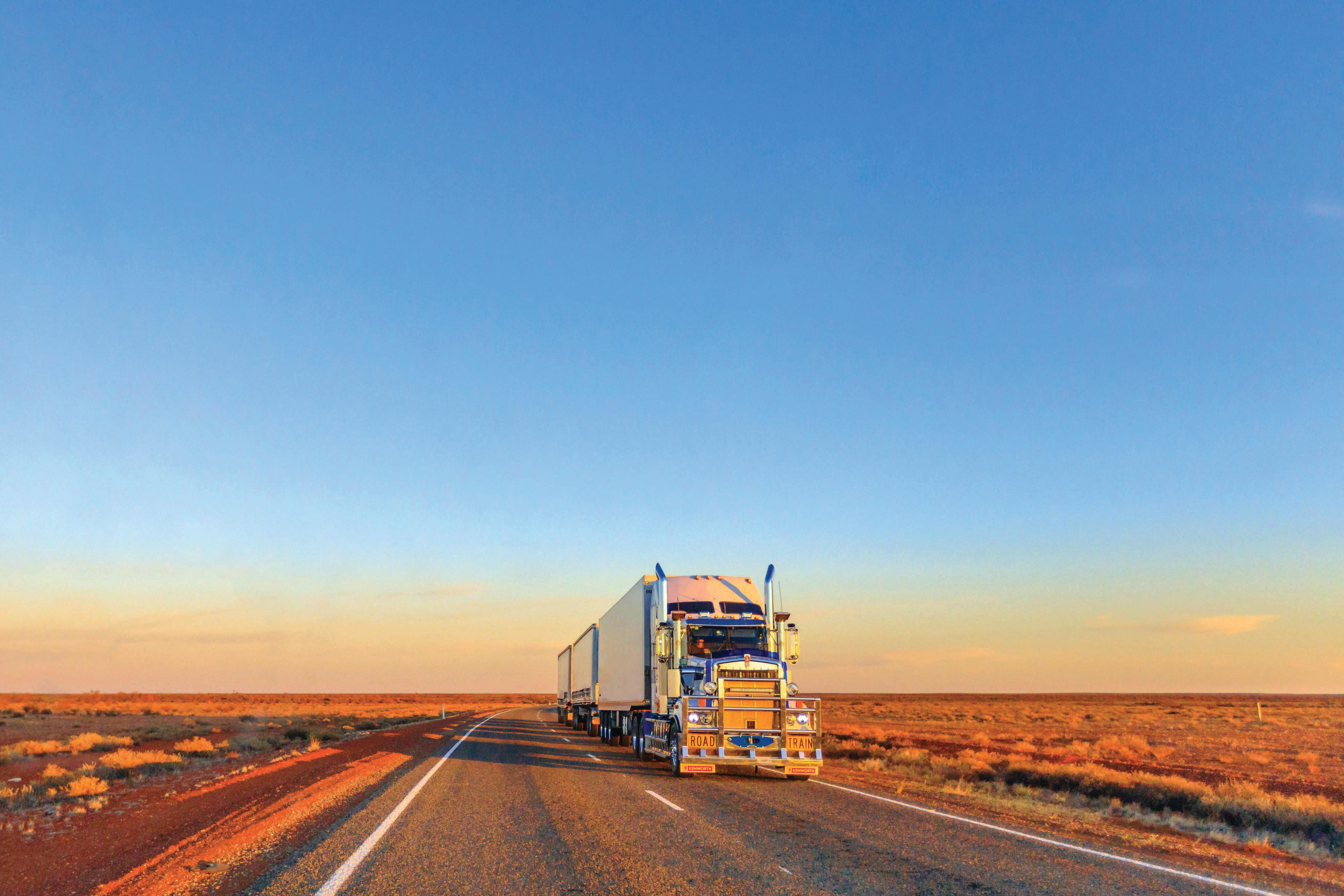
Other key active safety systems available include Active Yaw Control, Adaptive Cruise Control (AT models), front and rear cross traffic alerts, blind spot warning and intervention, and lane departure warning and prevention. For the first time in a Triton, a centre airbag is also included. Inside the cabin, a new 9.0-inch audio display will be offered as standard throughout the range, with a 7.0-inch LCD ‘Meter Cluster’ and integrated satellite navigation including traffic sign recognition further supporting the driver.
Wireless Apple CarPlay as well as Bluetooth connectivity with voice and
80 September 2023
DELIVERY NEWS
New generation Mitsubishi Triton.





YOUR NATIONAL STATION 24/7 Visit us on www.australiantruckradio.com.au Scan and LISTEN NOW For advertising opportunities contact melissa.beutel@primecreative.com.au or call +61 422 103 119
STELLANTIS DEVELOPS SEMICONDUCTOR STRATEGY
As the auto industry’s demand for semiconductors accelerates, Stellantis has recognised the role these components will play in future technology platforms including its BEV-centric intelligent vehicles. Developed by a cross-functional team, the strategy was created through a rigorous assessment of customer desires for advanced technology features and a keen focus on delivering the objectives laid out in the Stellantis Dare Forward 2030 plan. Refined continuously, the strategy includes implementation of a semiconductor database to provide full transparency on the semiconductor content. Additionally, Stellantis will undertake systematic risk assessment to avoid and proactively remove legacy parts; long-term chip level demand forecasting to support capacity securitization agreements with chip makers and Silicon Foundries;
allocation; and, the purchasing of mission-critical parts at chip makers including a long-term securitization of chip supply.
Stellantis has started to engage with strategic semiconductor providers like Infineon, NXP Semiconductors, onsemi, and Qualcomm to further improve its all-new, state-of-the-art STLA platforms and technologies.
In addition, Stellantis is working with aiMotive and SiliconAuto to develop its own differentiating semiconductors in the future.
“An effective semiconductor strategy requires a deep understanding of semiconductors and the semiconductor industry,” said Maxime Picat, Chief Purchasing and Supply Chain Officer at Stellantis.
“We have hundreds of very different semiconductors in our cars. We have built a comprehensive ecosystem to mitigate the risk that one missing chip
key vehicle capabilities directly depend
the range of our electric vehicles while the computation performance of a leading-edge SoC is essential for the customer experience and safety.”



To date, Stellantis has entered into direct agreements for semiconductors with a purchasing value of more than AUD$16.5 billion through 2030. The supply agreements cover a variety of vital microchips.
Semiconductors play key roles in the vehicles that are driving the Stellantis transformation into a sustainable mobility tech company.
This includes enabling features and functions in the BEV-native STLA global platforms (Small/Medium/Large/ Frame) and the seamless connectivity, remote upgradability, and the flexible service-oriented electrical/electronic architecture that underpins the STLA Brain, STLA SmartCockpit, and STLA AutoDrive artificial intelligencepowered platforms.
DELIVERY NEWS 82 September 2023
Fiat Professional Ducato.
WA EV NETWORK SPREADS TO THE KIMBERLEY
in Exmouth, Denham, Derby and Karratha.
The first of eight electric vehicle fast chargers for the Kimberley is now operational in Broome. Located at Town Beach carpark, Horizon Power’s 150-kilowatt fast charger will be followed by an EV charging station in Carnarvon scheduled for next month, while construction has started
The WA EV Network is being delivered by Horizon Power and Synergy, and will include 98 charging stations across 49 locations connecting Perth and regional WA. However, the project, which includes using a combination of solar and battery in remote locations, will have a back-up diesel generator. The WA EV Network is part of the Government’s $43.5 million investment to boost EV infrastructure around WA. Considered vital infrastructure for EV owners given the size of the state, with an average distance between charging stations around 200 kilometres, the network will be the longest in Australia stretching over 7,000 kilometres from Kununurra in the north, to Esperance in the south and east to Eucla. Geraldton and Northampton received the first electric vehicle chargers in April 2023.
RENAULT MASTER cargo carrying powerhouse

WA Energy Minister Bill Johnston said he was delighted that Horizon Power’s first fast charger in the EV Network is now operational in Broome.
“This innovative project is showcasing Horizon Power and Synergy’s commitment to opening Western Australia’s regions to the electric transport ecosystem,” he said.


“Broome’s fast charger is an important step to drive the uptake of electric vehicles in WA and ensuring EV drivers can explore our wonderful State without any range anxiety.”
Acting Climate Action Minister
Tony Buti said the WA EV Network is critical to boosting electric vehicle uptake in WA.
“The Cook Government is committed to preparing the State for the rapid uptake of EVs, creating a more sustainable future and making clean transportation more accessible to communities across WA,” he said.
OVERSEAS MODEL SHOWN
renault.com.au
with up to 17m3 of cargo volume and a choice of configurations, there is a Master Van for any business. plus, with a 100L fuel tank and long service intervals, you can hit the ground running every day. stock available now.
Some 98 charging stations will connect Perth to regional Western Australia.
IF YOU BUILD IT…
Ongoing demand for agriculture, wine, metals and renewables are generally recognised as key driving forces behind a sustained period of growth in South Australia. In February, exports reached a record high of $17 billion, a significant 27 per cent increase compared to the same period last year. Demand from Asian countries, especially Malaysia, which is now the state’s third biggest destination market, rose 40 per cent to $1.33 billion year-on-year. Exports including noteworthy increases to South Korea and the Philippines have helped to drive greater freight movements across the state and the ripple effects are having a positive net effect on the community of small-to-medium enterprises (SME). Currently, the state’s $45 billion small business sector employs over 350,000 people, representing 98 per cent of all businesses in South Australia and almost 40 per cent of the workforce. On top of this more than a quarter of a million people are expected to be added to the state’s total population before the year is out making for an environment that augurs well for a transportation and e-commerce specialist like FedEx, who has anticipated this surge in the market through strategic investment.
“Recognising this impending boom, we at FedEx are helping local businesses tap into these opportunities, by
enhancing our connectivity in South Australia to provide the best possible experience for businesses and customers,” said Peter Langley, FedEx Vice President Australasia. Indeed, South Australia’s total air freight, according to Adelaide Airport, is expected to more than double over the next 20 years to 146,000 tonnes by 2039, with the majority continuing to be in cargo holds of scheduled passenger flights from 2019. It will likely bring more interstate and international visitors into South Australia, as air freight plays a key factor in stabilising passenger services and reaffirming new routes.
FedEx’s new Adelaide South Australia gateway facility is adjacent to the

airport and forms part of a planned Freight and Logistics Hub for the Adelaide Airport East Precinct. It features enhanced sorting and storage capabilities and is supported by state-of-the-art technology. Sitting across 64,000m2 – more than double the size of the previous facilities combined – it’s also equipped with a 435-metre conveyor belt and an advanced automated sorting system that can process up to 10,000 packages per hour.
“The enhanced sorting capacity has helped enable select one-day delivery services to be extended to homes and businesses across metropolitan and regional South Australia,” says Peter. “Locations enjoying faster delivery
LAUNCH PAD 84 September 2023
A newly built Adelaide gateway facility should favourably position FedEx in South Australia, where cross border trade growth is flourishing.
FedEx’s new Adelaide facility.
times include the wine business behemoths of Barossa Valley, Adelaide Hills and Fleurieu Peninsula regions.” With 25 weekly flights in and out of Adelaide Airport, the new facility provides importers and exporters with greater access to other Australian cities and international markets. One of which is India following the signing of the bilateral Economic Cooperation and Trade Agreement (ECTA), effective in December last year.
The strategic move to strengthen diplomatic relations with India, Australia’s sixth-largest trading partner and fourth-largest export market, will have major impacts both nationally and more regionally, with windfalls likely and soon for major industries in South Australia.
Over 85 per cent of Australian goods are now exporting to India tariff-free, this figure is forecast to climb further to 90 per cent by 2030.
According to Peter, the bilateral trade agreement has opened an abundance
of opportunities for growth and trade diversification for Australian businesses, especially SMEs in e-commerce and, not to mention, the export and import sectors.
“SMEs are the lifeblood of the South Australian economy,” says Peter. “Working with the right logistic partner will help unlock more opportunities and access customers in the global marketplace.”

These economic headwinds, according to Peter, will likely bring new markets, reach, and opportunities to Australian businesses.
The ECTA is expected to boom bilateral trade to over $66 billion, up from just under $18 billion in FY 2020–21. Moreover, the Australia-India ECTA is expected to enable Australian businesses access to India’s vast market of over 1.4 billion people — a golden opportunity for trade diversification and for last mile logistics. According to Indian Brand Equity Foundation, India’s e-commerce
industry is projected to surpass the US to become the second largest e-commerce market in the world by 2034. In the 2021 financial year, India had the third largest online shopper base globally, sitting at approximately 150 million. With 5G smartphone shipments reaching 169 million in 2023, this trend is expected to continue with the number of online shoppers expected to grow to a staggering 350 million by 2026 according to Peter. “This rapid growth in e-commerce has seen transportation and logistics companies like FedEx exponentially grow their fulfilment and distribution capabilities across India to meet the growing customer needs as well as invest in their talent pool,” he says. FedEx, having banked on gradual shifts and alignments in consumer economies across the globe, is about to make good on the eventual maturation of e-commerce in Australia even if it takes other regional superpowers to bring it up to speed.
deliverymagazine.com.au 85
Peter Langley..
DARK HORSES
New vehicle sales achieved the highest July result ever recorded. While commercial vehicles didn’t perform as well as they did last year, a particular vehicle in the people mover sector managed to sell almost six times more than it did last year.
The Federal Chamber of Automotive Industries’ (FCAI) latest report on new vehicle sales saw a staggering 96,859 Australian vehicle deliveries during the month of July 2023. This was an increase of 12,398 vehicle sales, or 14.7

per cent, against July 2022. While this is a record-breaking figure for the month of July in the report’s history, comparing figures to the same period the year prior saw certain areas come up short. The heavy commercial vehicle market itself sold a total of 3,456 vehicles in
July 2023, but it didn’t challenge the outcome of July 2022 where 4,028 heavy commercial vehicles were sold. In hindsight, the light commercial market sold a lot more units than the latter with 19,244 sales recorded. Yet it saw 795 les units sold (a 4.0 per cent
HOME RUN 86 September 2023
LDV Deliver 9 led all vans for sales in July.
decrease) compared to 20,039 in July last year.
Nevertheless, FCAI Chief Executive, Tony Weber, says July 2023’s overall result is an indication that the market is continuing to recover from supply shortages resulting from COVID-19 plant shutdowns, microprocessor shortages and logistics and shipping bottlenecks.
“During the past 12 months the issue has been one of securing supply for consumers, however as these pressures ease, we are starting to see a return to more stable market conditions,” he says. “Many of these vehicles were ordered several months ago, so it is important to monitor the broader economic conditions through 2023 and their impact on private and business demand.”
On the other hand, data on people movers looked much more promising. In July 2023, 1,237 units were sold, an extra 95 units (or 8.3 per cent) from the
same period in 2022. To get a clearer idea of the best performers within this market, the FCAI categorised the results into vehicles ‘under $70,000’ and ‘above $70,000’.
For the people movers priced under $70,000, the Kia Carnival recorded the most sales in July 2023 with 964 units — taking up a sizeable 81.4 per cent of the market share. LDV’s Mifa model came in second with 81 units sold to 6.8 per cent of the market, and then the Hyundai Staria with 72 units, equating to 6.1 per cent of people movers under $70,000 sold in July 2023. Volkswagen took up the next three spots on the list with its Multivan (58 units), Caddy (six units) and Caravelle (three units) models. The Honda Odyssey, Hyundai iMAX and LDV G10 Wagon unfortunately all sold zero units in July 2023.
In the people movers above $70,000 sector, Mercedes-Benz took two of the top three spots. Coming in first, the V-Class sold 26 units to almost half of the market at 49.1 per cent. It was followed by the Toyota Granvia at 12 units and 22.6 per cent, and MercedesBenz’s Vito/eVito Tour with six units and 11.3 per cent of sales. A close fourth was the Volkswagen California with five sales (9.4 per cent of the market).
Mercedes-Benz’s EQV and Marco Polo models tied at two units sold to 3.8 per cent of the market each. LDV’s MIFA 9, Mitsubishi’s Express, Mercedez-Benz’s Valente and Sprinter Bus models sold zero units during the month.

The majority of those in need of a van in July 2023 decided to go with a LDV Deliver 9, which clocked up 263 sales. Close behind was the Mercedes Sprinter with 260 sales and the Toyota HiAce with 241 sales. The LDV G10/G10+ models made only two less sales than the Toyota HiAce with a total of 239. This year, the Hyundai Staria Load sold 162 units in July. It didn’t perform as well as July last year, though, where it sold an additional 49.7 per cent – or 326 – units than this year. The same can’t be said for the Fia Ducato, which sold 138 units in July this year compared to just 72 in July last year.
Results for the Ford Transit Custom were the most surprising. Remarkably, the Transit Custom sold 117 units in July 2023 – a massive 485 per cent improvement over July 2022 where only 20 units were sold.
Renault’s Trafic model just missed out on triple digits with 99 units being sold in July 2023. Its Master variant followed in the sub-100 club with 78 units sold, and the Volkswagen Transporter coming in next at 71 units (which barely beat the IVECO C/C (LD) of 70 units). LDV’s V80 van sold 54 units this July, followed by the Volkswagen Crafter with 49 units, Mercedes-Benz’ Vito/eVito Van with 48 units and Peugeot’s Partner with 37 units. Peugeot’s Expert model was similarly popular to the Partner, with 35 models sold to the market. Some 28 Volkswagen Caddy Vans were sold in July, 18 IVECO Van (LD)s, just one Renault Kangoo and zero Hyundai iLOADs.
Uncustomary low sales for some particular models have been reported, no doubt, as their individual marques prepare to launch forthcoming battery electric variants.
Overall, July 2023’s positive results for the industry were distributed around the whole country, as sales across every State and Territory increased during the month compared to July 2022. Sales in the Australian Capital Territory, a haven for government related transportation, increased by 22.4 per cent YTD (1,438 units). New South Wales saw a rise of 11.3 per cent (29,516 units). In Queensland new vehicles sales were 4.3 per cent higher YTD (19,719 units), 17.0 per cent (+6,612 units) in South Australia, and also increased by 33.9 per cent (1,777 units) in Tasmania. In Victoria, the figure was 22.7 per cent higher (27,097 units) YTD. Meanwhile, Western Australia’s was 21.6 per cent up (9,979 units) and Northern Territory saw a 19.4 per cent (903) rise.
Ford Ranger, Toyota HiLux and Isuzu Ute’s D-Max were the three best utility pickups sold in July with the Mazda BT50 and Mitsubishi Triton next best.
deliverymagazine.com.au 87
BIKES AND TRIKES
A recent announcement by an Australian research centre to fund a light electric vehicle (LEV) company has put the spotlight on the industry.
Vehicles Pty Ltd, is a manufacturer and service provider, which lists Australia Post as one of its former clients. The microFleet patent-pending product is called OneDock, which the company claims is the world’s first mechanical and digital technology platform to enable universal micromobility tracking, docking, charging and sharing, whether privately owned or part of a public or corporate fleet. The product aims to address concerns that there are infrastructure limitations within the industry, including a lack of charging stations.
iMove CRC is part of the Australian Government’s Cooperative Research Centres network and is funding the project under its Impact Extension Program which helps Australian companies develop ground-breaking technology, products and services in the transport sector.
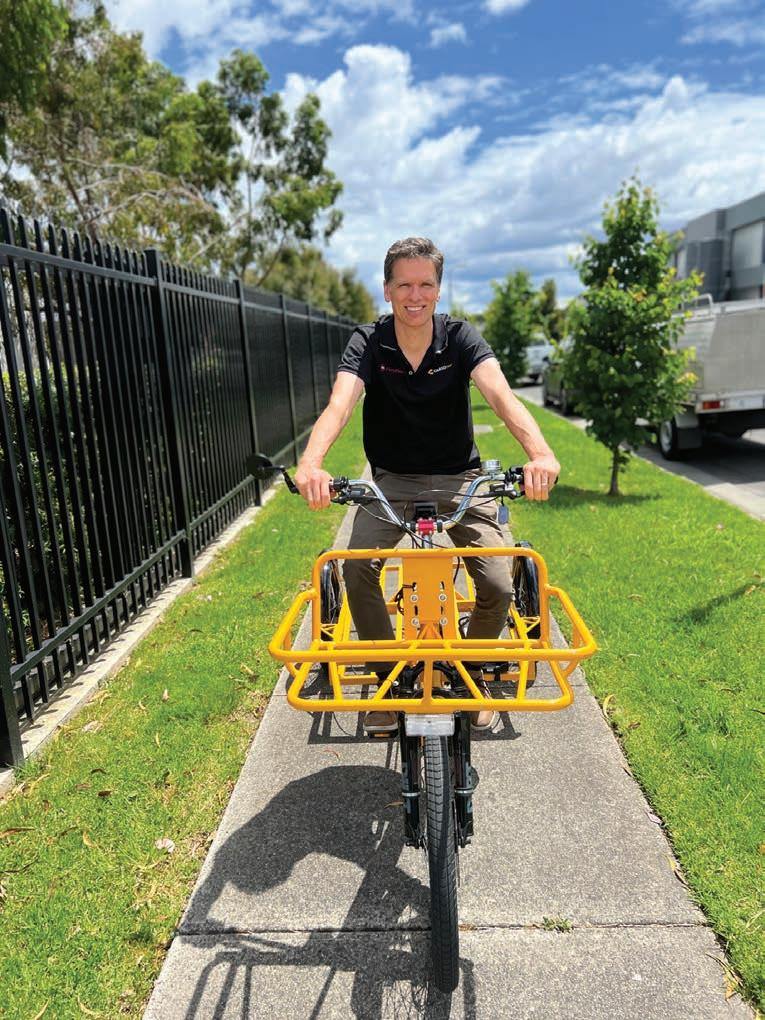
“In a world where the transportation sector is undergoing rapid transformation, driven by both technological advancements and environmental imperatives, solutions like OneDock are not just desirable; they’re essential,” says iMove’s Managing Director, Ian Christensen, who believes the product is exactly what cities need.
microFleet’s lofty goals include installing 100,000 smart docking points in Australia and one million globally by 2030.
LAUNCH PAD 88 September 2023
Scooters, bicycles and buggies powered by
The iMove Cooperative Research Centre is backing start-up company
Al Reid, microFleet Chief Operating Officer.
LEVs are defined as small, lightweight vehicles operating at speeds typically below 25 km/h and driven by a single person. In typically dense urban cities in Asia and Europe, the use of LEVs is becoming more commonplace in the rapidly growing last mile delivery industry, especially when it comes to services such as food, online retail and parcel delivery. Global logistics and delivery companies like UPS, FedEx and Amazon have all begun trialling some form of electric bike or cargo bike for delivery. Locally, Australia Post is involved in ongoing evaluations of ebike technology and presently operates thousands of three-wheel eDVs for the range of benefits they offer posties, customers and the environment.
Given the advances in technology surrounding batteries and electric motors, LEVs are now cheaper and more reliable than ever. According to Allied Market Research’s most recent figures, the global micro-mobility market was valued at $44.12 billion in 2020, and is projected to reach $214.57 billion by 2030, registering a compound annual growth rate of 17.4 per cent from 2021 to 2030.
Meanwhile, with last mile delivery rapidly increasing due to a booming e-commerce scene and postpandemic retail habits, industry
pundits are predicting the biggest market for micro-mobility will end up being in the commercial space. The last mile delivery market size is expected to hit $123 billion by 2030, a compound annual growth rate of 13.2 per cent. This leaves many concerned about the number of trucks and vans taking up urban road space and the emissions that go along with them. Aside from the environmental benefits, other advantages to LEVs are that they are small enough to bypass traffic congestion and can also make an estimated two times more stops per hour than a mainstream delivery vehicle. Also, unlike many autonomous delivery vehicles, the full technology is available now.
All of these factors can present a competitive advantage for businesses that want to reduce costs in the last mile, which is generally the most inefficient and costly part of the delivery chain.
A number of recent innovative products, as well as global partnerships, intimate that LEVs are the way forward.
ONOMOTION, a Berlin-based company, have recently launched what they call the ONO – a delivery-focused, LEV that is a cross between an e-bike and a microcar. What this company is specifically trying to address is
exposure to the elements, something that is a drawback for e-bikes, especially in colder climates. The ONO is being used in Germany by UPS among other delivery companies.
“When we started ONO, the goal was to create a truly purpose-built, emissionfree cargo-bike solution for last mile logistics” says the company’s CoCEO, Beres Seelbach. ONOMOTION has now upgraded its product to include a more adaptable container module, allowing customers to adjust their container to better perform jobspecific tasks. It provides options for better cargo organisation including clothing racks and integrated shelving solutions. Here in Australia, Australia Post has proven itself as one of the country’s biggest investors in LEVs. It currently has more than 4,000 electric delivery vehicles and electric bikes in its fleet making it the largest operator of electric vehicles in the country. Its goal is to have a fully electric fleet by 2030.

Sydney-based e-bike innovator and electric fleet specialists Zoomo has long had a presence in the UK and continental European markets with customers including Gorillas, Uber and Just Eat. Last month it announced a partnership with UK electric delivery bike manufacturer EAV, which produces some of the largest light vehicles on the market with a cargo volume of 2,000 litres and 150-kilogram payload. Zoomo will become EAV’s official fleet partner and suit the needs of the growing urban logistics delivery sector.
“We are bringing the vehicle leasing model from the automotive space to light electric vehicles,” says Co-Founder and CRO of Zoomo, Michael Johnson.
“By integrating different vehicle types into our platform, like EAV e-cargo bikes, with leasing, servicing and telematically enabled software solutions, we are able to provide customers in urban logistics with a one-stop solution for all their delivery fleet needs.”
deliverymagazine.com.au 89
microFleet’s patent-pending OneDock.
In the late 1990s the Australian Government adopted a policy of harmonising the Australian Design Rules (ADRs) with the United Nations ECE (UNECE) model regulations.
The ADRs date from the 1970s when Australian States and Territories recognised the need for national vehicle standards. The current ADR regulatory structure started on 1 July 1989.

The first Australian design rules were based upon the USA FMVSS technical requirements. This reflected the historic ‘pedigree’ of truck and trailer supply in Australia. Since 5 April 2000 when Australia joined the UNECE world forum for the harmonisation of vehicle standards, the trajectory of ADR development has been towards the ‘Eurocentric’ UNECE model regulations. It should not be surprising that European truck suppliers have achieved increased market share in Australia since that date.
The UNECE regulations have ‘pushed the boundaries’ with new safety technologies and the European suppliers have developed their vehicles to comply with the UNECE regulations.
The international agreements that underpin the development of ‘world vehicle regulations’ date from 1958. It was initially established to promote uniform vehicle technical standards in Europe and to facilitate vehicles moving freely across European borders. Hence the acronym ECE means Economic Commission for Europe.
Australia’s program of adopting the UN ECE Regulations
In the 1990s these regulations gained international significance. The World Trade Organization (WTO) rules promote adoption of international technical standards. A trading nation such as Australia is vulnerable to legal challenge if it imposes national technical standards without providing an acceptance path for compliance with international standards, such as the UN ECE model vehicle regulations. Hence it was imperative for Australia to join this project.
I used the term ‘Eurocentric’ previously because of the history of this process. For the past 30 years or so the UNECE has been developing global model regulations but the North American countries –USA, Canada and Mexico were not participants. The USA and Canada do not have a ‘type approval’ vehicle system. The governments in these countries do not issue vehicle manufacturers with approvals to market vehicle models.
The UNECE regulations are structured for type approval. To overcome this impediment for the USA and Canada, a series of Global Technical Regulations have been developed. These are technical standards that could be implemented by any country irrespective of the regulatory structure. The GTRs need not be based upon the UNECE Regulations, but often are. Development of the GTRs has been very slow because some requirements are contested between north American and European interests. There are currently 24 released GTRs. In contrast there are about 167 UNECE model regulations.
Australia has a successful truck and trailer manufacturing sector because of its ability to innovate, build quality equipment and to supply niches that have been opened by liberalisation of
length and configuration rules. Price is not the key success factor in the heavyduty Australian market. Safety and driver comfort is growing in importance here. This is a domain that European truck designers have been leading.
The UNECE process can lead to an approval certificate relevant to a particular regulations for a component or vehicle. For example, a seat manufacturer in the USA could obtain approval UNECE certificates for Regulations 14, 16 and 17 issued by a European authority based upon tests conducted in the manufacturer’s laboratory that were witnessed by an accredited test authority. These certificates open the market for the USA seat manufacturer into international markets. The UNECE-approved certificates provide the path for international acceptance because participating countries have agreed to accept them.
The Tables show the Australian Design Rules that have been harmonised fully or partly with the UNECE model regulations for heavy freight vehicles only (categories NB2, NC and TD). The project is near complete. Some ADRS do not have a path via a UNECE Regulation because they are mainly specific to Australia (for example B-double and roadtrain related). Some ADRs are not harmonised, or allow alternate standards, because the Australian heavy vehicle sector has practices and vehicle types that are not found in Europe (such as the brake rules). Some ADRs have been harmonised but provide alternate paths to allow ‘traditional’ Australian truck practices, such as flat mirrors.
The Australia Regulator for new vehicles is the transport division within the Department of Infrastructure, Transport,
90 december 2018 INSTITUTE
September 2023
PETER HART
Regional Development, Communications and the Arts (DITRDCA). Before additional design regulations are applied to new vehicle suppliers, the Australian Government will usually consult with industry and produce a regulation impact statement (RIS). More onerous regulations must be studied, explained and justified in the RIS. The process involves identification of alternatives to the regulation, costs and benefits. Producing a RIS is a detailed process that can take 24 months or more. The quality of the Regulation Impact Statement must be ‘approved’ by the Federal Government’s Office of Impact Analysis. Ultimately a minister will decide to accept or reject the proposal. New or amended design rules are often introduced with a two-or three-year lead time. Typically, the new requirements are applied to ‘new models’ (that is new applications in ROVER) before they apply to existing models. Development of a new Australian Design Rule is a five-year project.
So what is new from the UNECE and what might be adopted in Australia?
There are currently 167 released UN ECEC model regulations and Australia has only adopted/harmonised with about a quarter of them. At present the Federal Regulator is negotiating with industry to allow 2.55m wide new vehicles as are allowed in Europe. There will be additional safety requirements applied to these vehicles and they will be based upon UNECE regulations. The UNECE does the hard work of
developing technical regulations for road (and agricultural) vehicles. Australia is a participant in the process, as it should be. Australia is the world leader in allowing long and heavy vehicles onto metropolitan roads and the UNECE has a lot to learn from Australia’s experience. Australia will often vary the regulations to provide for local requirements.
My assessment of the regulations that could possibly be adopted in Australia applicable to heavy-duty vehicles are shown in Box 1. There are many potentially important developments in this list.
Dr Peter Hart, ARTSA-i Life Member
Box 1 - UNECE Regulations that could be adopted for Australian heavy vehicles:
1. Regulation 10 Electromagnetic Compatibility.
2. Regulation 34 Fire Risks/Fuel Systems.
3. Regulation 100 Electric Power Trained Vehicles.
4. Regulation 101 CO2 Emission/Fuel consumption.
5. Regulation 104 Retro-Reflective Markings.
6. Regulation 118 Fire Resistance of Interior Materials.
7. Regulation 121 Identification of Controls, Tell-tales and Indicators.
8. Regulation 130 Lane Departure Warning Systems (LDWS).
9. Regulation 131 Advanced Emergency Braking Systems (AEBS).
10. Regulation 134 Safety and Related Performance of Hydrogen-fuelled vehicles (HFCF).
11. Regulation 138 Quiet Road Transport Vehicles with Regard to Reduced Audibility.
12. Regulation 141 Tyre Pressure Monitoring Systems.
13. Regulation 144 Accident Emergency Call Systems (AECS).
14. Regulation 151 – Blind Spot Information System for the Detection of Bicycles.
15. Regulation 153 – Fuel System Integrity and Electric Powertrain Safety for RearEnd Collisions.
16. Regulation 155 – Cyber Security and Cyber Security Management Systems.
17. Regulation 156 Software Update and Software Update Management Systems.
18. Regulation 157 – Automated Lane Keeping Systems (ALKS).
19. Regulation 158 – Devices for Means of Rear Visibility or Detection.
20. Regulation 159 – Moving Odd Information System (MOIS).
21. Regulation 160 – Event Data Recorder (EDR).
22. Regulation 161 – Devices Against Unauthorized Use
23. Regulation 163 – Vehicle Alarm Systems.
24. Regulation 165 – Reverse Warnings.
25. Regulation 166 – Vulnerable Users in Front and Side Close Proximity.
26. Regulation 167 – Approval of Motor Vehicles with Regard to Their Direct Vision.
27. GTR 5 – On-board diagnostic systems (OBD) for road vehicles.
28. Other work is ongoing, such as battery durability requirements for electric heavy-duty vehicles.

primemovermag.com.au 91 ARTSA-I LIFE MEMBERS
Powered by
news COMMERCIAL ROAD TRANSPORT Categories NB2, NC, TD onlyADR base number Total Applicable ADRs that are based upon a UNECE Regulation 1/00 (R23), 3/04 (R17), 4/04 (R16), 5/06 (R14), 6/00 (R6), 8/01 (R43), 13/00 (R48), 14/02 (R46), 18/03 (R39), 46/00 (R8), 47/00 (R3), 48/00 (R4), 49/00 (R7), 50/00 (R19), 51/00 (R37), 52/00 (R38), 74/00 (R91), 83/00 (R51), 84/00 (93), 90/00 (R79), 92/00 (R26), 93/00 (R125), 94/00 (R28), 97/00 (R131), 108 (R158), 25 Applicable ADRs that have an UNECE Regulation as an alternate (non-exclusive) path. 30/01 (R24), 35/06 (R13), 38/05 (R13), 62/02 (R55), 80/04 (R83), 96/00 (R54) 6 Applicable ADRs with no UNECE Regulation path 42/05, 43/04, 44/02, 45/01, 61/03, 63/00, 64/00, 65/00. 8
In the Truck Industry Council (TIC) Prime Mover columns this year I have commented on the steps necessary for the road freight transport sector to achieve the zero emission targets set by Government by the critical dates of 2030 and 2050. Throughout this year decarbonising road transport has increasingly been the subject of discussion between Federal and State Governments and the Truck Industry Council. TIC members are best placed to be able to provide the technical insight necessary and working with their customers help Governments achieve their carbon emission targets in what is recognised as a hard to abate sector. The key message that TIC has been advocating to Government is that while ambition is apt when tackling the challenges of climate change, policy discussion and determination must reflect reality that is, policy needs to reflect what is technically possible. TIC has promoted the position that, as it stands today, there is no single technology capable of achieving carbon neutrality across the heavy vehicle road freight sector; technology agnosticism being the order of the day, attempting to pick and back the winning technology is a brave undertaking. All truck OEMs are working on technologies to solve the challenge. Various technologies will need to be considered depending on the task at hand for the truck and a realistic transition plan and timeline for the road freight sector put in place that aligns
Working together for a national goal
with Government, industry and public expectations. It is with this positioning in mind that TIC has taken another step forward and commenced working with the Australian Manufacturing Workers’ Union (AMWU) on a national tripartite coordinating body for Australia’s evolution to a zero emission future. The first roundtable meeting being held in June.
The objective is to work with the Federal Government to develop Australia’s zero emission vehicle industry manufacturing capability taking the necessary action to upskill existing workers and plan, create and deliver the new jobs of the future. In 2023, Australia has a strong heavy vehicle manufacturing presence and has so for the last 50 years with Volvo Group Australia and PACCAR; makers of Volvo, Mack, and Kenworth, DAF trucks respectively, gearing up for the manufacture of future truck technologies. More recently, since 2017 SEA Electric has commenced manufacturing electric trucks in Australia. Some 6,000 heavy vehicle trucks were built in Australia last year. That was almost 50 per cent of all new heavy truck sales. The most important feature of these trucks is that they are customised to suit the operator’s specific needs and Australia’s unique conditions: heat; dust, weights, and long distances. Many TIC members also provide local customisation to their imported products. Customised truck builds will have increased importance for many earlier adopters in the low and zero emission freight sector, with trucks designed and built to perform specific tasks. This manufacturing presence and customisation capability is complemented by secondary
manufacturers who are a vital component of the truck market in Australia with 95 per cent of heavy vehicles sold in Australia requiring secondary manufacturer before being able to be registered and put into service on our roads.
At the conclusion of this roundtable discussion, industry and the AMWU agreed on the recommendation that Government should establish a net zero transition roadmap for the heavy vehicle industry. This transition plan would review regulation and standards to deliver a harmonised approach between the Federal and State Governments; identify the different levers available to Government to support decarbonisation and the objective of net zero emissions; support the growth of local primary and secondary manufacturing opportunities including enhancing existing as well as creating new jobs; and promote a fleet modernisation strategy for the heavy vehicle sector. The latter action of modernising the very old, by world standards, Australian truck fleet in particular, is welcome news to the Truck Industry Council given its sustained advocacy on this issue over time, across various elected administrations and noting the significant safety, environmental and productivity benefits accrued to operators and the Australian public from such a move. All of these actions being a strong starting point in an approach reminiscent of past tripartite agreements where the stakeholders involved chose to work together to achieve a national goal.
Tony McMullan CEO, Truck Industry Council

INSIGHT | TRUCK INDUSTRY COUNCIL 92 September 2023
As we move closer towards legislation being tabled for consideration by federal parliamentarians in relation to mimumum standards in road transport later this year, its important to outline the position of the Australian Road Transport Industrial Organisation (ARTIO), of which the Victorian Transport Association is a member, and of which I am grateful to be National Secretary. The issue has been especially prominent this year with delegations of industry groups visiting Canberra for important discussions, ahead of a vote later this year.
In June 2023, ARTIO and the Transport Workers Union (TWU) collaborated to establish guidelines and a framework for a specialised representative body within the Fair Work Commission. This body aims to oversee and enforce structured accountability in the road freight industry, ensuring fair and equitable workplace conditions where specific jurisdiction or processes were lacking. The road transport industry plays a crucial role in Australia’s economic future and the safety of all road users.
As a price-taking industry operating on slim margins and tight timelines, it faces challenges with unfair commercial influences and pressures that compromise business viability and lead to deadly consequences for transport workers and road users. The industry is inherently dangerous and responsible for more workplace deaths and bankruptcies than
The case for minimum standards in road transport
any other sector, making it imperative to address these issues.
Transport operations heavily depend on entities with economic and market power, particularly at the top of supply chains and contractual networks. The economic arrangements imposed by these entities determine the standards that apply to transport operators and workers, significantly impacting the industry’s viability and sustainability.
Given the emergence of “gig” type arrangements that exacerbate the decline in standards and business viability, ARTIO emphasises the need for enforceable standards and proactive dispute resolution mechanisms to protect all transport workers, regardless of their legal classification.
To achieve greater safety, fairness, and sustainability for transport operators and workers in Australia, ARTIO proposes the establishment of a Road Transport Division addressing Minimum Standards within the Fair Work Commission.
The framework for the Road Transport Division is built upon several key pillars, including:
Objectives: The Division’s primary objectives are to apply fair, reasonable, and enforceable standards throughout transport industry supply chains, ensure that supply chain participants with economic power are responsible for maintaining safe and fair networks, and promote the safety, sustainability, and viability of the road transport industry.
Coverage: The Division will have jurisdiction over all supply chain participants, including consignors, consignees, clients, transport operators (both employees and non-employees), and anyone involved in facilitating road transport.
Standard Setting Instruments: The Division will oversee standard setting
instruments, including Modern Awards (to be reviewed and transformed into Road Transport Awards), Road Transport Worker Determinations (containing minimum standards for non-employee transport workers), and Road Transport Supply Chain Determinations.
Facilitation of Bargaining: The Division will have the power to facilitate bargaining between various parties in the road transport industry, including employees and employers, carriers and principal contractors, and those engaging both employees and carriers.
Agreements: Three types of agreements will be established including Enterprise Agreements (pre-existing agreements covering the road transport industry), Road Transport Agreements (new agreements between employees and employers or carriers and principal contractors), and Supply Chain Agreements (setting minimum standards for supply chain participants).
Road Transport Advisory Group: The Division may form a Road Transport Advisory Group consisting of relevant Registered Organisations to provide expert advice and recommendations on specific matters.

ARTIO is committed to working with all stakeholders to enhance the viability, safety, sustainability, and efficiency of the road transport industry amid increasing demands on current processes and operations.
By establishing and maintaining enforceable standards through this framework, the road transport industry in Australia aims to ensure the well-being of its workers, promote fairness, and safeguard its critical role in the country’s economic landscape.
Peter Anderson CEO, VTA

Powered by news COMMERCIAL ROAD TRANSPORT VICTORIAN TRANSPORT ASSOCIATION | INSIGHT
STUART ST CLAIR
PETER ANDERSON
primemovermag.com.au 93
Penny Arcades
industry slowed from the heady rush experienced for more than the past 18 months or so. June was a bigger month than usual as manufacturers, dealers and customers did their best to cash in on the last days of the instant asset tax write off scheme, and the record 5,405 new trucks in June was never going to be maintained into July. However, although the July total of 2,732 cab-chassis and prime mover units was 49 per cent less than during the previous month, compared to July last year, it was only ten per cent down on July 2022.
The YTD total of 24,213 (+13 per cent) indicated a healthy result can still be expected for the rest of this year despite some easing of demand over the coming months. The Light Duty truck segment was the weakest performer in July, slowing considerably to 1,064 units, which was 350 less than in the same month of 2022 (-24.7 per cent). Due to the foundation delivered during the first six months of this year, the YTD result of 9,075 units shows a growth of 8.5 per cent over the same period but this is likely to be further whittled away by this years’ end.
The trend exhibited by the Medium Duty sector so far this year was maintained during July with 563 sales for the month, just 1.3 per cent more than during July 2022. Again, the solid results for much of the first half of 2023 have kept the sector a nose in front with the 4,534 units at the end of July showing a YTD growth of 3.7 per cent (+161 units). Following on from two record quarters, the Heavy Duty segment remained particularly strong in July with 1,105 new units which shows an increase of 3.6 per cent (38 units) over July 2022. The YTD accrual of 9,837 units at the end of July includes an additional 1,854 Heavy Duty trucks compared with the first seven months of 2022, a gain of 23.2 per cent.

The van sector continues to crawl back after being affected by supply issues which were exacerbated during the COVID period when manufacturers suffered from availability of many key components. The July total of 449 units shows 14 less vans than in July 2022 (-1.8 per cent). The YTD total of 3,363 new van units includes an additional 413 over the 2022 results for the same period (+14.0 per cent).
The Government and the Reserve Bank of Australia have continued to promote the theory of low-level inflation as being good for the
economy, with interest rates being the biggest lever the RBA can pull to apply the brakes necessary to meet the goal of low inflation without leading to negative growth, otherwise known as recession. Most Western economies are dealing with this same problem, so Australia is unable to go it alone as international factors have effects here as well. Interest rate changes may take more than six months to have an identifiable effect on the overall economy, which can be similar to the supply of transport vehicles and the often, extensive time lag between order and delivery.
Jul-23YTDChange
PETER SHIELDS’ NUMBER CRUNCH 94 September 2023
ISUZU 1009810813.7% HINO 325 3491-9.1% FUSO 314 301210.0% VOLVO 180 199467.0% KENWORTH 217 197621.2% IVECO 88 909 24.4% MERCEDES-BENZ 104 873 10.4% SCANIA 81 706 21.1% UD TRUCKS 80 690 8.2% MACK 71 604 37.0% DAF 73 500 60.8% FIAT 73 427 54.2% FREIGHTLINER 26 235 -15.5% HYUNDAI 19 185 9.5% MAN 33 171 -24.7% WESTERN STAR 5 95 -42.4% RENAULT 3 77 -53.9% VOLKSWAGEN 4 65 35.4% FOTON MOBILITY 17 38 N/A DENNIS EAGLE 10 37 54.2% FORD 0 10 -71.4% SEA ELECTRIC 0 10 42.9% CABCHASSIS/PRIME27322421313.0% M-B VANS 231 154635.4% VOLKSWAGEN VANS 45 682 75.8% RENAULT VANS 75 419 -49.4% FIAT VANS 61 302 153.8% IVECO VANS 27 297 64.1% FORD VANS 10 117 -59.9% VANS 449 336314.0% TOTAL31812757613.1%






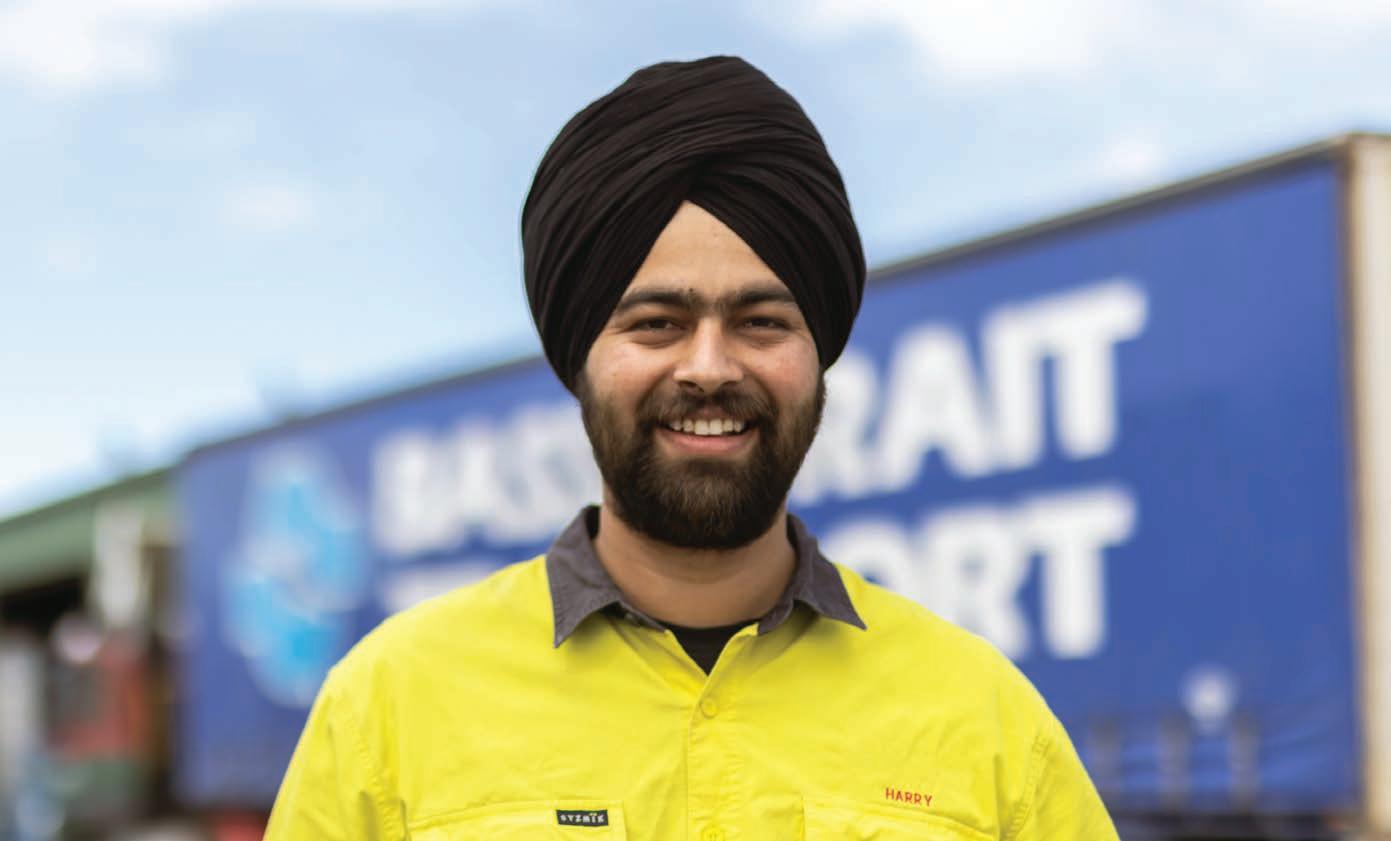
FSA/ISZS1660 TWU Nominees Pty Ltd, ABN 67 002 835 412, AFSL 239163, is the trustee of TWUSUPER ABN 77 343 563 307 and the issuer of interests in it. TWUS 7267 Strong long-term performance Transport ready insurance Service tailored for transport workers Join the super fund for people who work in transport Behind everything you do, are transport workers - delivering our food, fuel and online shopping, as well as taking us to school, work and on holidays. And behind them is TWUSUPER, the industry super fund for the people who keep the country running.
Australia
Prepared and issued by TWU Nominees Pty Ltd ABN 67 002 835 412, Australian Financial Services Licence No. 239163 (‘Trustee’) on 18/08/2023 as trustee of TWUSUPER ABN 77 343 563 307 (‘TWUSUPER’ or ‘the Fund’) and the issuer of interests in it. Before making any decision to invest you should consider the PDS and TMD which are available at twusuper.com.au. * Past performance is not a reliable indicator of future performance and should never be the sole factor considered when selecting a fund. TWUS 8988
Behind the people who keep
moving
LESS FUEL, MORE PERFORMANCE WITH SHELL RIMULA ULTRA


Shell Rimula ULTRA works harder to reduce your costs, with up to 2% increase in fuel economy*, so you stay on the road for longer.

Heavy Duty Diesel Engine Oil

*Compared with a typical 10W-40 oil over a 100,000 km oil drain interval. Scan here to find out more


















































































































































































































































































































































































































































































































































































































































































































